Benefits and challenges of Building Information Modeling
VerifiedAdded on 2022/12/27
|57
|18243
|1
AI Summary
This document explores the benefits and challenges of Building Information Modeling (BIM) in the construction industry. It provides an overview of the concept of BIM, its main benefits, and the challenges faced by organizations. The document includes a case study on Kier Group plc, a UK construction company.
Contribute Materials
Your contribution can guide someone’s learning journey. Share your
documents today.
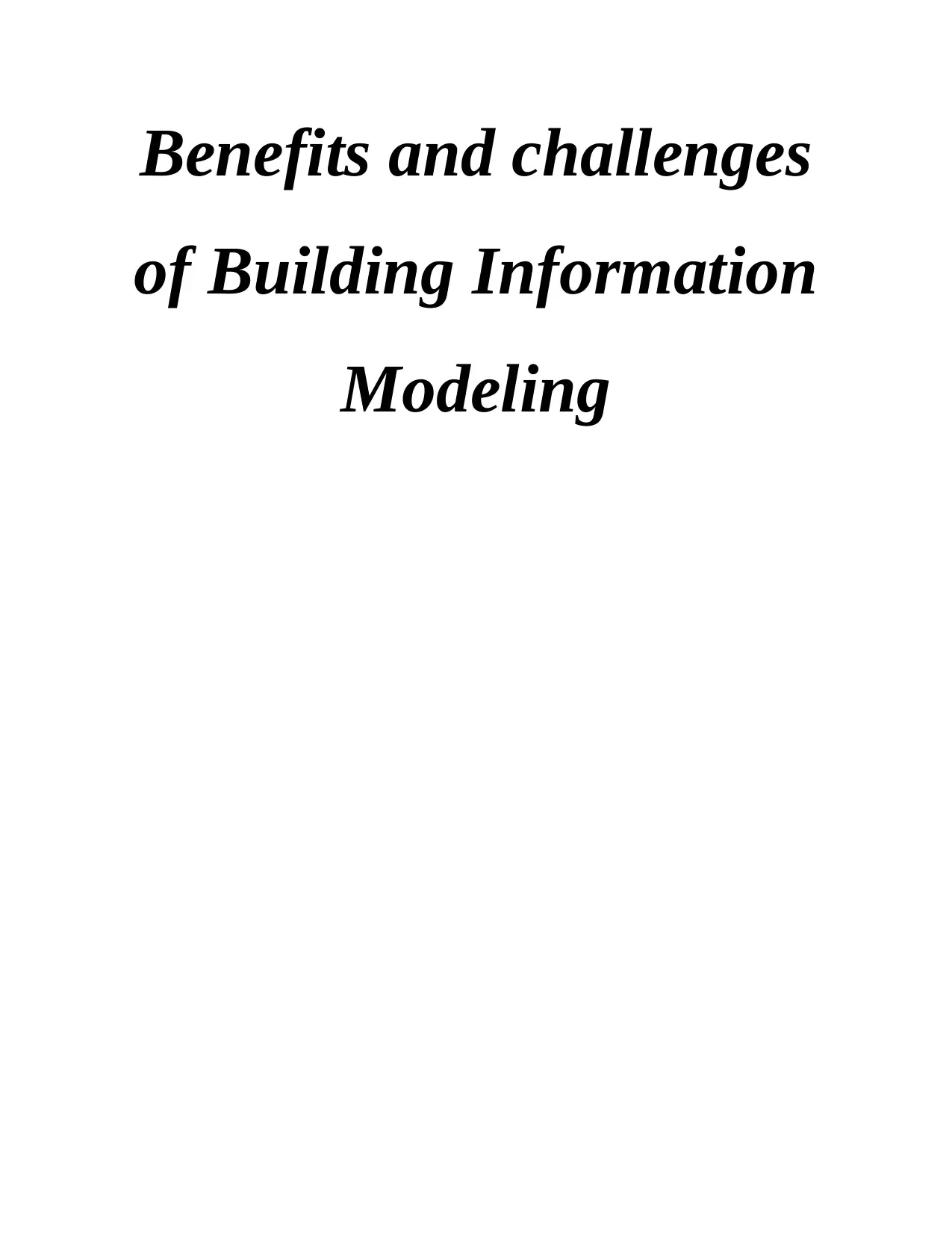
Benefits and challenges
of Building Information
Modeling
of Building Information
Modeling
Secure Best Marks with AI Grader
Need help grading? Try our AI Grader for instant feedback on your assignments.
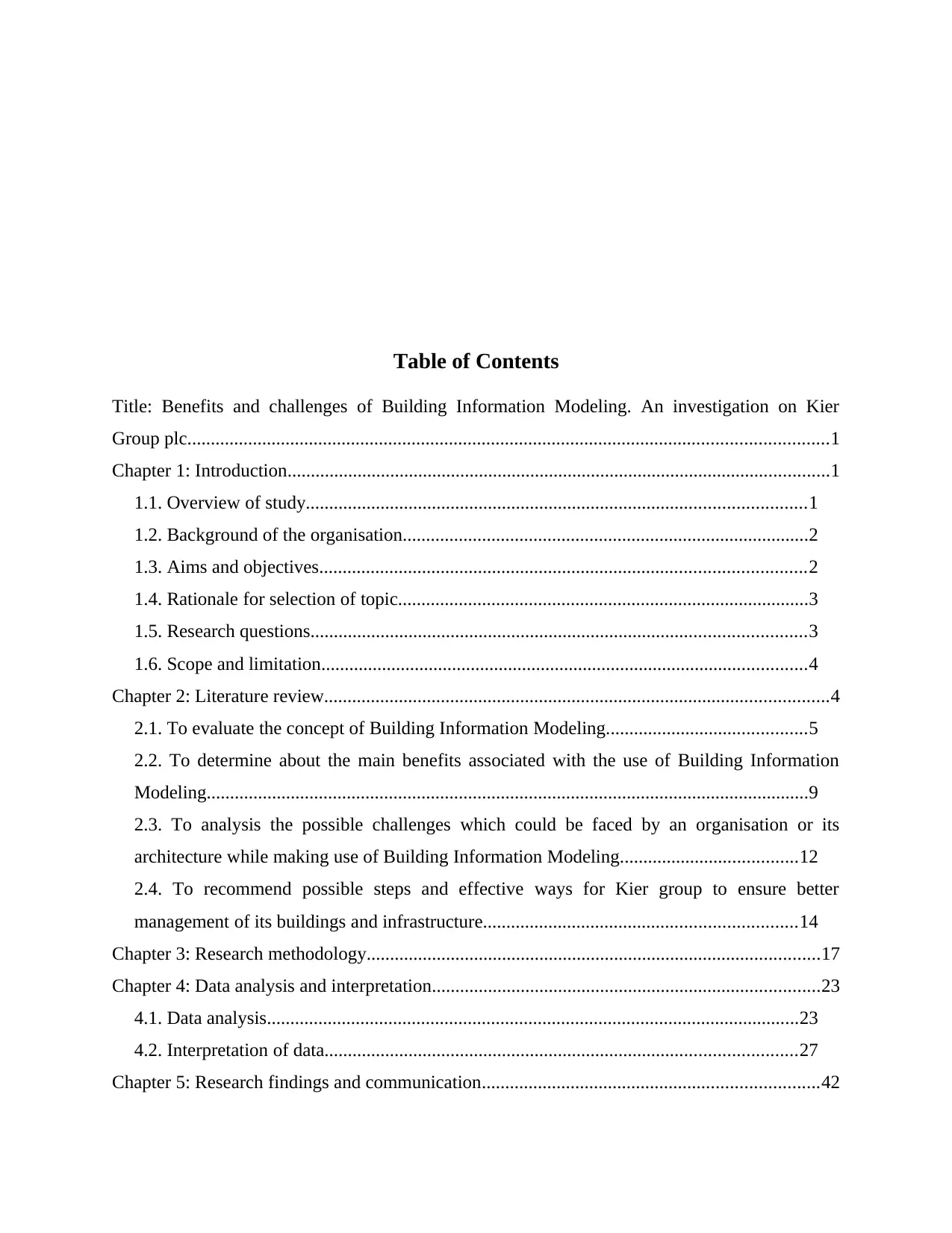
Table of Contents
Title: Benefits and challenges of Building Information Modeling. An investigation on Kier
Group plc.........................................................................................................................................1
Chapter 1: Introduction....................................................................................................................1
1.1. Overview of study...........................................................................................................1
1.2. Background of the organisation.......................................................................................2
1.3. Aims and objectives........................................................................................................2
1.4. Rationale for selection of topic........................................................................................3
1.5. Research questions..........................................................................................................3
1.6. Scope and limitation........................................................................................................4
Chapter 2: Literature review............................................................................................................4
2.1. To evaluate the concept of Building Information Modeling...........................................5
2.2. To determine about the main benefits associated with the use of Building Information
Modeling.................................................................................................................................9
2.3. To analysis the possible challenges which could be faced by an organisation or its
architecture while making use of Building Information Modeling......................................12
2.4. To recommend possible steps and effective ways for Kier group to ensure better
management of its buildings and infrastructure...................................................................14
Chapter 3: Research methodology.................................................................................................17
Chapter 4: Data analysis and interpretation...................................................................................23
4.1. Data analysis..................................................................................................................23
4.2. Interpretation of data.....................................................................................................27
Chapter 5: Research findings and communication........................................................................42
Title: Benefits and challenges of Building Information Modeling. An investigation on Kier
Group plc.........................................................................................................................................1
Chapter 1: Introduction....................................................................................................................1
1.1. Overview of study...........................................................................................................1
1.2. Background of the organisation.......................................................................................2
1.3. Aims and objectives........................................................................................................2
1.4. Rationale for selection of topic........................................................................................3
1.5. Research questions..........................................................................................................3
1.6. Scope and limitation........................................................................................................4
Chapter 2: Literature review............................................................................................................4
2.1. To evaluate the concept of Building Information Modeling...........................................5
2.2. To determine about the main benefits associated with the use of Building Information
Modeling.................................................................................................................................9
2.3. To analysis the possible challenges which could be faced by an organisation or its
architecture while making use of Building Information Modeling......................................12
2.4. To recommend possible steps and effective ways for Kier group to ensure better
management of its buildings and infrastructure...................................................................14
Chapter 3: Research methodology.................................................................................................17
Chapter 4: Data analysis and interpretation...................................................................................23
4.1. Data analysis..................................................................................................................23
4.2. Interpretation of data.....................................................................................................27
Chapter 5: Research findings and communication........................................................................42
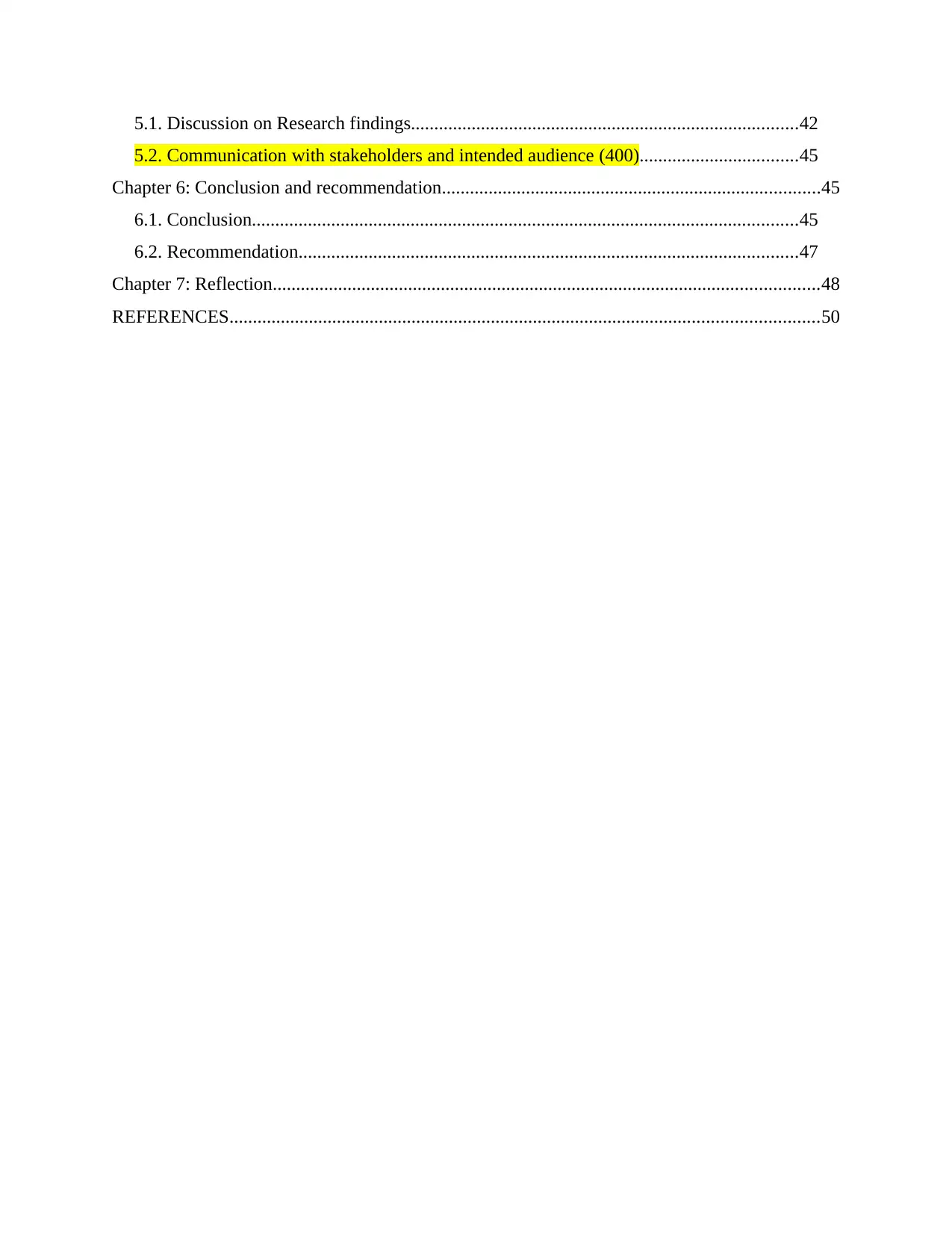
5.1. Discussion on Research findings...................................................................................42
5.2. Communication with stakeholders and intended audience (400)..................................45
Chapter 6: Conclusion and recommendation.................................................................................45
6.1. Conclusion.....................................................................................................................45
6.2. Recommendation...........................................................................................................47
Chapter 7: Reflection.....................................................................................................................48
REFERENCES..............................................................................................................................50
5.2. Communication with stakeholders and intended audience (400)..................................45
Chapter 6: Conclusion and recommendation.................................................................................45
6.1. Conclusion.....................................................................................................................45
6.2. Recommendation...........................................................................................................47
Chapter 7: Reflection.....................................................................................................................48
REFERENCES..............................................................................................................................50
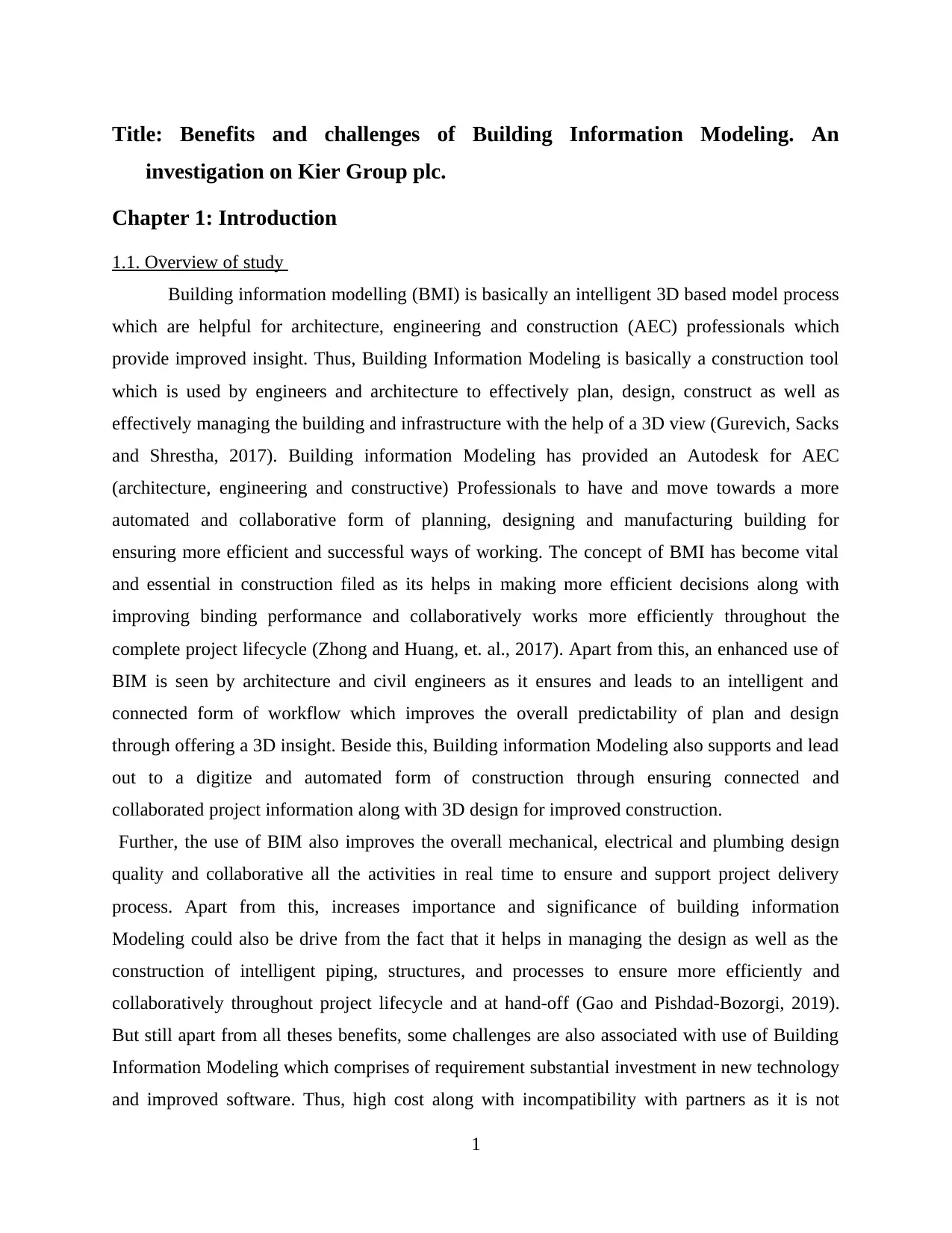
Title: Benefits and challenges of Building Information Modeling. An
investigation on Kier Group plc.
Chapter 1: Introduction
1.1. Overview of study
Building information modelling (BMI) is basically an intelligent 3D based model process
which are helpful for architecture, engineering and construction (AEC) professionals which
provide improved insight. Thus, Building Information Modeling is basically a construction tool
which is used by engineers and architecture to effectively plan, design, construct as well as
effectively managing the building and infrastructure with the help of a 3D view (Gurevich, Sacks
and Shrestha, 2017). Building information Modeling has provided an Autodesk for AEC
(architecture, engineering and constructive) Professionals to have and move towards a more
automated and collaborative form of planning, designing and manufacturing building for
ensuring more efficient and successful ways of working. The concept of BMI has become vital
and essential in construction filed as its helps in making more efficient decisions along with
improving binding performance and collaboratively works more efficiently throughout the
complete project lifecycle (Zhong and Huang, et. al., 2017). Apart from this, an enhanced use of
BIM is seen by architecture and civil engineers as it ensures and leads to an intelligent and
connected form of workflow which improves the overall predictability of plan and design
through offering a 3D insight. Beside this, Building information Modeling also supports and lead
out to a digitize and automated form of construction through ensuring connected and
collaborated project information along with 3D design for improved construction.
Further, the use of BIM also improves the overall mechanical, electrical and plumbing design
quality and collaborative all the activities in real time to ensure and support project delivery
process. Apart from this, increases importance and significance of building information
Modeling could also be drive from the fact that it helps in managing the design as well as the
construction of intelligent piping, structures, and processes to ensure more efficiently and
collaboratively throughout project lifecycle and at hand-off (Gao and Pishdad-Bozorgi, 2019).
But still apart from all theses benefits, some challenges are also associated with use of Building
Information Modeling which comprises of requirement substantial investment in new technology
and improved software. Thus, high cost along with incompatibility with partners as it is not
1
investigation on Kier Group plc.
Chapter 1: Introduction
1.1. Overview of study
Building information modelling (BMI) is basically an intelligent 3D based model process
which are helpful for architecture, engineering and construction (AEC) professionals which
provide improved insight. Thus, Building Information Modeling is basically a construction tool
which is used by engineers and architecture to effectively plan, design, construct as well as
effectively managing the building and infrastructure with the help of a 3D view (Gurevich, Sacks
and Shrestha, 2017). Building information Modeling has provided an Autodesk for AEC
(architecture, engineering and constructive) Professionals to have and move towards a more
automated and collaborative form of planning, designing and manufacturing building for
ensuring more efficient and successful ways of working. The concept of BMI has become vital
and essential in construction filed as its helps in making more efficient decisions along with
improving binding performance and collaboratively works more efficiently throughout the
complete project lifecycle (Zhong and Huang, et. al., 2017). Apart from this, an enhanced use of
BIM is seen by architecture and civil engineers as it ensures and leads to an intelligent and
connected form of workflow which improves the overall predictability of plan and design
through offering a 3D insight. Beside this, Building information Modeling also supports and lead
out to a digitize and automated form of construction through ensuring connected and
collaborated project information along with 3D design for improved construction.
Further, the use of BIM also improves the overall mechanical, electrical and plumbing design
quality and collaborative all the activities in real time to ensure and support project delivery
process. Apart from this, increases importance and significance of building information
Modeling could also be drive from the fact that it helps in managing the design as well as the
construction of intelligent piping, structures, and processes to ensure more efficiently and
collaboratively throughout project lifecycle and at hand-off (Gao and Pishdad-Bozorgi, 2019).
But still apart from all theses benefits, some challenges are also associated with use of Building
Information Modeling which comprises of requirement substantial investment in new technology
and improved software. Thus, high cost along with incompatibility with partners as it is not
1
Secure Best Marks with AI Grader
Need help grading? Try our AI Grader for instant feedback on your assignments.
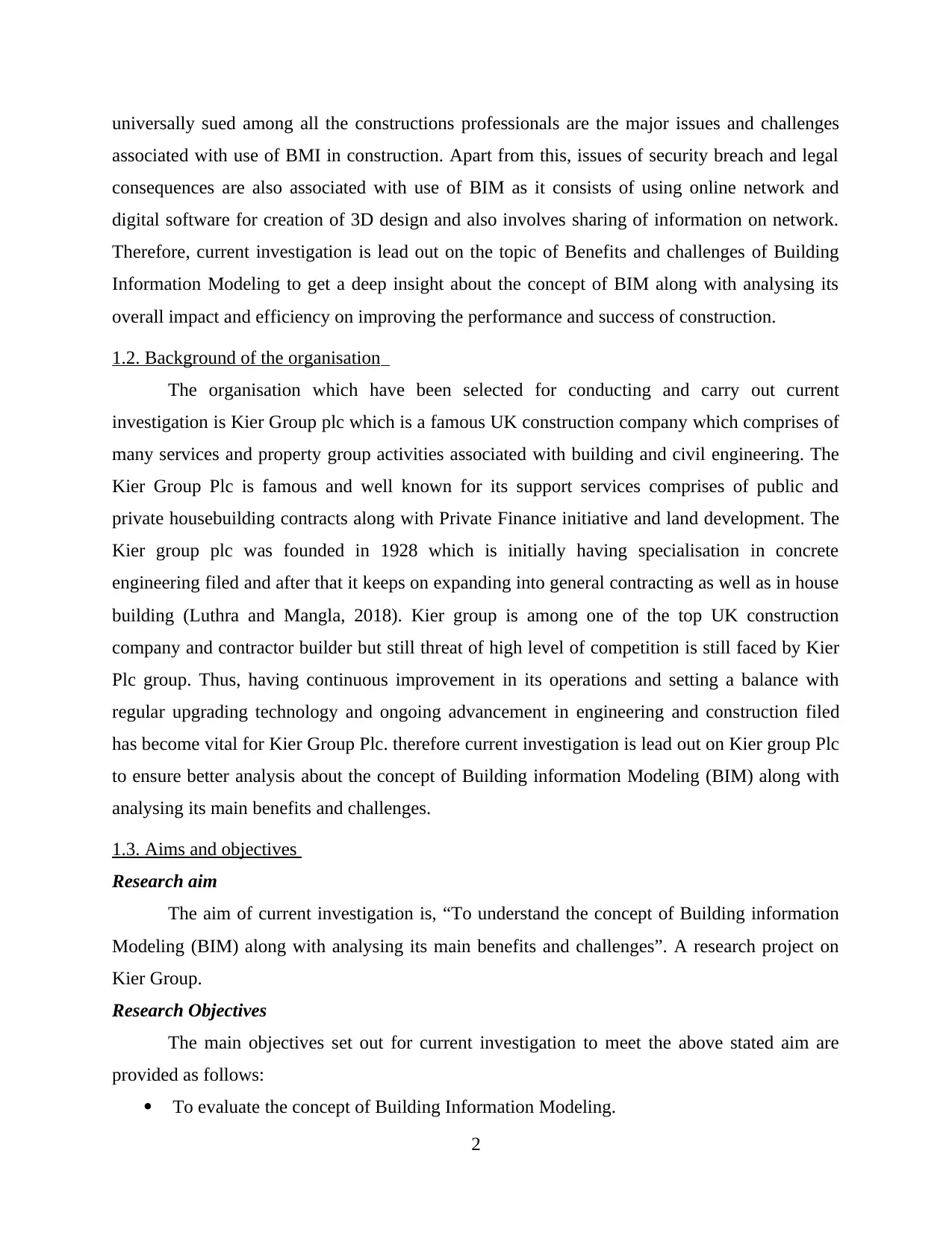
universally sued among all the constructions professionals are the major issues and challenges
associated with use of BMI in construction. Apart from this, issues of security breach and legal
consequences are also associated with use of BIM as it consists of using online network and
digital software for creation of 3D design and also involves sharing of information on network.
Therefore, current investigation is lead out on the topic of Benefits and challenges of Building
Information Modeling to get a deep insight about the concept of BIM along with analysing its
overall impact and efficiency on improving the performance and success of construction.
1.2. Background of the organisation
The organisation which have been selected for conducting and carry out current
investigation is Kier Group plc which is a famous UK construction company which comprises of
many services and property group activities associated with building and civil engineering. The
Kier Group Plc is famous and well known for its support services comprises of public and
private housebuilding contracts along with Private Finance initiative and land development. The
Kier group plc was founded in 1928 which is initially having specialisation in concrete
engineering filed and after that it keeps on expanding into general contracting as well as in house
building (Luthra and Mangla, 2018). Kier group is among one of the top UK construction
company and contractor builder but still threat of high level of competition is still faced by Kier
Plc group. Thus, having continuous improvement in its operations and setting a balance with
regular upgrading technology and ongoing advancement in engineering and construction filed
has become vital for Kier Group Plc. therefore current investigation is lead out on Kier group Plc
to ensure better analysis about the concept of Building information Modeling (BIM) along with
analysing its main benefits and challenges.
1.3. Aims and objectives
Research aim
The aim of current investigation is, “To understand the concept of Building information
Modeling (BIM) along with analysing its main benefits and challenges”. A research project on
Kier Group.
Research Objectives
The main objectives set out for current investigation to meet the above stated aim are
provided as follows:
To evaluate the concept of Building Information Modeling.
2
associated with use of BMI in construction. Apart from this, issues of security breach and legal
consequences are also associated with use of BIM as it consists of using online network and
digital software for creation of 3D design and also involves sharing of information on network.
Therefore, current investigation is lead out on the topic of Benefits and challenges of Building
Information Modeling to get a deep insight about the concept of BIM along with analysing its
overall impact and efficiency on improving the performance and success of construction.
1.2. Background of the organisation
The organisation which have been selected for conducting and carry out current
investigation is Kier Group plc which is a famous UK construction company which comprises of
many services and property group activities associated with building and civil engineering. The
Kier Group Plc is famous and well known for its support services comprises of public and
private housebuilding contracts along with Private Finance initiative and land development. The
Kier group plc was founded in 1928 which is initially having specialisation in concrete
engineering filed and after that it keeps on expanding into general contracting as well as in house
building (Luthra and Mangla, 2018). Kier group is among one of the top UK construction
company and contractor builder but still threat of high level of competition is still faced by Kier
Plc group. Thus, having continuous improvement in its operations and setting a balance with
regular upgrading technology and ongoing advancement in engineering and construction filed
has become vital for Kier Group Plc. therefore current investigation is lead out on Kier group Plc
to ensure better analysis about the concept of Building information Modeling (BIM) along with
analysing its main benefits and challenges.
1.3. Aims and objectives
Research aim
The aim of current investigation is, “To understand the concept of Building information
Modeling (BIM) along with analysing its main benefits and challenges”. A research project on
Kier Group.
Research Objectives
The main objectives set out for current investigation to meet the above stated aim are
provided as follows:
To evaluate the concept of Building Information Modeling.
2
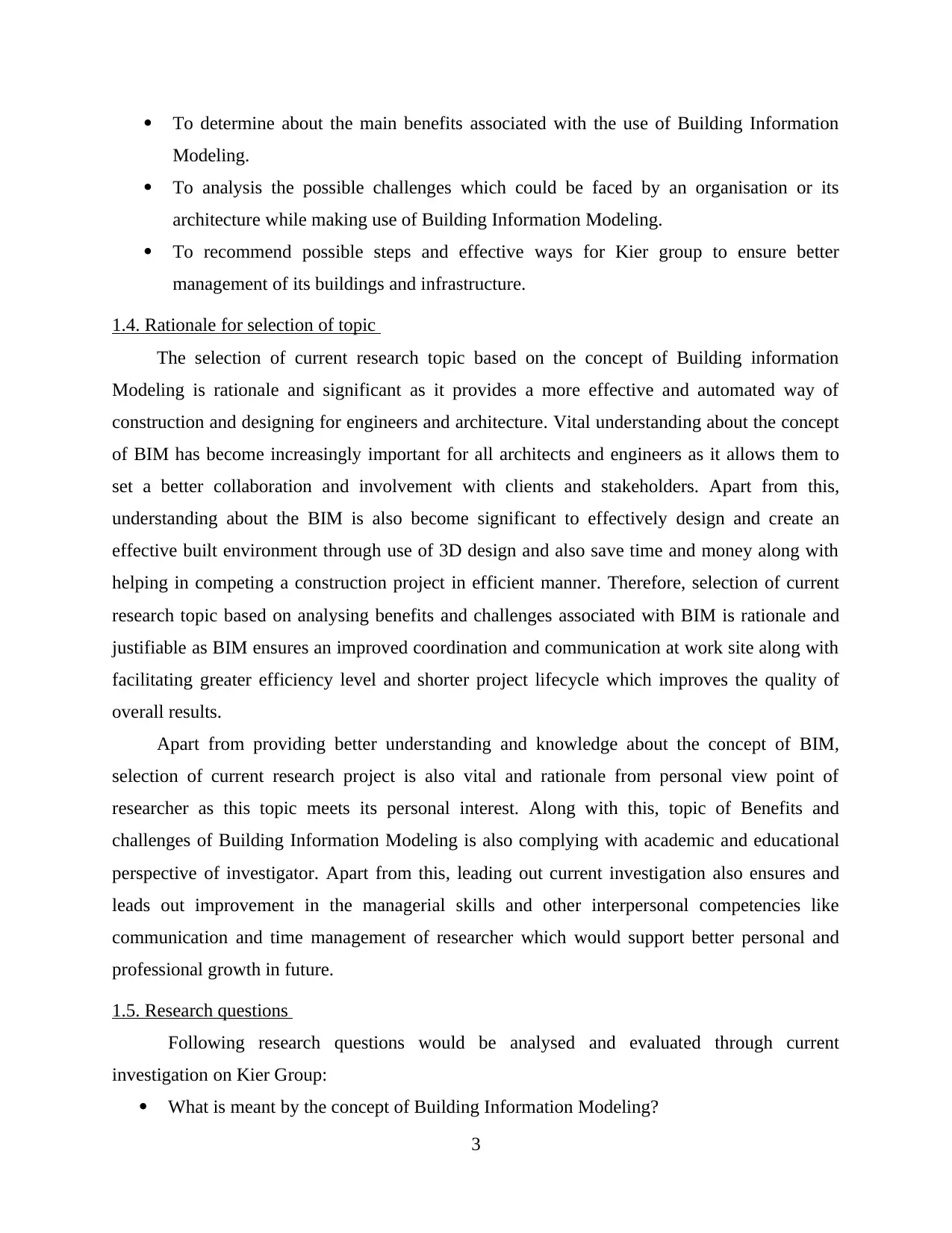
To determine about the main benefits associated with the use of Building Information
Modeling.
To analysis the possible challenges which could be faced by an organisation or its
architecture while making use of Building Information Modeling.
To recommend possible steps and effective ways for Kier group to ensure better
management of its buildings and infrastructure.
1.4. Rationale for selection of topic
The selection of current research topic based on the concept of Building information
Modeling is rationale and significant as it provides a more effective and automated way of
construction and designing for engineers and architecture. Vital understanding about the concept
of BIM has become increasingly important for all architects and engineers as it allows them to
set a better collaboration and involvement with clients and stakeholders. Apart from this,
understanding about the BIM is also become significant to effectively design and create an
effective built environment through use of 3D design and also save time and money along with
helping in competing a construction project in efficient manner. Therefore, selection of current
research topic based on analysing benefits and challenges associated with BIM is rationale and
justifiable as BIM ensures an improved coordination and communication at work site along with
facilitating greater efficiency level and shorter project lifecycle which improves the quality of
overall results.
Apart from providing better understanding and knowledge about the concept of BIM,
selection of current research project is also vital and rationale from personal view point of
researcher as this topic meets its personal interest. Along with this, topic of Benefits and
challenges of Building Information Modeling is also complying with academic and educational
perspective of investigator. Apart from this, leading out current investigation also ensures and
leads out improvement in the managerial skills and other interpersonal competencies like
communication and time management of researcher which would support better personal and
professional growth in future.
1.5. Research questions
Following research questions would be analysed and evaluated through current
investigation on Kier Group:
What is meant by the concept of Building Information Modeling?
3
Modeling.
To analysis the possible challenges which could be faced by an organisation or its
architecture while making use of Building Information Modeling.
To recommend possible steps and effective ways for Kier group to ensure better
management of its buildings and infrastructure.
1.4. Rationale for selection of topic
The selection of current research topic based on the concept of Building information
Modeling is rationale and significant as it provides a more effective and automated way of
construction and designing for engineers and architecture. Vital understanding about the concept
of BIM has become increasingly important for all architects and engineers as it allows them to
set a better collaboration and involvement with clients and stakeholders. Apart from this,
understanding about the BIM is also become significant to effectively design and create an
effective built environment through use of 3D design and also save time and money along with
helping in competing a construction project in efficient manner. Therefore, selection of current
research topic based on analysing benefits and challenges associated with BIM is rationale and
justifiable as BIM ensures an improved coordination and communication at work site along with
facilitating greater efficiency level and shorter project lifecycle which improves the quality of
overall results.
Apart from providing better understanding and knowledge about the concept of BIM,
selection of current research project is also vital and rationale from personal view point of
researcher as this topic meets its personal interest. Along with this, topic of Benefits and
challenges of Building Information Modeling is also complying with academic and educational
perspective of investigator. Apart from this, leading out current investigation also ensures and
leads out improvement in the managerial skills and other interpersonal competencies like
communication and time management of researcher which would support better personal and
professional growth in future.
1.5. Research questions
Following research questions would be analysed and evaluated through current
investigation on Kier Group:
What is meant by the concept of Building Information Modeling?
3
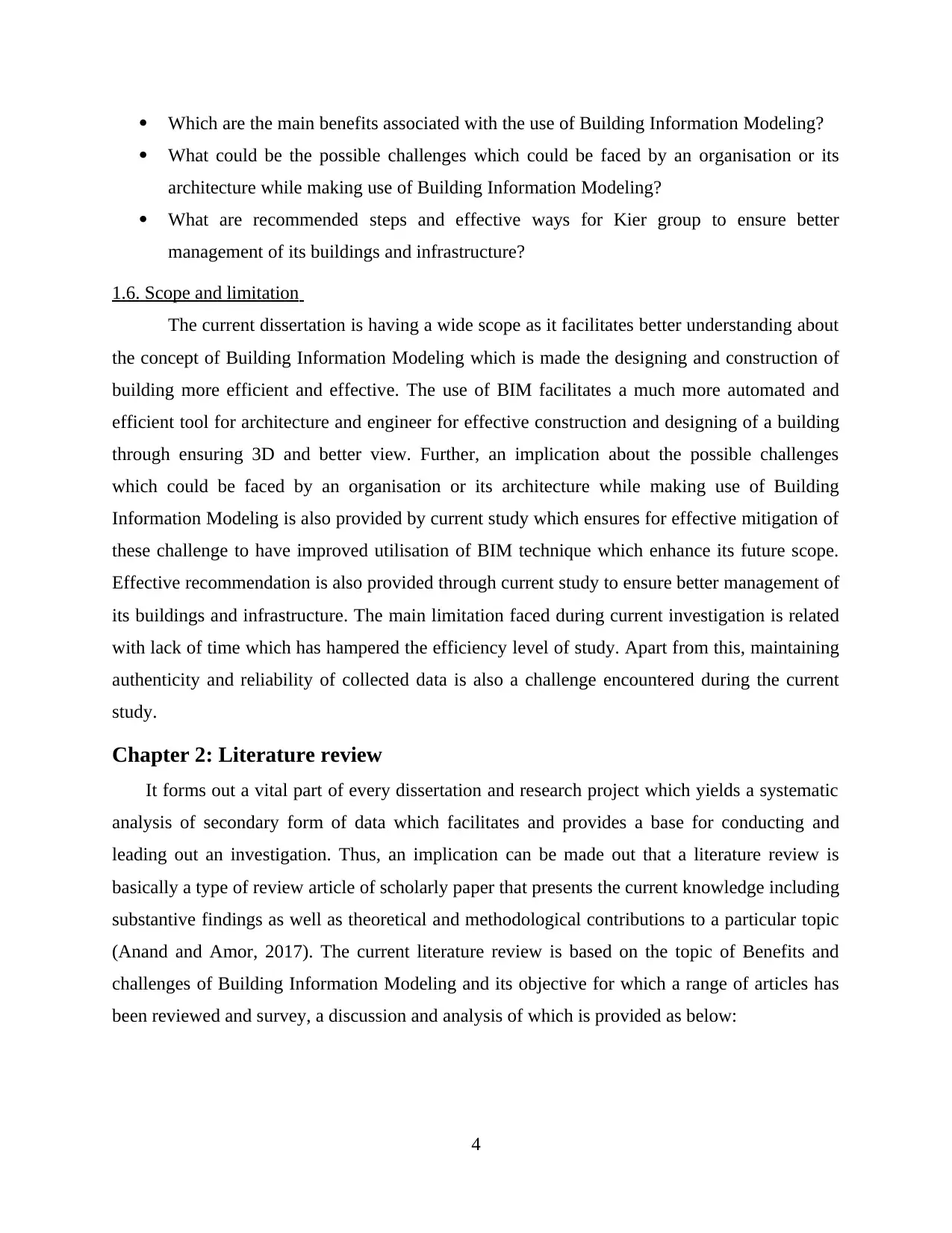
Which are the main benefits associated with the use of Building Information Modeling?
What could be the possible challenges which could be faced by an organisation or its
architecture while making use of Building Information Modeling?
What are recommended steps and effective ways for Kier group to ensure better
management of its buildings and infrastructure?
1.6. Scope and limitation
The current dissertation is having a wide scope as it facilitates better understanding about
the concept of Building Information Modeling which is made the designing and construction of
building more efficient and effective. The use of BIM facilitates a much more automated and
efficient tool for architecture and engineer for effective construction and designing of a building
through ensuring 3D and better view. Further, an implication about the possible challenges
which could be faced by an organisation or its architecture while making use of Building
Information Modeling is also provided by current study which ensures for effective mitigation of
these challenge to have improved utilisation of BIM technique which enhance its future scope.
Effective recommendation is also provided through current study to ensure better management of
its buildings and infrastructure. The main limitation faced during current investigation is related
with lack of time which has hampered the efficiency level of study. Apart from this, maintaining
authenticity and reliability of collected data is also a challenge encountered during the current
study.
Chapter 2: Literature review
It forms out a vital part of every dissertation and research project which yields a systematic
analysis of secondary form of data which facilitates and provides a base for conducting and
leading out an investigation. Thus, an implication can be made out that a literature review is
basically a type of review article of scholarly paper that presents the current knowledge including
substantive findings as well as theoretical and methodological contributions to a particular topic
(Anand and Amor, 2017). The current literature review is based on the topic of Benefits and
challenges of Building Information Modeling and its objective for which a range of articles has
been reviewed and survey, a discussion and analysis of which is provided as below:
4
What could be the possible challenges which could be faced by an organisation or its
architecture while making use of Building Information Modeling?
What are recommended steps and effective ways for Kier group to ensure better
management of its buildings and infrastructure?
1.6. Scope and limitation
The current dissertation is having a wide scope as it facilitates better understanding about
the concept of Building Information Modeling which is made the designing and construction of
building more efficient and effective. The use of BIM facilitates a much more automated and
efficient tool for architecture and engineer for effective construction and designing of a building
through ensuring 3D and better view. Further, an implication about the possible challenges
which could be faced by an organisation or its architecture while making use of Building
Information Modeling is also provided by current study which ensures for effective mitigation of
these challenge to have improved utilisation of BIM technique which enhance its future scope.
Effective recommendation is also provided through current study to ensure better management of
its buildings and infrastructure. The main limitation faced during current investigation is related
with lack of time which has hampered the efficiency level of study. Apart from this, maintaining
authenticity and reliability of collected data is also a challenge encountered during the current
study.
Chapter 2: Literature review
It forms out a vital part of every dissertation and research project which yields a systematic
analysis of secondary form of data which facilitates and provides a base for conducting and
leading out an investigation. Thus, an implication can be made out that a literature review is
basically a type of review article of scholarly paper that presents the current knowledge including
substantive findings as well as theoretical and methodological contributions to a particular topic
(Anand and Amor, 2017). The current literature review is based on the topic of Benefits and
challenges of Building Information Modeling and its objective for which a range of articles has
been reviewed and survey, a discussion and analysis of which is provided as below:
4
Paraphrase This Document
Need a fresh take? Get an instant paraphrase of this document with our AI Paraphraser
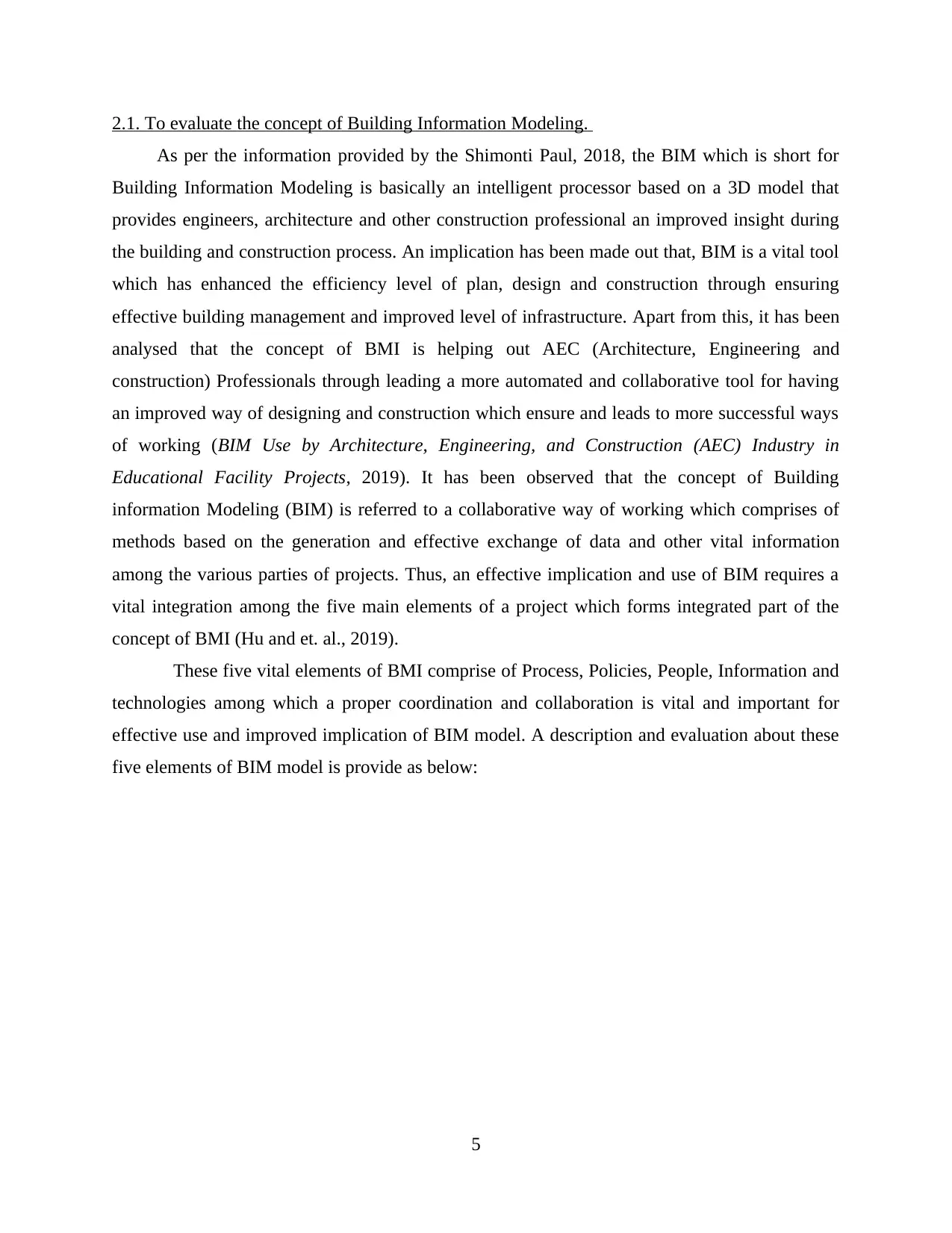
2.1. To evaluate the concept of Building Information Modeling.
As per the information provided by the Shimonti Paul, 2018, the BIM which is short for
Building Information Modeling is basically an intelligent processor based on a 3D model that
provides engineers, architecture and other construction professional an improved insight during
the building and construction process. An implication has been made out that, BIM is a vital tool
which has enhanced the efficiency level of plan, design and construction through ensuring
effective building management and improved level of infrastructure. Apart from this, it has been
analysed that the concept of BMI is helping out AEC (Architecture, Engineering and
construction) Professionals through leading a more automated and collaborative tool for having
an improved way of designing and construction which ensure and leads to more successful ways
of working (BIM Use by Architecture, Engineering, and Construction (AEC) Industry in
Educational Facility Projects, 2019). It has been observed that the concept of Building
information Modeling (BIM) is referred to a collaborative way of working which comprises of
methods based on the generation and effective exchange of data and other vital information
among the various parties of projects. Thus, an effective implication and use of BIM requires a
vital integration among the five main elements of a project which forms integrated part of the
concept of BMI (Hu and et. al., 2019).
These five vital elements of BMI comprise of Process, Policies, People, Information and
technologies among which a proper coordination and collaboration is vital and important for
effective use and improved implication of BIM model. A description and evaluation about these
five elements of BIM model is provide as below:
5
As per the information provided by the Shimonti Paul, 2018, the BIM which is short for
Building Information Modeling is basically an intelligent processor based on a 3D model that
provides engineers, architecture and other construction professional an improved insight during
the building and construction process. An implication has been made out that, BIM is a vital tool
which has enhanced the efficiency level of plan, design and construction through ensuring
effective building management and improved level of infrastructure. Apart from this, it has been
analysed that the concept of BMI is helping out AEC (Architecture, Engineering and
construction) Professionals through leading a more automated and collaborative tool for having
an improved way of designing and construction which ensure and leads to more successful ways
of working (BIM Use by Architecture, Engineering, and Construction (AEC) Industry in
Educational Facility Projects, 2019). It has been observed that the concept of Building
information Modeling (BIM) is referred to a collaborative way of working which comprises of
methods based on the generation and effective exchange of data and other vital information
among the various parties of projects. Thus, an effective implication and use of BIM requires a
vital integration among the five main elements of a project which forms integrated part of the
concept of BMI (Hu and et. al., 2019).
These five vital elements of BMI comprise of Process, Policies, People, Information and
technologies among which a proper coordination and collaboration is vital and important for
effective use and improved implication of BIM model. A description and evaluation about these
five elements of BIM model is provide as below:
5
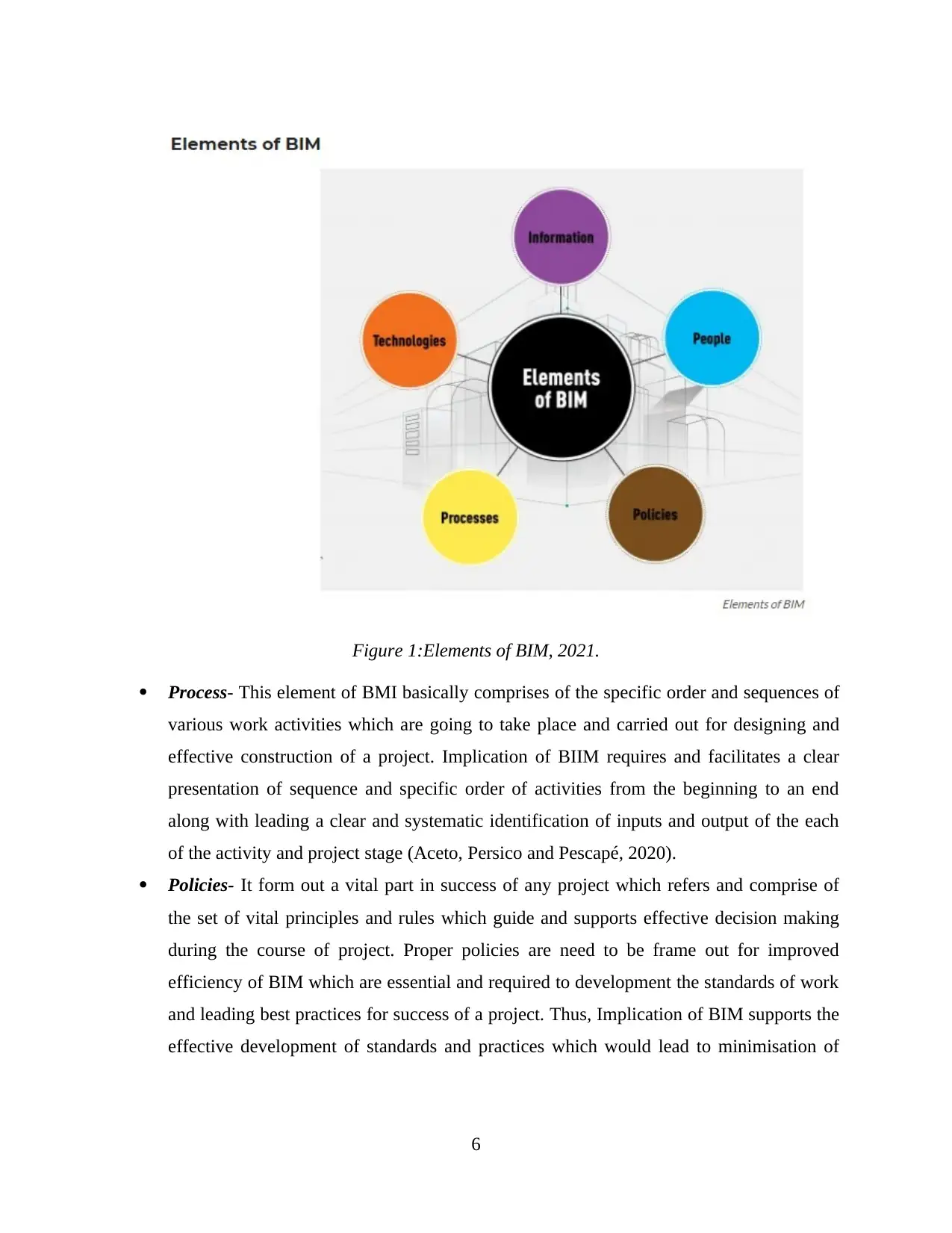
Figure 1:Elements of BIM, 2021.
Process- This element of BMI basically comprises of the specific order and sequences of
various work activities which are going to take place and carried out for designing and
effective construction of a project. Implication of BIIM requires and facilitates a clear
presentation of sequence and specific order of activities from the beginning to an end
along with leading a clear and systematic identification of inputs and output of the each
of the activity and project stage (Aceto, Persico and Pescapé, 2020).
Policies- It form out a vital part in success of any project which refers and comprise of
the set of vital principles and rules which guide and supports effective decision making
during the course of project. Proper policies are need to be frame out for improved
efficiency of BIM which are essential and required to development the standards of work
and leading best practices for success of a project. Thus, Implication of BIM supports the
effective development of standards and practices which would lead to minimisation of
6
Process- This element of BMI basically comprises of the specific order and sequences of
various work activities which are going to take place and carried out for designing and
effective construction of a project. Implication of BIIM requires and facilitates a clear
presentation of sequence and specific order of activities from the beginning to an end
along with leading a clear and systematic identification of inputs and output of the each
of the activity and project stage (Aceto, Persico and Pescapé, 2020).
Policies- It form out a vital part in success of any project which refers and comprise of
the set of vital principles and rules which guide and supports effective decision making
during the course of project. Proper policies are need to be frame out for improved
efficiency of BIM which are essential and required to development the standards of work
and leading best practices for success of a project. Thus, Implication of BIM supports the
effective development of standards and practices which would lead to minimisation of
6
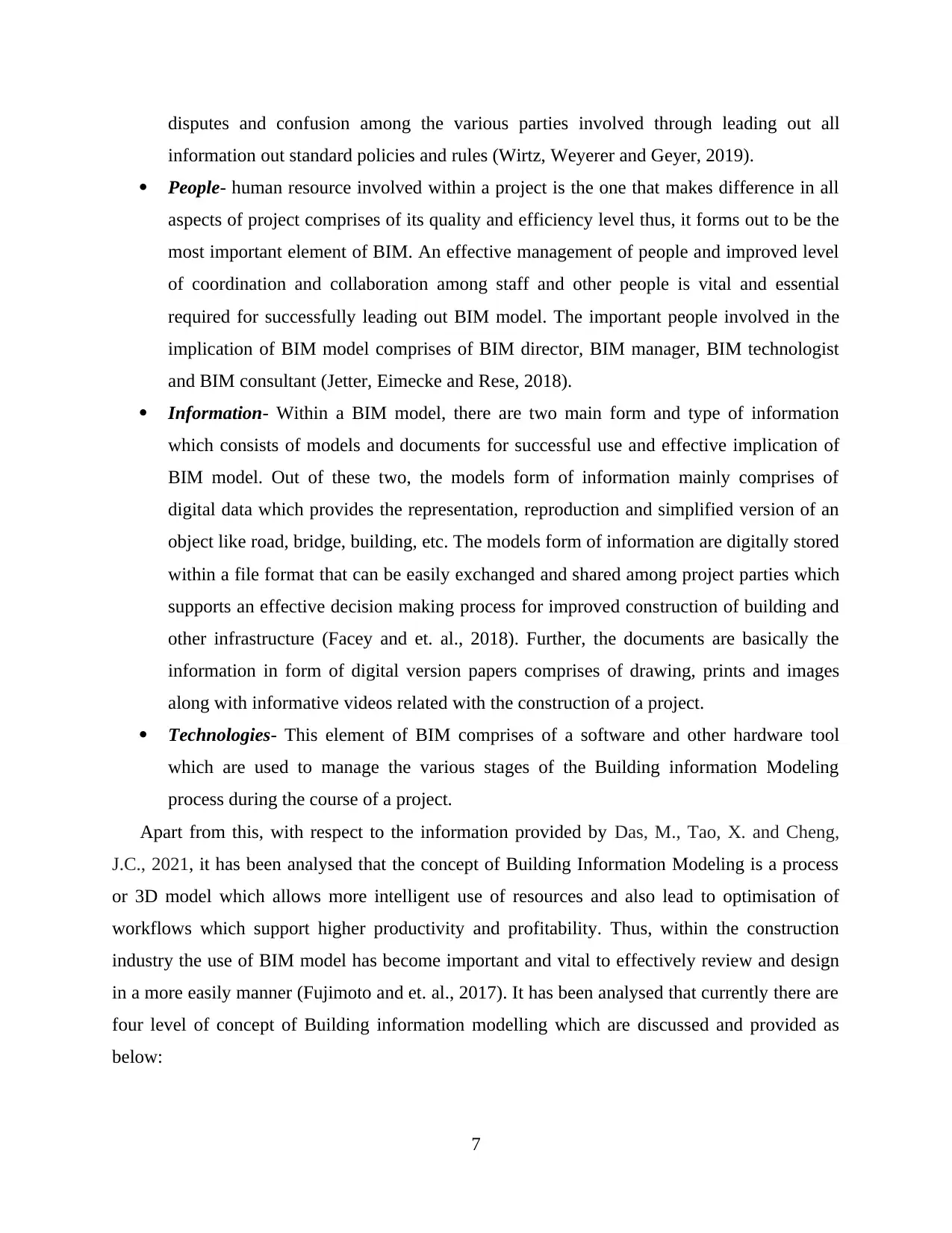
disputes and confusion among the various parties involved through leading out all
information out standard policies and rules (Wirtz, Weyerer and Geyer, 2019).
People- human resource involved within a project is the one that makes difference in all
aspects of project comprises of its quality and efficiency level thus, it forms out to be the
most important element of BIM. An effective management of people and improved level
of coordination and collaboration among staff and other people is vital and essential
required for successfully leading out BIM model. The important people involved in the
implication of BIM model comprises of BIM director, BIM manager, BIM technologist
and BIM consultant (Jetter, Eimecke and Rese, 2018).
Information- Within a BIM model, there are two main form and type of information
which consists of models and documents for successful use and effective implication of
BIM model. Out of these two, the models form of information mainly comprises of
digital data which provides the representation, reproduction and simplified version of an
object like road, bridge, building, etc. The models form of information are digitally stored
within a file format that can be easily exchanged and shared among project parties which
supports an effective decision making process for improved construction of building and
other infrastructure (Facey and et. al., 2018). Further, the documents are basically the
information in form of digital version papers comprises of drawing, prints and images
along with informative videos related with the construction of a project.
Technologies- This element of BIM comprises of a software and other hardware tool
which are used to manage the various stages of the Building information Modeling
process during the course of a project.
Apart from this, with respect to the information provided by Das, M., Tao, X. and Cheng,
J.C., 2021, it has been analysed that the concept of Building Information Modeling is a process
or 3D model which allows more intelligent use of resources and also lead to optimisation of
workflows which support higher productivity and profitability. Thus, within the construction
industry the use of BIM model has become important and vital to effectively review and design
in a more easily manner (Fujimoto and et. al., 2017). It has been analysed that currently there are
four level of concept of Building information modelling which are discussed and provided as
below:
7
information out standard policies and rules (Wirtz, Weyerer and Geyer, 2019).
People- human resource involved within a project is the one that makes difference in all
aspects of project comprises of its quality and efficiency level thus, it forms out to be the
most important element of BIM. An effective management of people and improved level
of coordination and collaboration among staff and other people is vital and essential
required for successfully leading out BIM model. The important people involved in the
implication of BIM model comprises of BIM director, BIM manager, BIM technologist
and BIM consultant (Jetter, Eimecke and Rese, 2018).
Information- Within a BIM model, there are two main form and type of information
which consists of models and documents for successful use and effective implication of
BIM model. Out of these two, the models form of information mainly comprises of
digital data which provides the representation, reproduction and simplified version of an
object like road, bridge, building, etc. The models form of information are digitally stored
within a file format that can be easily exchanged and shared among project parties which
supports an effective decision making process for improved construction of building and
other infrastructure (Facey and et. al., 2018). Further, the documents are basically the
information in form of digital version papers comprises of drawing, prints and images
along with informative videos related with the construction of a project.
Technologies- This element of BIM comprises of a software and other hardware tool
which are used to manage the various stages of the Building information Modeling
process during the course of a project.
Apart from this, with respect to the information provided by Das, M., Tao, X. and Cheng,
J.C., 2021, it has been analysed that the concept of Building Information Modeling is a process
or 3D model which allows more intelligent use of resources and also lead to optimisation of
workflows which support higher productivity and profitability. Thus, within the construction
industry the use of BIM model has become important and vital to effectively review and design
in a more easily manner (Fujimoto and et. al., 2017). It has been analysed that currently there are
four level of concept of Building information modelling which are discussed and provided as
below:
7
Secure Best Marks with AI Grader
Need help grading? Try our AI Grader for instant feedback on your assignments.
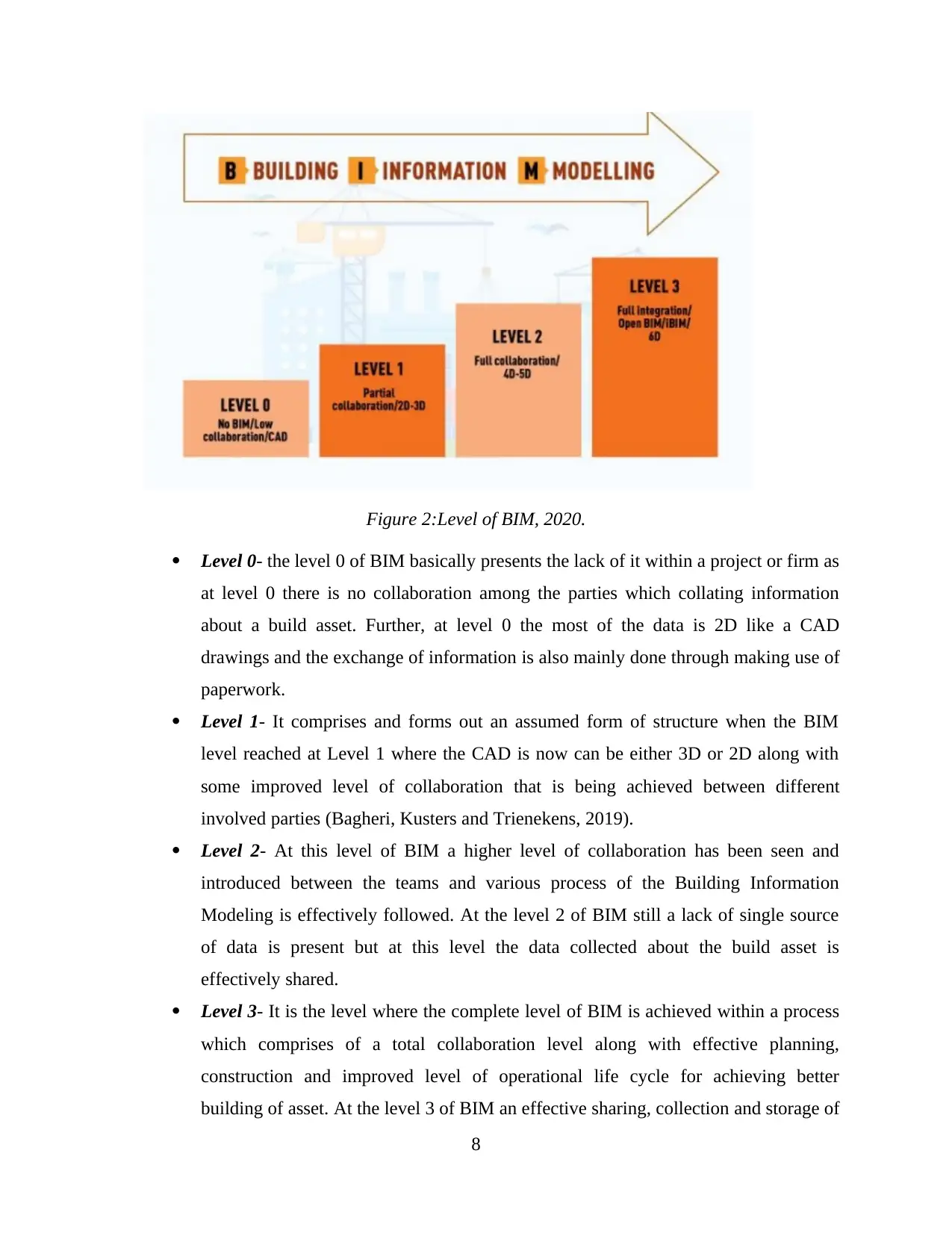
Figure 2:Level of BIM, 2020.
Level 0- the level 0 of BIM basically presents the lack of it within a project or firm as
at level 0 there is no collaboration among the parties which collating information
about a build asset. Further, at level 0 the most of the data is 2D like a CAD
drawings and the exchange of information is also mainly done through making use of
paperwork.
Level 1- It comprises and forms out an assumed form of structure when the BIM
level reached at Level 1 where the CAD is now can be either 3D or 2D along with
some improved level of collaboration that is being achieved between different
involved parties (Bagheri, Kusters and Trienekens, 2019).
Level 2- At this level of BIM a higher level of collaboration has been seen and
introduced between the teams and various process of the Building Information
Modeling is effectively followed. At the level 2 of BIM still a lack of single source
of data is present but at this level the data collected about the build asset is
effectively shared.
Level 3- It is the level where the complete level of BIM is achieved within a process
which comprises of a total collaboration level along with effective planning,
construction and improved level of operational life cycle for achieving better
building of asset. At the level 3 of BIM an effective sharing, collection and storage of
8
Level 0- the level 0 of BIM basically presents the lack of it within a project or firm as
at level 0 there is no collaboration among the parties which collating information
about a build asset. Further, at level 0 the most of the data is 2D like a CAD
drawings and the exchange of information is also mainly done through making use of
paperwork.
Level 1- It comprises and forms out an assumed form of structure when the BIM
level reached at Level 1 where the CAD is now can be either 3D or 2D along with
some improved level of collaboration that is being achieved between different
involved parties (Bagheri, Kusters and Trienekens, 2019).
Level 2- At this level of BIM a higher level of collaboration has been seen and
introduced between the teams and various process of the Building Information
Modeling is effectively followed. At the level 2 of BIM still a lack of single source
of data is present but at this level the data collected about the build asset is
effectively shared.
Level 3- It is the level where the complete level of BIM is achieved within a process
which comprises of a total collaboration level along with effective planning,
construction and improved level of operational life cycle for achieving better
building of asset. At the level 3 of BIM an effective sharing, collection and storage of
8
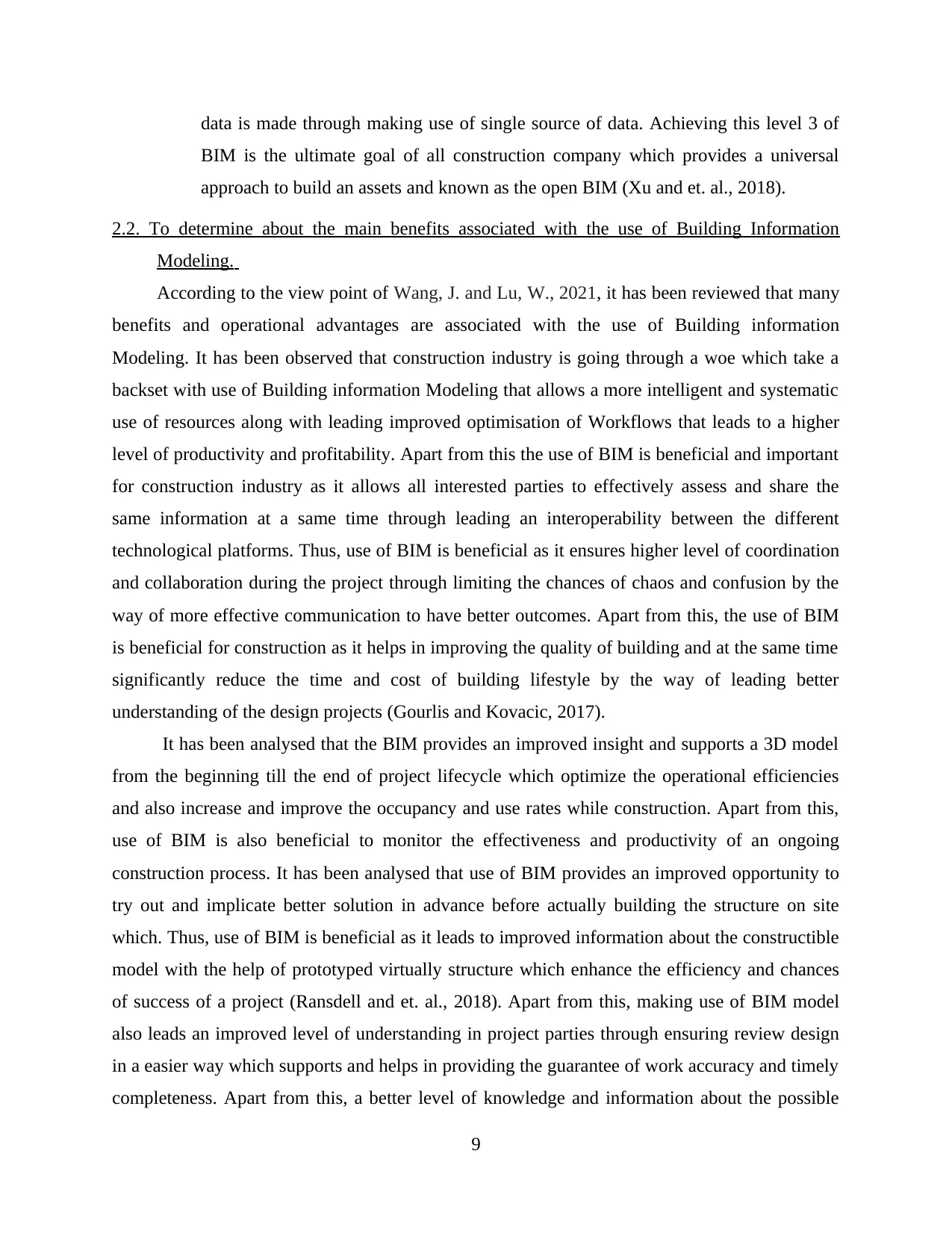
data is made through making use of single source of data. Achieving this level 3 of
BIM is the ultimate goal of all construction company which provides a universal
approach to build an assets and known as the open BIM (Xu and et. al., 2018).
2.2. To determine about the main benefits associated with the use of Building Information
Modeling.
According to the view point of Wang, J. and Lu, W., 2021, it has been reviewed that many
benefits and operational advantages are associated with the use of Building information
Modeling. It has been observed that construction industry is going through a woe which take a
backset with use of Building information Modeling that allows a more intelligent and systematic
use of resources along with leading improved optimisation of Workflows that leads to a higher
level of productivity and profitability. Apart from this the use of BIM is beneficial and important
for construction industry as it allows all interested parties to effectively assess and share the
same information at a same time through leading an interoperability between the different
technological platforms. Thus, use of BIM is beneficial as it ensures higher level of coordination
and collaboration during the project through limiting the chances of chaos and confusion by the
way of more effective communication to have better outcomes. Apart from this, the use of BIM
is beneficial for construction as it helps in improving the quality of building and at the same time
significantly reduce the time and cost of building lifestyle by the way of leading better
understanding of the design projects (Gourlis and Kovacic, 2017).
It has been analysed that the BIM provides an improved insight and supports a 3D model
from the beginning till the end of project lifecycle which optimize the operational efficiencies
and also increase and improve the occupancy and use rates while construction. Apart from this,
use of BIM is also beneficial to monitor the effectiveness and productivity of an ongoing
construction process. It has been analysed that use of BIM provides an improved opportunity to
try out and implicate better solution in advance before actually building the structure on site
which. Thus, use of BIM is beneficial as it leads to improved information about the constructible
model with the help of prototyped virtually structure which enhance the efficiency and chances
of success of a project (Ransdell and et. al., 2018). Apart from this, making use of BIM model
also leads an improved level of understanding in project parties through ensuring review design
in a easier way which supports and helps in providing the guarantee of work accuracy and timely
completeness. Apart from this, a better level of knowledge and information about the possible
9
BIM is the ultimate goal of all construction company which provides a universal
approach to build an assets and known as the open BIM (Xu and et. al., 2018).
2.2. To determine about the main benefits associated with the use of Building Information
Modeling.
According to the view point of Wang, J. and Lu, W., 2021, it has been reviewed that many
benefits and operational advantages are associated with the use of Building information
Modeling. It has been observed that construction industry is going through a woe which take a
backset with use of Building information Modeling that allows a more intelligent and systematic
use of resources along with leading improved optimisation of Workflows that leads to a higher
level of productivity and profitability. Apart from this the use of BIM is beneficial and important
for construction industry as it allows all interested parties to effectively assess and share the
same information at a same time through leading an interoperability between the different
technological platforms. Thus, use of BIM is beneficial as it ensures higher level of coordination
and collaboration during the project through limiting the chances of chaos and confusion by the
way of more effective communication to have better outcomes. Apart from this, the use of BIM
is beneficial for construction as it helps in improving the quality of building and at the same time
significantly reduce the time and cost of building lifestyle by the way of leading better
understanding of the design projects (Gourlis and Kovacic, 2017).
It has been analysed that the BIM provides an improved insight and supports a 3D model
from the beginning till the end of project lifecycle which optimize the operational efficiencies
and also increase and improve the occupancy and use rates while construction. Apart from this,
use of BIM is also beneficial to monitor the effectiveness and productivity of an ongoing
construction process. It has been analysed that use of BIM provides an improved opportunity to
try out and implicate better solution in advance before actually building the structure on site
which. Thus, use of BIM is beneficial as it leads to improved information about the constructible
model with the help of prototyped virtually structure which enhance the efficiency and chances
of success of a project (Ransdell and et. al., 2018). Apart from this, making use of BIM model
also leads an improved level of understanding in project parties through ensuring review design
in a easier way which supports and helps in providing the guarantee of work accuracy and timely
completeness. Apart from this, a better level of knowledge and information about the possible
9
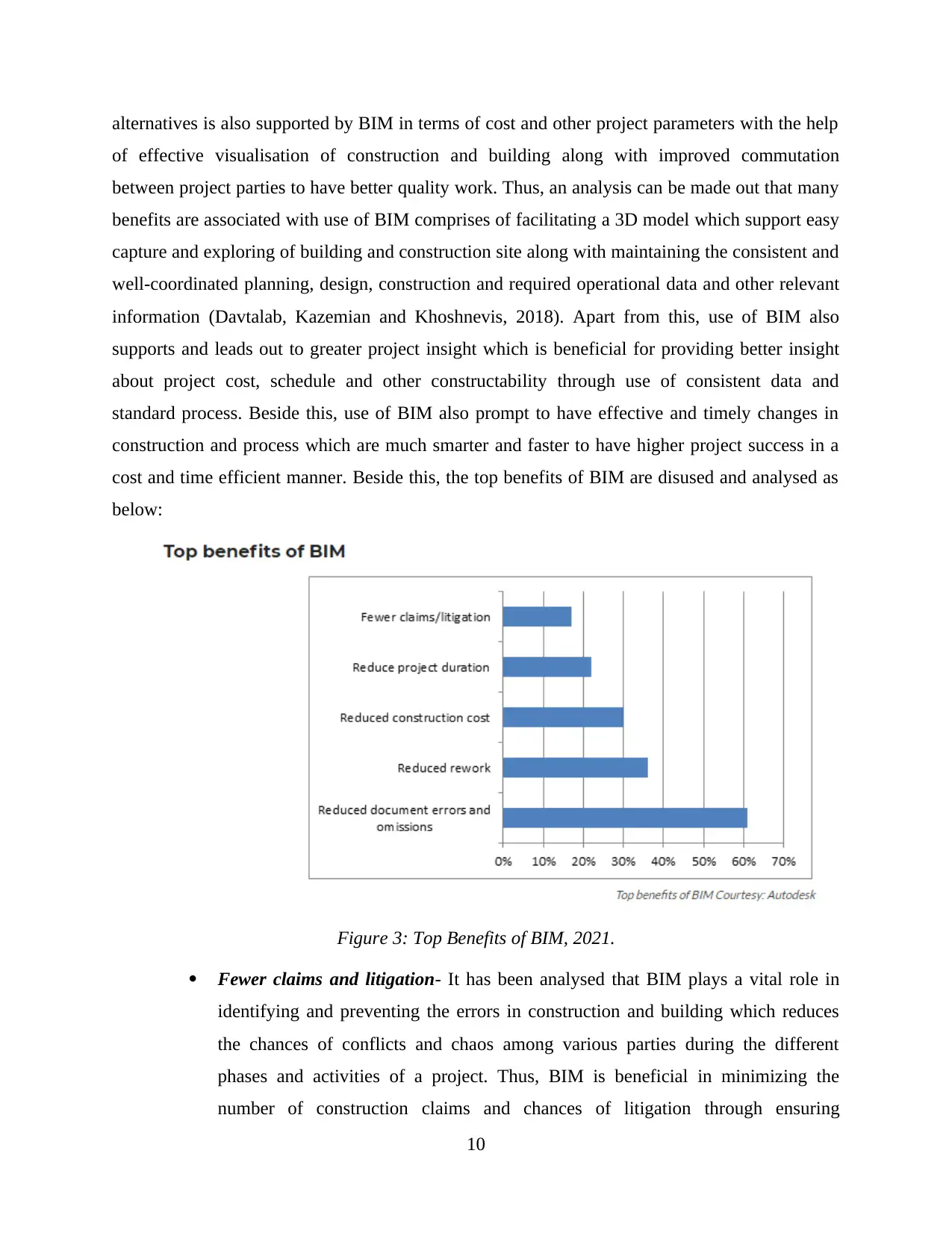
alternatives is also supported by BIM in terms of cost and other project parameters with the help
of effective visualisation of construction and building along with improved commutation
between project parties to have better quality work. Thus, an analysis can be made out that many
benefits are associated with use of BIM comprises of facilitating a 3D model which support easy
capture and exploring of building and construction site along with maintaining the consistent and
well-coordinated planning, design, construction and required operational data and other relevant
information (Davtalab, Kazemian and Khoshnevis, 2018). Apart from this, use of BIM also
supports and leads out to greater project insight which is beneficial for providing better insight
about project cost, schedule and other constructability through use of consistent data and
standard process. Beside this, use of BIM also prompt to have effective and timely changes in
construction and process which are much smarter and faster to have higher project success in a
cost and time efficient manner. Beside this, the top benefits of BIM are disused and analysed as
below:
Figure 3: Top Benefits of BIM, 2021.
Fewer claims and litigation- It has been analysed that BIM plays a vital role in
identifying and preventing the errors in construction and building which reduces
the chances of conflicts and chaos among various parties during the different
phases and activities of a project. Thus, BIM is beneficial in minimizing the
number of construction claims and chances of litigation through ensuring
10
of effective visualisation of construction and building along with improved commutation
between project parties to have better quality work. Thus, an analysis can be made out that many
benefits are associated with use of BIM comprises of facilitating a 3D model which support easy
capture and exploring of building and construction site along with maintaining the consistent and
well-coordinated planning, design, construction and required operational data and other relevant
information (Davtalab, Kazemian and Khoshnevis, 2018). Apart from this, use of BIM also
supports and leads out to greater project insight which is beneficial for providing better insight
about project cost, schedule and other constructability through use of consistent data and
standard process. Beside this, use of BIM also prompt to have effective and timely changes in
construction and process which are much smarter and faster to have higher project success in a
cost and time efficient manner. Beside this, the top benefits of BIM are disused and analysed as
below:
Figure 3: Top Benefits of BIM, 2021.
Fewer claims and litigation- It has been analysed that BIM plays a vital role in
identifying and preventing the errors in construction and building which reduces
the chances of conflicts and chaos among various parties during the different
phases and activities of a project. Thus, BIM is beneficial in minimizing the
number of construction claims and chances of litigation through ensuring
10
Paraphrase This Document
Need a fresh take? Get an instant paraphrase of this document with our AI Paraphraser
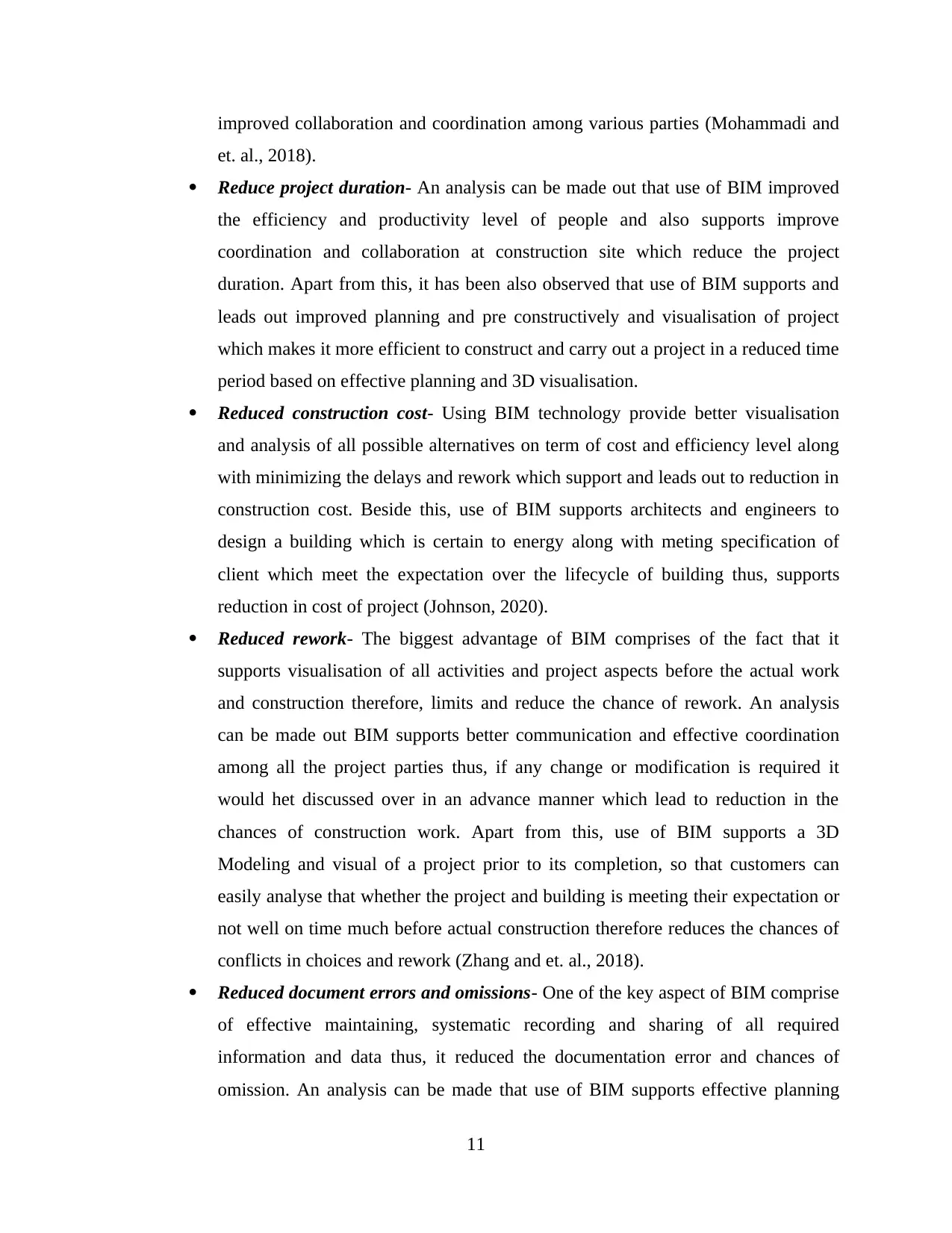
improved collaboration and coordination among various parties (Mohammadi and
et. al., 2018).
Reduce project duration- An analysis can be made out that use of BIM improved
the efficiency and productivity level of people and also supports improve
coordination and collaboration at construction site which reduce the project
duration. Apart from this, it has been also observed that use of BIM supports and
leads out improved planning and pre constructively and visualisation of project
which makes it more efficient to construct and carry out a project in a reduced time
period based on effective planning and 3D visualisation.
Reduced construction cost- Using BIM technology provide better visualisation
and analysis of all possible alternatives on term of cost and efficiency level along
with minimizing the delays and rework which support and leads out to reduction in
construction cost. Beside this, use of BIM supports architects and engineers to
design a building which is certain to energy along with meting specification of
client which meet the expectation over the lifecycle of building thus, supports
reduction in cost of project (Johnson, 2020).
Reduced rework- The biggest advantage of BIM comprises of the fact that it
supports visualisation of all activities and project aspects before the actual work
and construction therefore, limits and reduce the chance of rework. An analysis
can be made out BIM supports better communication and effective coordination
among all the project parties thus, if any change or modification is required it
would het discussed over in an advance manner which lead to reduction in the
chances of construction work. Apart from this, use of BIM supports a 3D
Modeling and visual of a project prior to its completion, so that customers can
easily analyse that whether the project and building is meeting their expectation or
not well on time much before actual construction therefore reduces the chances of
conflicts in choices and rework (Zhang and et. al., 2018).
Reduced document errors and omissions- One of the key aspect of BIM comprise
of effective maintaining, systematic recording and sharing of all required
information and data thus, it reduced the documentation error and chances of
omission. An analysis can be made that use of BIM supports effective planning
11
et. al., 2018).
Reduce project duration- An analysis can be made out that use of BIM improved
the efficiency and productivity level of people and also supports improve
coordination and collaboration at construction site which reduce the project
duration. Apart from this, it has been also observed that use of BIM supports and
leads out improved planning and pre constructively and visualisation of project
which makes it more efficient to construct and carry out a project in a reduced time
period based on effective planning and 3D visualisation.
Reduced construction cost- Using BIM technology provide better visualisation
and analysis of all possible alternatives on term of cost and efficiency level along
with minimizing the delays and rework which support and leads out to reduction in
construction cost. Beside this, use of BIM supports architects and engineers to
design a building which is certain to energy along with meting specification of
client which meet the expectation over the lifecycle of building thus, supports
reduction in cost of project (Johnson, 2020).
Reduced rework- The biggest advantage of BIM comprises of the fact that it
supports visualisation of all activities and project aspects before the actual work
and construction therefore, limits and reduce the chance of rework. An analysis
can be made out BIM supports better communication and effective coordination
among all the project parties thus, if any change or modification is required it
would het discussed over in an advance manner which lead to reduction in the
chances of construction work. Apart from this, use of BIM supports a 3D
Modeling and visual of a project prior to its completion, so that customers can
easily analyse that whether the project and building is meeting their expectation or
not well on time much before actual construction therefore reduces the chances of
conflicts in choices and rework (Zhang and et. al., 2018).
Reduced document errors and omissions- One of the key aspect of BIM comprise
of effective maintaining, systematic recording and sharing of all required
information and data thus, it reduced the documentation error and chances of
omission. An analysis can be made that use of BIM supports effective planning
11
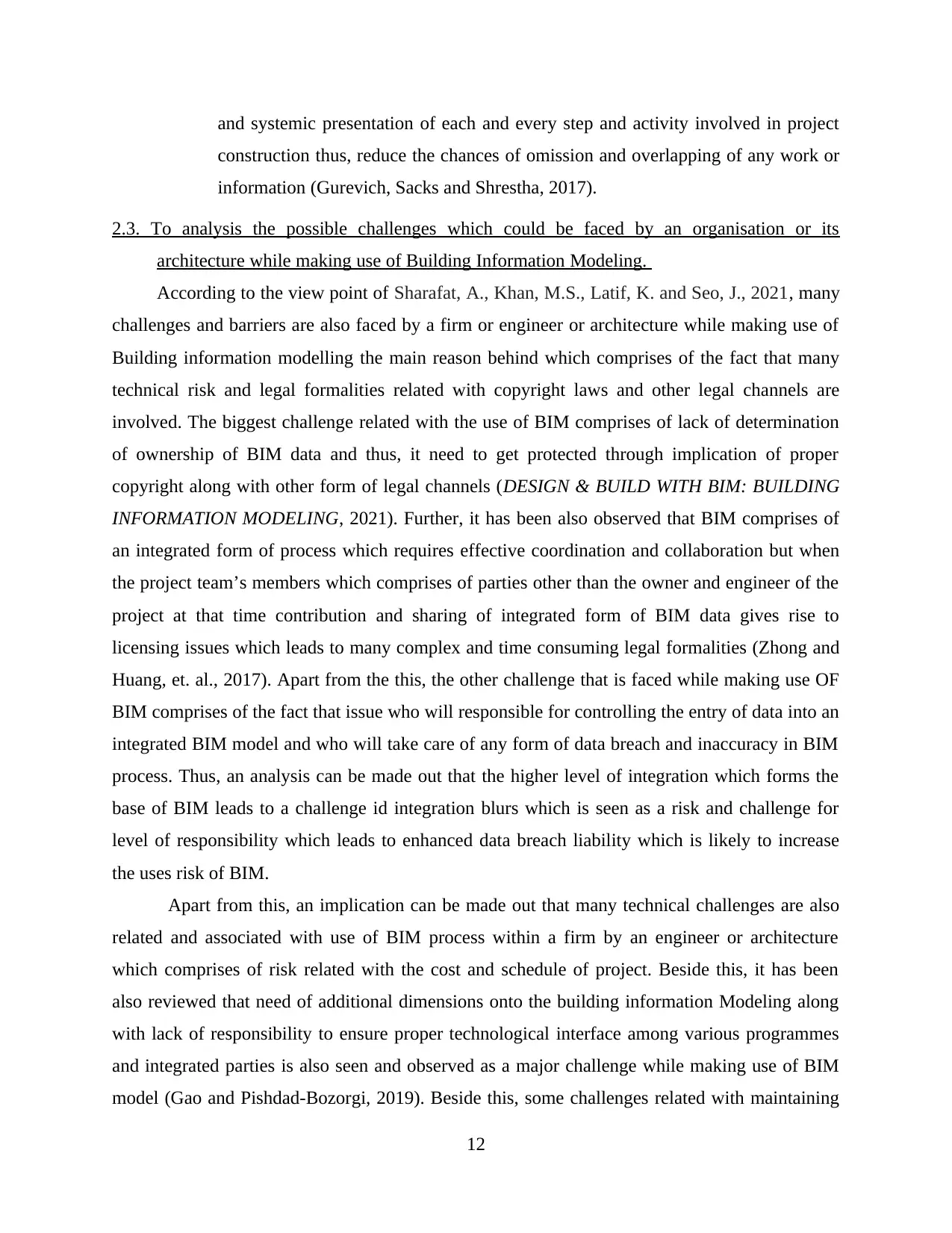
and systemic presentation of each and every step and activity involved in project
construction thus, reduce the chances of omission and overlapping of any work or
information (Gurevich, Sacks and Shrestha, 2017).
2.3. To analysis the possible challenges which could be faced by an organisation or its
architecture while making use of Building Information Modeling.
According to the view point of Sharafat, A., Khan, M.S., Latif, K. and Seo, J., 2021, many
challenges and barriers are also faced by a firm or engineer or architecture while making use of
Building information modelling the main reason behind which comprises of the fact that many
technical risk and legal formalities related with copyright laws and other legal channels are
involved. The biggest challenge related with the use of BIM comprises of lack of determination
of ownership of BIM data and thus, it need to get protected through implication of proper
copyright along with other form of legal channels (DESIGN & BUILD WITH BIM: BUILDING
INFORMATION MODELING, 2021). Further, it has been also observed that BIM comprises of
an integrated form of process which requires effective coordination and collaboration but when
the project team’s members which comprises of parties other than the owner and engineer of the
project at that time contribution and sharing of integrated form of BIM data gives rise to
licensing issues which leads to many complex and time consuming legal formalities (Zhong and
Huang, et. al., 2017). Apart from the this, the other challenge that is faced while making use OF
BIM comprises of the fact that issue who will responsible for controlling the entry of data into an
integrated BIM model and who will take care of any form of data breach and inaccuracy in BIM
process. Thus, an analysis can be made out that the higher level of integration which forms the
base of BIM leads to a challenge id integration blurs which is seen as a risk and challenge for
level of responsibility which leads to enhanced data breach liability which is likely to increase
the uses risk of BIM.
Apart from this, an implication can be made out that many technical challenges are also
related and associated with use of BIM process within a firm by an engineer or architecture
which comprises of risk related with the cost and schedule of project. Beside this, it has been
also reviewed that need of additional dimensions onto the building information Modeling along
with lack of responsibility to ensure proper technological interface among various programmes
and integrated parties is also seen and observed as a major challenge while making use of BIM
model (Gao and Pishdad-Bozorgi, 2019). Beside this, some challenges related with maintaining
12
construction thus, reduce the chances of omission and overlapping of any work or
information (Gurevich, Sacks and Shrestha, 2017).
2.3. To analysis the possible challenges which could be faced by an organisation or its
architecture while making use of Building Information Modeling.
According to the view point of Sharafat, A., Khan, M.S., Latif, K. and Seo, J., 2021, many
challenges and barriers are also faced by a firm or engineer or architecture while making use of
Building information modelling the main reason behind which comprises of the fact that many
technical risk and legal formalities related with copyright laws and other legal channels are
involved. The biggest challenge related with the use of BIM comprises of lack of determination
of ownership of BIM data and thus, it need to get protected through implication of proper
copyright along with other form of legal channels (DESIGN & BUILD WITH BIM: BUILDING
INFORMATION MODELING, 2021). Further, it has been also observed that BIM comprises of
an integrated form of process which requires effective coordination and collaboration but when
the project team’s members which comprises of parties other than the owner and engineer of the
project at that time contribution and sharing of integrated form of BIM data gives rise to
licensing issues which leads to many complex and time consuming legal formalities (Zhong and
Huang, et. al., 2017). Apart from the this, the other challenge that is faced while making use OF
BIM comprises of the fact that issue who will responsible for controlling the entry of data into an
integrated BIM model and who will take care of any form of data breach and inaccuracy in BIM
process. Thus, an analysis can be made out that the higher level of integration which forms the
base of BIM leads to a challenge id integration blurs which is seen as a risk and challenge for
level of responsibility which leads to enhanced data breach liability which is likely to increase
the uses risk of BIM.
Apart from this, an implication can be made out that many technical challenges are also
related and associated with use of BIM process within a firm by an engineer or architecture
which comprises of risk related with the cost and schedule of project. Beside this, it has been
also reviewed that need of additional dimensions onto the building information Modeling along
with lack of responsibility to ensure proper technological interface among various programmes
and integrated parties is also seen and observed as a major challenge while making use of BIM
model (Gao and Pishdad-Bozorgi, 2019). Beside this, some challenges related with maintaining
12
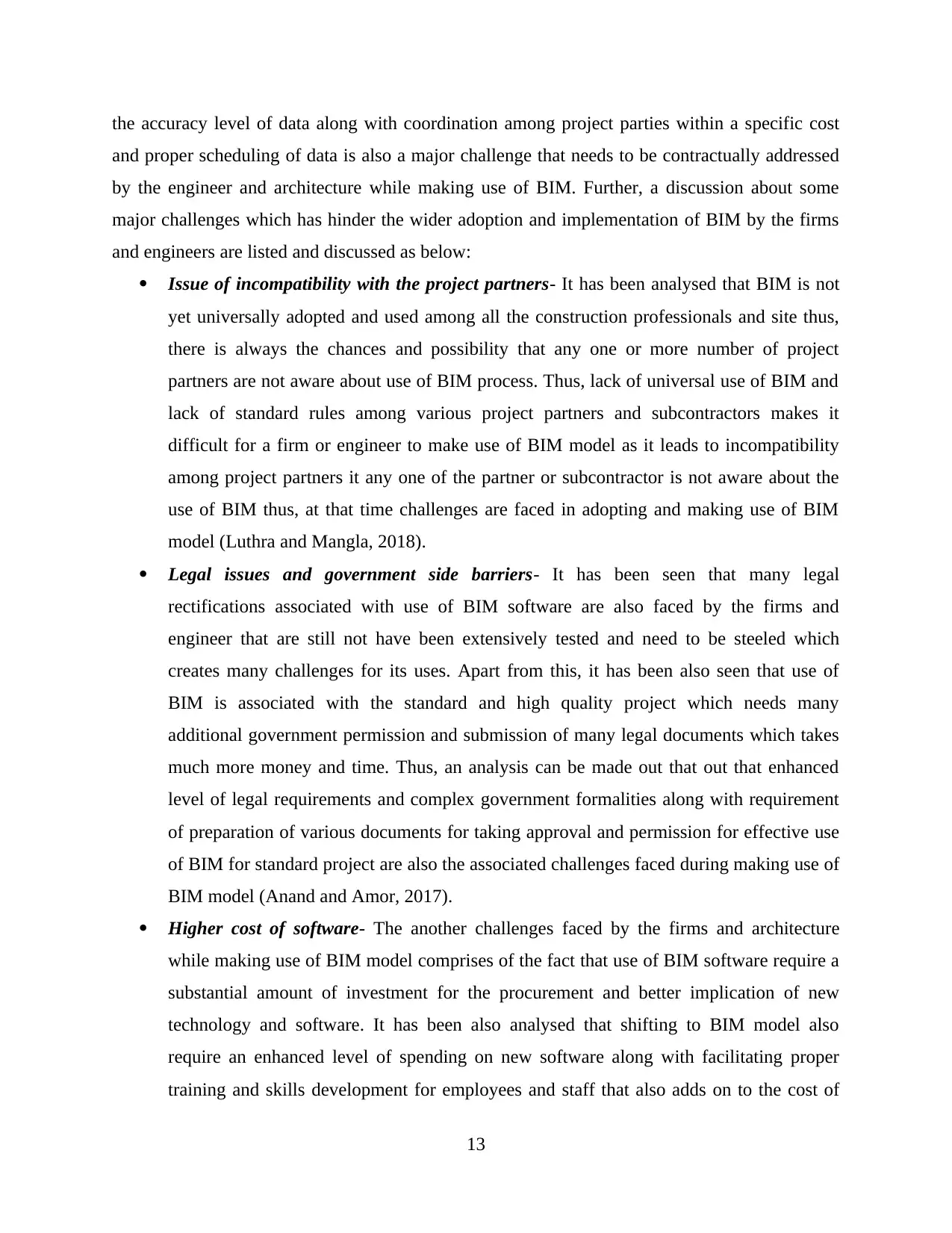
the accuracy level of data along with coordination among project parties within a specific cost
and proper scheduling of data is also a major challenge that needs to be contractually addressed
by the engineer and architecture while making use of BIM. Further, a discussion about some
major challenges which has hinder the wider adoption and implementation of BIM by the firms
and engineers are listed and discussed as below:
Issue of incompatibility with the project partners- It has been analysed that BIM is not
yet universally adopted and used among all the construction professionals and site thus,
there is always the chances and possibility that any one or more number of project
partners are not aware about use of BIM process. Thus, lack of universal use of BIM and
lack of standard rules among various project partners and subcontractors makes it
difficult for a firm or engineer to make use of BIM model as it leads to incompatibility
among project partners it any one of the partner or subcontractor is not aware about the
use of BIM thus, at that time challenges are faced in adopting and making use of BIM
model (Luthra and Mangla, 2018).
Legal issues and government side barriers- It has been seen that many legal
rectifications associated with use of BIM software are also faced by the firms and
engineer that are still not have been extensively tested and need to be steeled which
creates many challenges for its uses. Apart from this, it has been also seen that use of
BIM is associated with the standard and high quality project which needs many
additional government permission and submission of many legal documents which takes
much more money and time. Thus, an analysis can be made out that out that enhanced
level of legal requirements and complex government formalities along with requirement
of preparation of various documents for taking approval and permission for effective use
of BIM for standard project are also the associated challenges faced during making use of
BIM model (Anand and Amor, 2017).
Higher cost of software- The another challenges faced by the firms and architecture
while making use of BIM model comprises of the fact that use of BIM software require a
substantial amount of investment for the procurement and better implication of new
technology and software. It has been also analysed that shifting to BIM model also
require an enhanced level of spending on new software along with facilitating proper
training and skills development for employees and staff that also adds on to the cost of
13
and proper scheduling of data is also a major challenge that needs to be contractually addressed
by the engineer and architecture while making use of BIM. Further, a discussion about some
major challenges which has hinder the wider adoption and implementation of BIM by the firms
and engineers are listed and discussed as below:
Issue of incompatibility with the project partners- It has been analysed that BIM is not
yet universally adopted and used among all the construction professionals and site thus,
there is always the chances and possibility that any one or more number of project
partners are not aware about use of BIM process. Thus, lack of universal use of BIM and
lack of standard rules among various project partners and subcontractors makes it
difficult for a firm or engineer to make use of BIM model as it leads to incompatibility
among project partners it any one of the partner or subcontractor is not aware about the
use of BIM thus, at that time challenges are faced in adopting and making use of BIM
model (Luthra and Mangla, 2018).
Legal issues and government side barriers- It has been seen that many legal
rectifications associated with use of BIM software are also faced by the firms and
engineer that are still not have been extensively tested and need to be steeled which
creates many challenges for its uses. Apart from this, it has been also seen that use of
BIM is associated with the standard and high quality project which needs many
additional government permission and submission of many legal documents which takes
much more money and time. Thus, an analysis can be made out that out that enhanced
level of legal requirements and complex government formalities along with requirement
of preparation of various documents for taking approval and permission for effective use
of BIM for standard project are also the associated challenges faced during making use of
BIM model (Anand and Amor, 2017).
Higher cost of software- The another challenges faced by the firms and architecture
while making use of BIM model comprises of the fact that use of BIM software require a
substantial amount of investment for the procurement and better implication of new
technology and software. It has been also analysed that shifting to BIM model also
require an enhanced level of spending on new software along with facilitating proper
training and skills development for employees and staff that also adds on to the cost of
13
Secure Best Marks with AI Grader
Need help grading? Try our AI Grader for instant feedback on your assignments.
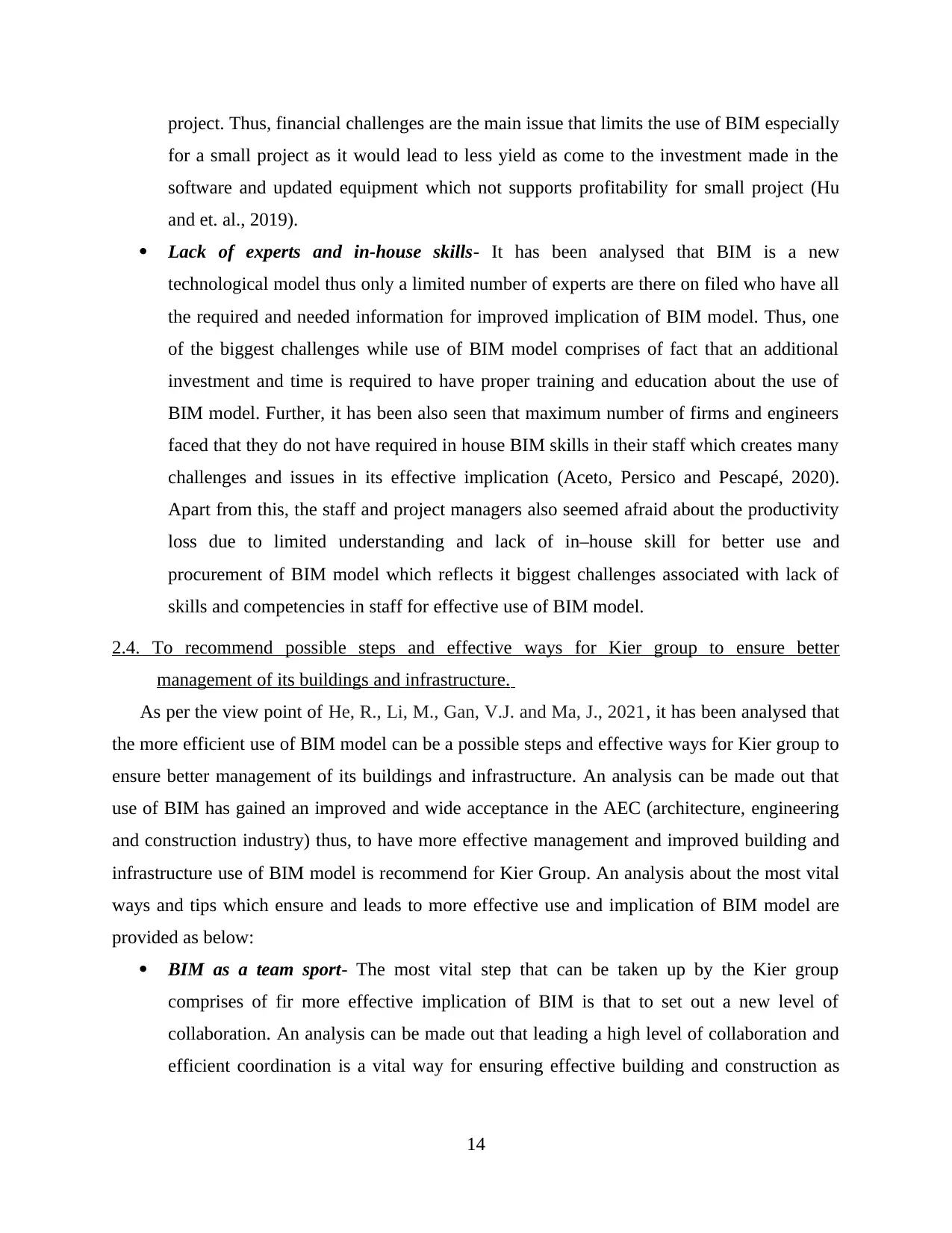
project. Thus, financial challenges are the main issue that limits the use of BIM especially
for a small project as it would lead to less yield as come to the investment made in the
software and updated equipment which not supports profitability for small project (Hu
and et. al., 2019).
Lack of experts and in-house skills- It has been analysed that BIM is a new
technological model thus only a limited number of experts are there on filed who have all
the required and needed information for improved implication of BIM model. Thus, one
of the biggest challenges while use of BIM model comprises of fact that an additional
investment and time is required to have proper training and education about the use of
BIM model. Further, it has been also seen that maximum number of firms and engineers
faced that they do not have required in house BIM skills in their staff which creates many
challenges and issues in its effective implication (Aceto, Persico and Pescapé, 2020).
Apart from this, the staff and project managers also seemed afraid about the productivity
loss due to limited understanding and lack of in–house skill for better use and
procurement of BIM model which reflects it biggest challenges associated with lack of
skills and competencies in staff for effective use of BIM model.
2.4. To recommend possible steps and effective ways for Kier group to ensure better
management of its buildings and infrastructure.
As per the view point of He, R., Li, M., Gan, V.J. and Ma, J., 2021, it has been analysed that
the more efficient use of BIM model can be a possible steps and effective ways for Kier group to
ensure better management of its buildings and infrastructure. An analysis can be made out that
use of BIM has gained an improved and wide acceptance in the AEC (architecture, engineering
and construction industry) thus, to have more effective management and improved building and
infrastructure use of BIM model is recommend for Kier Group. An analysis about the most vital
ways and tips which ensure and leads to more effective use and implication of BIM model are
provided as below:
BIM as a team sport- The most vital step that can be taken up by the Kier group
comprises of fir more effective implication of BIM is that to set out a new level of
collaboration. An analysis can be made out that leading a high level of collaboration and
efficient coordination is a vital way for ensuring effective building and construction as
14
for a small project as it would lead to less yield as come to the investment made in the
software and updated equipment which not supports profitability for small project (Hu
and et. al., 2019).
Lack of experts and in-house skills- It has been analysed that BIM is a new
technological model thus only a limited number of experts are there on filed who have all
the required and needed information for improved implication of BIM model. Thus, one
of the biggest challenges while use of BIM model comprises of fact that an additional
investment and time is required to have proper training and education about the use of
BIM model. Further, it has been also seen that maximum number of firms and engineers
faced that they do not have required in house BIM skills in their staff which creates many
challenges and issues in its effective implication (Aceto, Persico and Pescapé, 2020).
Apart from this, the staff and project managers also seemed afraid about the productivity
loss due to limited understanding and lack of in–house skill for better use and
procurement of BIM model which reflects it biggest challenges associated with lack of
skills and competencies in staff for effective use of BIM model.
2.4. To recommend possible steps and effective ways for Kier group to ensure better
management of its buildings and infrastructure.
As per the view point of He, R., Li, M., Gan, V.J. and Ma, J., 2021, it has been analysed that
the more efficient use of BIM model can be a possible steps and effective ways for Kier group to
ensure better management of its buildings and infrastructure. An analysis can be made out that
use of BIM has gained an improved and wide acceptance in the AEC (architecture, engineering
and construction industry) thus, to have more effective management and improved building and
infrastructure use of BIM model is recommend for Kier Group. An analysis about the most vital
ways and tips which ensure and leads to more effective use and implication of BIM model are
provided as below:
BIM as a team sport- The most vital step that can be taken up by the Kier group
comprises of fir more effective implication of BIM is that to set out a new level of
collaboration. An analysis can be made out that leading a high level of collaboration and
efficient coordination is a vital way for ensuring effective building and construction as
14
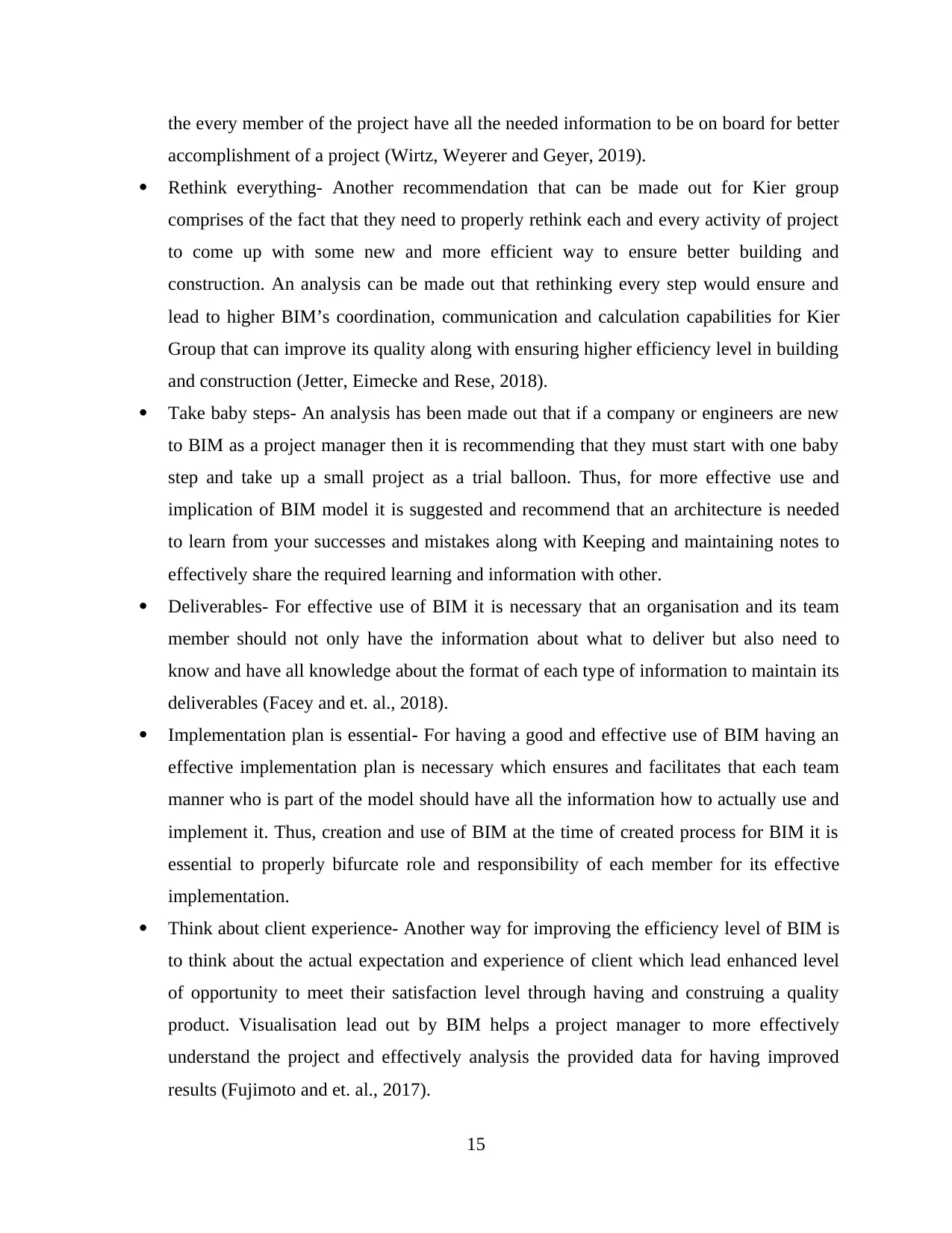
the every member of the project have all the needed information to be on board for better
accomplishment of a project (Wirtz, Weyerer and Geyer, 2019).
Rethink everything- Another recommendation that can be made out for Kier group
comprises of the fact that they need to properly rethink each and every activity of project
to come up with some new and more efficient way to ensure better building and
construction. An analysis can be made out that rethinking every step would ensure and
lead to higher BIM’s coordination, communication and calculation capabilities for Kier
Group that can improve its quality along with ensuring higher efficiency level in building
and construction (Jetter, Eimecke and Rese, 2018).
Take baby steps- An analysis has been made out that if a company or engineers are new
to BIM as a project manager then it is recommending that they must start with one baby
step and take up a small project as a trial balloon. Thus, for more effective use and
implication of BIM model it is suggested and recommend that an architecture is needed
to learn from your successes and mistakes along with Keeping and maintaining notes to
effectively share the required learning and information with other.
Deliverables- For effective use of BIM it is necessary that an organisation and its team
member should not only have the information about what to deliver but also need to
know and have all knowledge about the format of each type of information to maintain its
deliverables (Facey and et. al., 2018).
Implementation plan is essential- For having a good and effective use of BIM having an
effective implementation plan is necessary which ensures and facilitates that each team
manner who is part of the model should have all the information how to actually use and
implement it. Thus, creation and use of BIM at the time of created process for BIM it is
essential to properly bifurcate role and responsibility of each member for its effective
implementation.
Think about client experience- Another way for improving the efficiency level of BIM is
to think about the actual expectation and experience of client which lead enhanced level
of opportunity to meet their satisfaction level through having and construing a quality
product. Visualisation lead out by BIM helps a project manager to more effectively
understand the project and effectively analysis the provided data for having improved
results (Fujimoto and et. al., 2017).
15
accomplishment of a project (Wirtz, Weyerer and Geyer, 2019).
Rethink everything- Another recommendation that can be made out for Kier group
comprises of the fact that they need to properly rethink each and every activity of project
to come up with some new and more efficient way to ensure better building and
construction. An analysis can be made out that rethinking every step would ensure and
lead to higher BIM’s coordination, communication and calculation capabilities for Kier
Group that can improve its quality along with ensuring higher efficiency level in building
and construction (Jetter, Eimecke and Rese, 2018).
Take baby steps- An analysis has been made out that if a company or engineers are new
to BIM as a project manager then it is recommending that they must start with one baby
step and take up a small project as a trial balloon. Thus, for more effective use and
implication of BIM model it is suggested and recommend that an architecture is needed
to learn from your successes and mistakes along with Keeping and maintaining notes to
effectively share the required learning and information with other.
Deliverables- For effective use of BIM it is necessary that an organisation and its team
member should not only have the information about what to deliver but also need to
know and have all knowledge about the format of each type of information to maintain its
deliverables (Facey and et. al., 2018).
Implementation plan is essential- For having a good and effective use of BIM having an
effective implementation plan is necessary which ensures and facilitates that each team
manner who is part of the model should have all the information how to actually use and
implement it. Thus, creation and use of BIM at the time of created process for BIM it is
essential to properly bifurcate role and responsibility of each member for its effective
implementation.
Think about client experience- Another way for improving the efficiency level of BIM is
to think about the actual expectation and experience of client which lead enhanced level
of opportunity to meet their satisfaction level through having and construing a quality
product. Visualisation lead out by BIM helps a project manager to more effectively
understand the project and effectively analysis the provided data for having improved
results (Fujimoto and et. al., 2017).
15
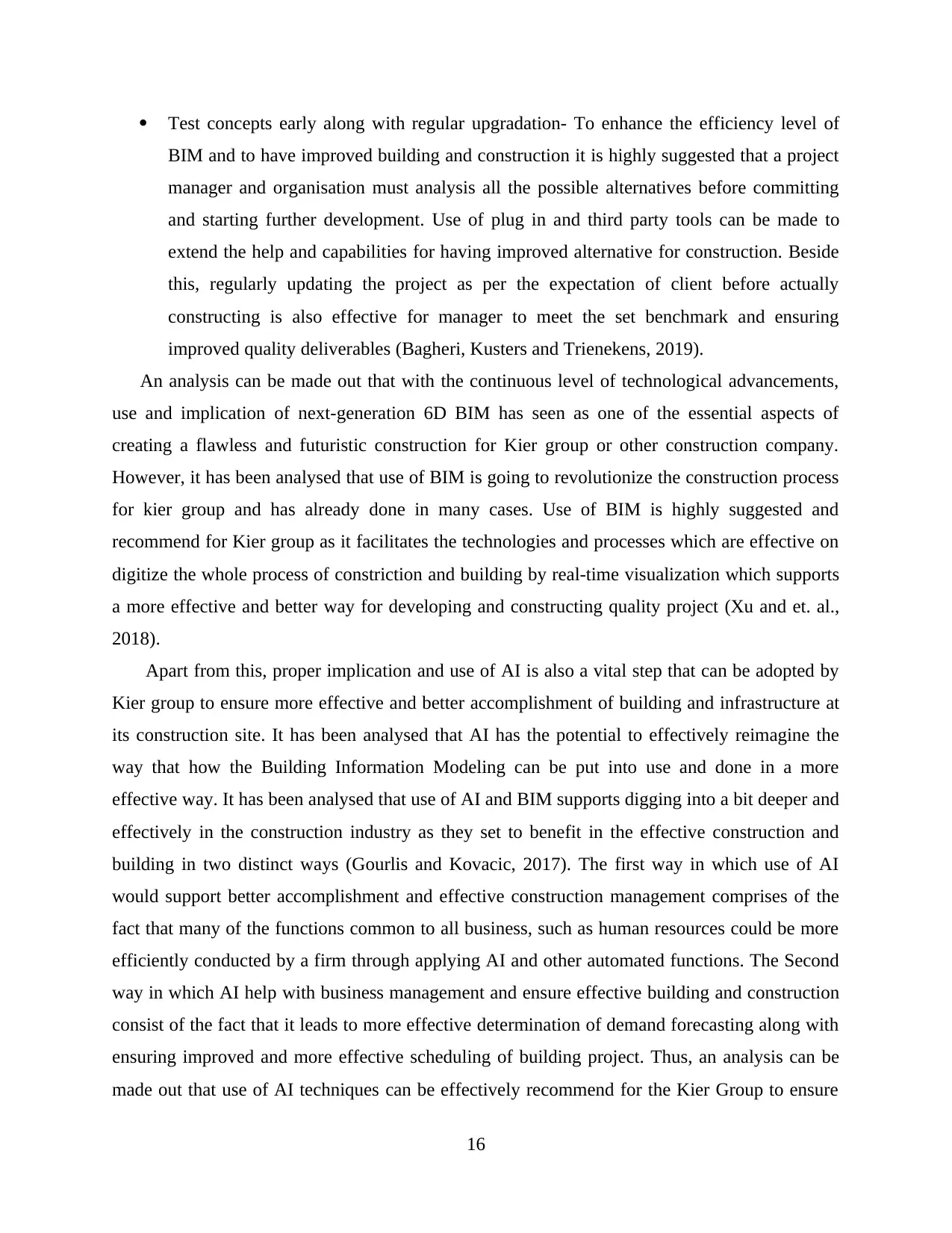
Test concepts early along with regular upgradation- To enhance the efficiency level of
BIM and to have improved building and construction it is highly suggested that a project
manager and organisation must analysis all the possible alternatives before committing
and starting further development. Use of plug in and third party tools can be made to
extend the help and capabilities for having improved alternative for construction. Beside
this, regularly updating the project as per the expectation of client before actually
constructing is also effective for manager to meet the set benchmark and ensuring
improved quality deliverables (Bagheri, Kusters and Trienekens, 2019).
An analysis can be made out that with the continuous level of technological advancements,
use and implication of next-generation 6D BIM has seen as one of the essential aspects of
creating a flawless and futuristic construction for Kier group or other construction company.
However, it has been analysed that use of BIM is going to revolutionize the construction process
for kier group and has already done in many cases. Use of BIM is highly suggested and
recommend for Kier group as it facilitates the technologies and processes which are effective on
digitize the whole process of constriction and building by real-time visualization which supports
a more effective and better way for developing and constructing quality project (Xu and et. al.,
2018).
Apart from this, proper implication and use of AI is also a vital step that can be adopted by
Kier group to ensure more effective and better accomplishment of building and infrastructure at
its construction site. It has been analysed that AI has the potential to effectively reimagine the
way that how the Building Information Modeling can be put into use and done in a more
effective way. It has been analysed that use of AI and BIM supports digging into a bit deeper and
effectively in the construction industry as they set to benefit in the effective construction and
building in two distinct ways (Gourlis and Kovacic, 2017). The first way in which use of AI
would support better accomplishment and effective construction management comprises of the
fact that many of the functions common to all business, such as human resources could be more
efficiently conducted by a firm through applying AI and other automated functions. The Second
way in which AI help with business management and ensure effective building and construction
consist of the fact that it leads to more effective determination of demand forecasting along with
ensuring improved and more effective scheduling of building project. Thus, an analysis can be
made out that use of AI techniques can be effectively recommend for the Kier Group to ensure
16
BIM and to have improved building and construction it is highly suggested that a project
manager and organisation must analysis all the possible alternatives before committing
and starting further development. Use of plug in and third party tools can be made to
extend the help and capabilities for having improved alternative for construction. Beside
this, regularly updating the project as per the expectation of client before actually
constructing is also effective for manager to meet the set benchmark and ensuring
improved quality deliverables (Bagheri, Kusters and Trienekens, 2019).
An analysis can be made out that with the continuous level of technological advancements,
use and implication of next-generation 6D BIM has seen as one of the essential aspects of
creating a flawless and futuristic construction for Kier group or other construction company.
However, it has been analysed that use of BIM is going to revolutionize the construction process
for kier group and has already done in many cases. Use of BIM is highly suggested and
recommend for Kier group as it facilitates the technologies and processes which are effective on
digitize the whole process of constriction and building by real-time visualization which supports
a more effective and better way for developing and constructing quality project (Xu and et. al.,
2018).
Apart from this, proper implication and use of AI is also a vital step that can be adopted by
Kier group to ensure more effective and better accomplishment of building and infrastructure at
its construction site. It has been analysed that AI has the potential to effectively reimagine the
way that how the Building Information Modeling can be put into use and done in a more
effective way. It has been analysed that use of AI and BIM supports digging into a bit deeper and
effectively in the construction industry as they set to benefit in the effective construction and
building in two distinct ways (Gourlis and Kovacic, 2017). The first way in which use of AI
would support better accomplishment and effective construction management comprises of the
fact that many of the functions common to all business, such as human resources could be more
efficiently conducted by a firm through applying AI and other automated functions. The Second
way in which AI help with business management and ensure effective building and construction
consist of the fact that it leads to more effective determination of demand forecasting along with
ensuring improved and more effective scheduling of building project. Thus, an analysis can be
made out that use of AI techniques can be effectively recommend for the Kier Group to ensure
16
Paraphrase This Document
Need a fresh take? Get an instant paraphrase of this document with our AI Paraphraser
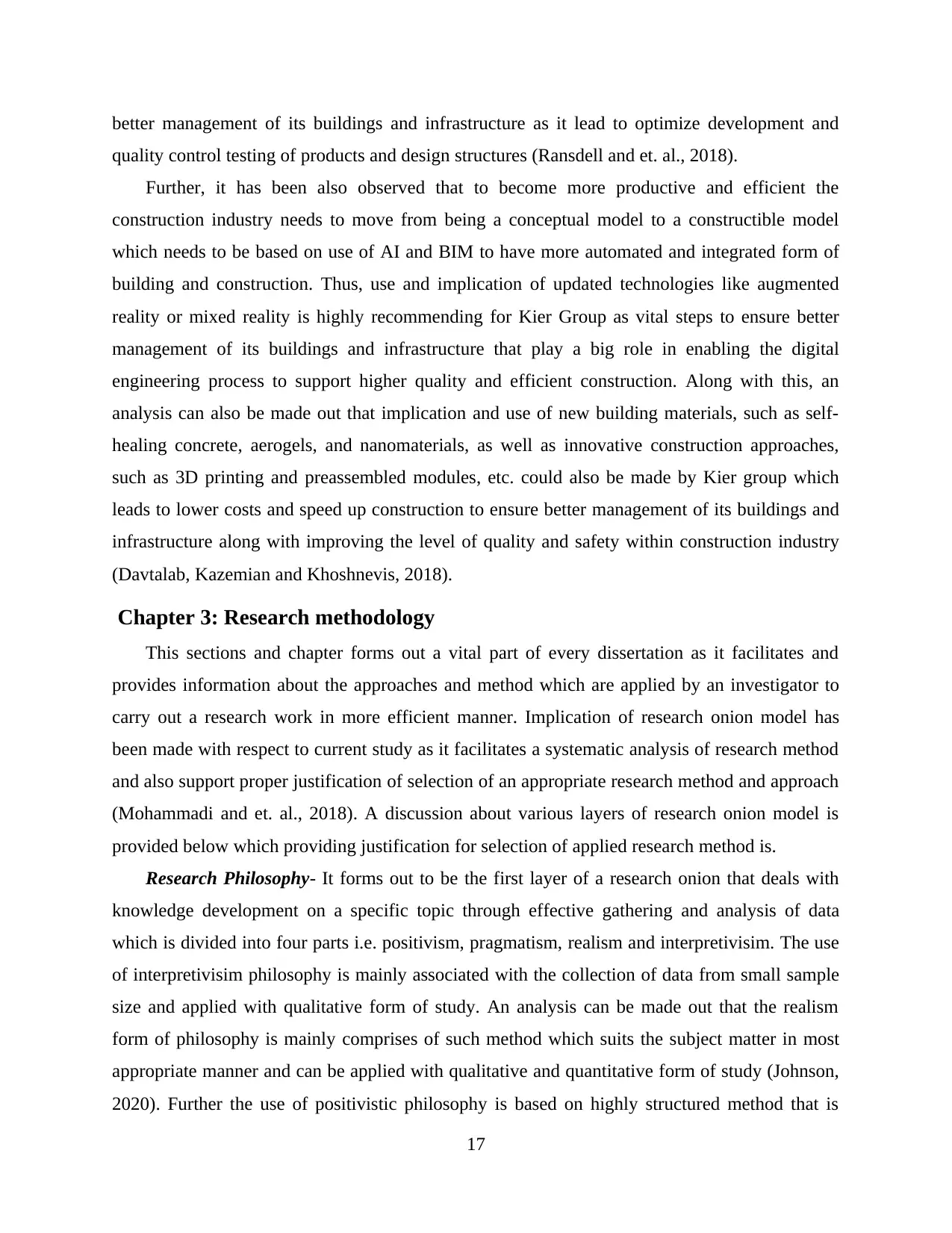
better management of its buildings and infrastructure as it lead to optimize development and
quality control testing of products and design structures (Ransdell and et. al., 2018).
Further, it has been also observed that to become more productive and efficient the
construction industry needs to move from being a conceptual model to a constructible model
which needs to be based on use of AI and BIM to have more automated and integrated form of
building and construction. Thus, use and implication of updated technologies like augmented
reality or mixed reality is highly recommending for Kier Group as vital steps to ensure better
management of its buildings and infrastructure that play a big role in enabling the digital
engineering process to support higher quality and efficient construction. Along with this, an
analysis can also be made out that implication and use of new building materials, such as self-
healing concrete, aerogels, and nanomaterials, as well as innovative construction approaches,
such as 3D printing and preassembled modules, etc. could also be made by Kier group which
leads to lower costs and speed up construction to ensure better management of its buildings and
infrastructure along with improving the level of quality and safety within construction industry
(Davtalab, Kazemian and Khoshnevis, 2018).
Chapter 3: Research methodology
This sections and chapter forms out a vital part of every dissertation as it facilitates and
provides information about the approaches and method which are applied by an investigator to
carry out a research work in more efficient manner. Implication of research onion model has
been made with respect to current study as it facilitates a systematic analysis of research method
and also support proper justification of selection of an appropriate research method and approach
(Mohammadi and et. al., 2018). A discussion about various layers of research onion model is
provided below which providing justification for selection of applied research method is.
Research Philosophy- It forms out to be the first layer of a research onion that deals with
knowledge development on a specific topic through effective gathering and analysis of data
which is divided into four parts i.e. positivism, pragmatism, realism and interpretivisim. The use
of interpretivisim philosophy is mainly associated with the collection of data from small sample
size and applied with qualitative form of study. An analysis can be made out that the realism
form of philosophy is mainly comprises of such method which suits the subject matter in most
appropriate manner and can be applied with qualitative and quantitative form of study (Johnson,
2020). Further the use of positivistic philosophy is based on highly structured method that is
17
quality control testing of products and design structures (Ransdell and et. al., 2018).
Further, it has been also observed that to become more productive and efficient the
construction industry needs to move from being a conceptual model to a constructible model
which needs to be based on use of AI and BIM to have more automated and integrated form of
building and construction. Thus, use and implication of updated technologies like augmented
reality or mixed reality is highly recommending for Kier Group as vital steps to ensure better
management of its buildings and infrastructure that play a big role in enabling the digital
engineering process to support higher quality and efficient construction. Along with this, an
analysis can also be made out that implication and use of new building materials, such as self-
healing concrete, aerogels, and nanomaterials, as well as innovative construction approaches,
such as 3D printing and preassembled modules, etc. could also be made by Kier group which
leads to lower costs and speed up construction to ensure better management of its buildings and
infrastructure along with improving the level of quality and safety within construction industry
(Davtalab, Kazemian and Khoshnevis, 2018).
Chapter 3: Research methodology
This sections and chapter forms out a vital part of every dissertation as it facilitates and
provides information about the approaches and method which are applied by an investigator to
carry out a research work in more efficient manner. Implication of research onion model has
been made with respect to current study as it facilitates a systematic analysis of research method
and also support proper justification of selection of an appropriate research method and approach
(Mohammadi and et. al., 2018). A discussion about various layers of research onion model is
provided below which providing justification for selection of applied research method is.
Research Philosophy- It forms out to be the first layer of a research onion that deals with
knowledge development on a specific topic through effective gathering and analysis of data
which is divided into four parts i.e. positivism, pragmatism, realism and interpretivisim. The use
of interpretivisim philosophy is mainly associated with the collection of data from small sample
size and applied with qualitative form of study. An analysis can be made out that the realism
form of philosophy is mainly comprises of such method which suits the subject matter in most
appropriate manner and can be applied with qualitative and quantitative form of study (Johnson,
2020). Further the use of positivistic philosophy is based on highly structured method that is
17
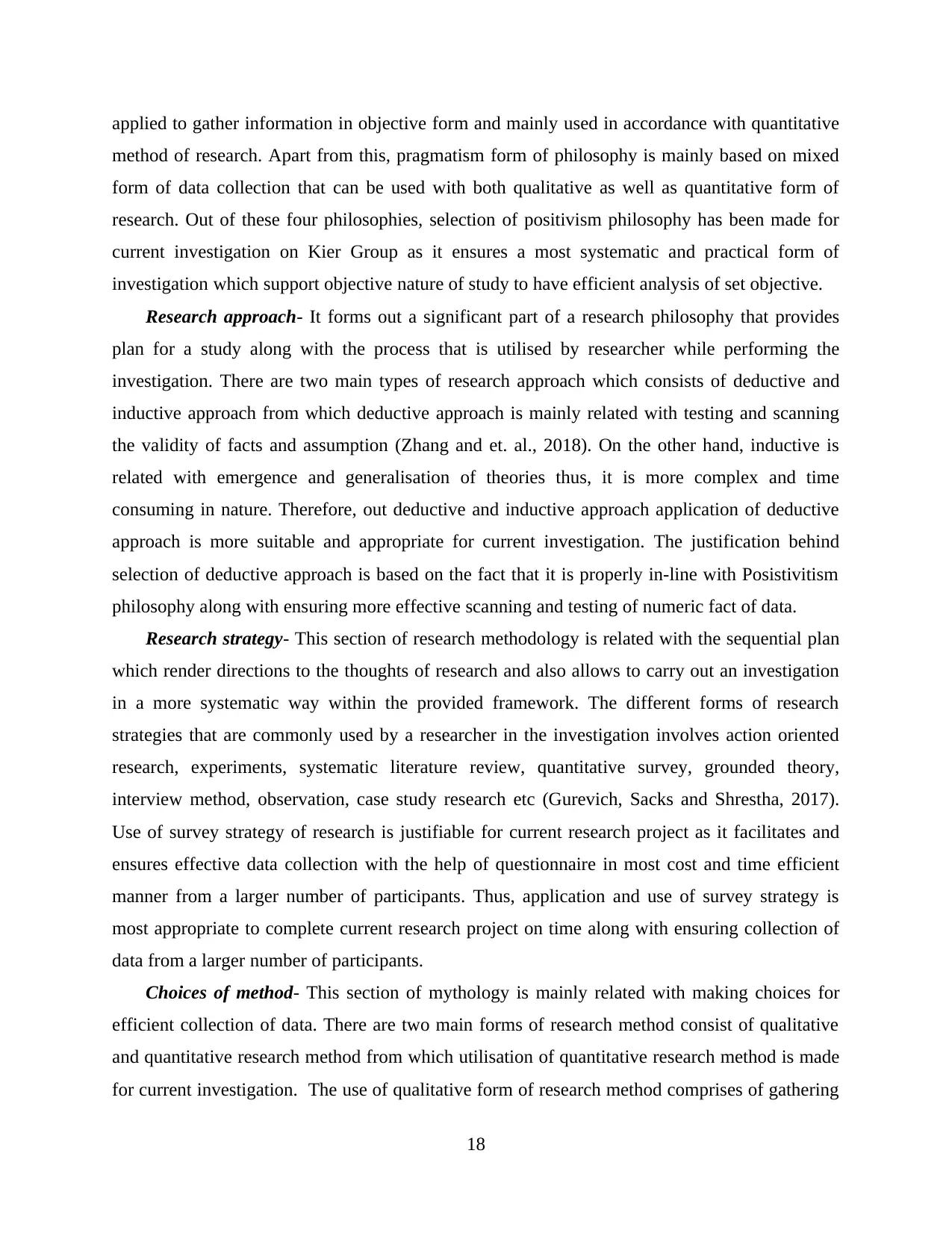
applied to gather information in objective form and mainly used in accordance with quantitative
method of research. Apart from this, pragmatism form of philosophy is mainly based on mixed
form of data collection that can be used with both qualitative as well as quantitative form of
research. Out of these four philosophies, selection of positivism philosophy has been made for
current investigation on Kier Group as it ensures a most systematic and practical form of
investigation which support objective nature of study to have efficient analysis of set objective.
Research approach- It forms out a significant part of a research philosophy that provides
plan for a study along with the process that is utilised by researcher while performing the
investigation. There are two main types of research approach which consists of deductive and
inductive approach from which deductive approach is mainly related with testing and scanning
the validity of facts and assumption (Zhang and et. al., 2018). On the other hand, inductive is
related with emergence and generalisation of theories thus, it is more complex and time
consuming in nature. Therefore, out deductive and inductive approach application of deductive
approach is more suitable and appropriate for current investigation. The justification behind
selection of deductive approach is based on the fact that it is properly in-line with Posistivitism
philosophy along with ensuring more effective scanning and testing of numeric fact of data.
Research strategy- This section of research methodology is related with the sequential plan
which render directions to the thoughts of research and also allows to carry out an investigation
in a more systematic way within the provided framework. The different forms of research
strategies that are commonly used by a researcher in the investigation involves action oriented
research, experiments, systematic literature review, quantitative survey, grounded theory,
interview method, observation, case study research etc (Gurevich, Sacks and Shrestha, 2017).
Use of survey strategy of research is justifiable for current research project as it facilitates and
ensures effective data collection with the help of questionnaire in most cost and time efficient
manner from a larger number of participants. Thus, application and use of survey strategy is
most appropriate to complete current research project on time along with ensuring collection of
data from a larger number of participants.
Choices of method- This section of mythology is mainly related with making choices for
efficient collection of data. There are two main forms of research method consist of qualitative
and quantitative research method from which utilisation of quantitative research method is made
for current investigation. The use of qualitative form of research method comprises of gathering
18
method of research. Apart from this, pragmatism form of philosophy is mainly based on mixed
form of data collection that can be used with both qualitative as well as quantitative form of
research. Out of these four philosophies, selection of positivism philosophy has been made for
current investigation on Kier Group as it ensures a most systematic and practical form of
investigation which support objective nature of study to have efficient analysis of set objective.
Research approach- It forms out a significant part of a research philosophy that provides
plan for a study along with the process that is utilised by researcher while performing the
investigation. There are two main types of research approach which consists of deductive and
inductive approach from which deductive approach is mainly related with testing and scanning
the validity of facts and assumption (Zhang and et. al., 2018). On the other hand, inductive is
related with emergence and generalisation of theories thus, it is more complex and time
consuming in nature. Therefore, out deductive and inductive approach application of deductive
approach is more suitable and appropriate for current investigation. The justification behind
selection of deductive approach is based on the fact that it is properly in-line with Posistivitism
philosophy along with ensuring more effective scanning and testing of numeric fact of data.
Research strategy- This section of research methodology is related with the sequential plan
which render directions to the thoughts of research and also allows to carry out an investigation
in a more systematic way within the provided framework. The different forms of research
strategies that are commonly used by a researcher in the investigation involves action oriented
research, experiments, systematic literature review, quantitative survey, grounded theory,
interview method, observation, case study research etc (Gurevich, Sacks and Shrestha, 2017).
Use of survey strategy of research is justifiable for current research project as it facilitates and
ensures effective data collection with the help of questionnaire in most cost and time efficient
manner from a larger number of participants. Thus, application and use of survey strategy is
most appropriate to complete current research project on time along with ensuring collection of
data from a larger number of participants.
Choices of method- This section of mythology is mainly related with making choices for
efficient collection of data. There are two main forms of research method consist of qualitative
and quantitative research method from which utilisation of quantitative research method is made
for current investigation. The use of qualitative form of research method comprises of gathering
18
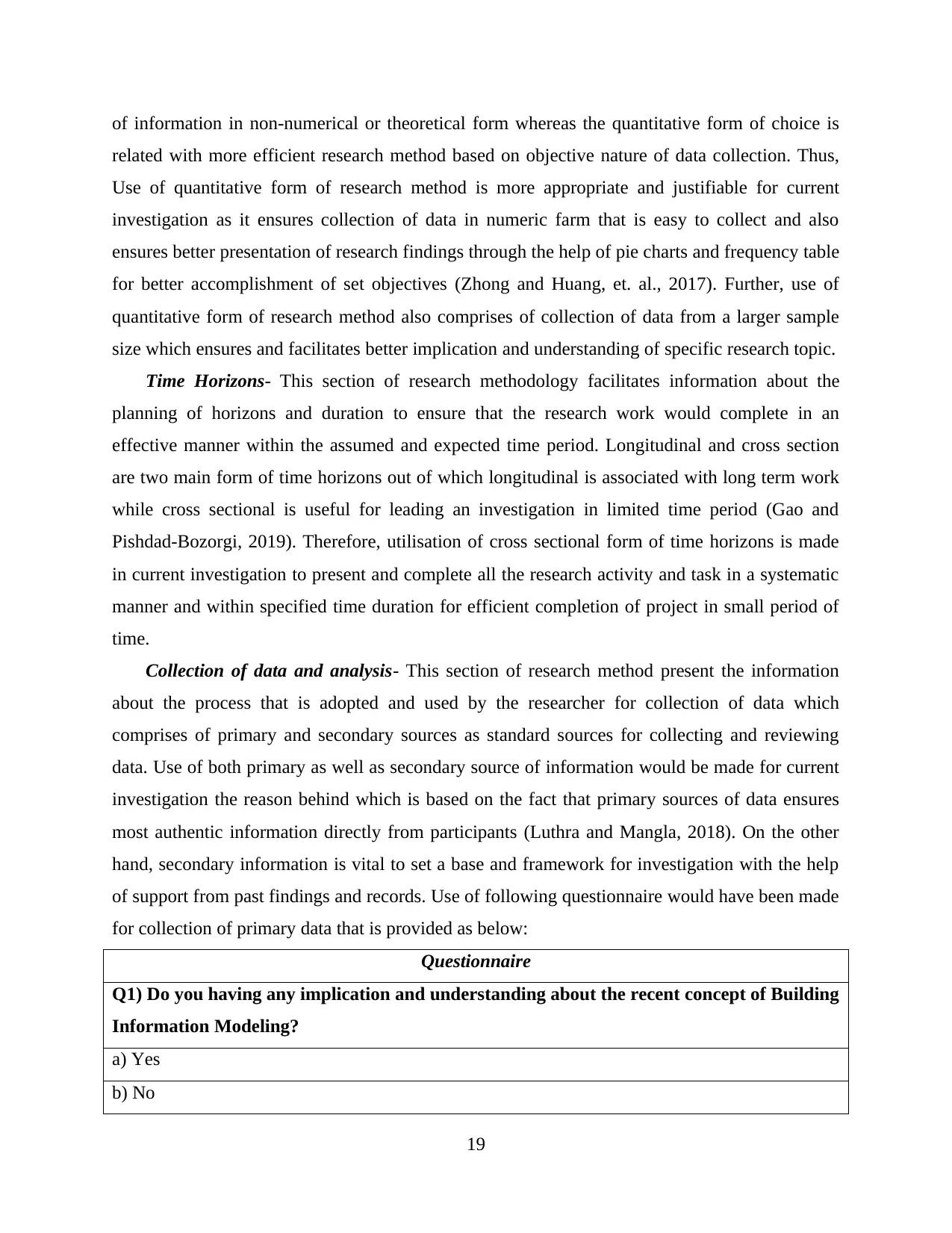
of information in non-numerical or theoretical form whereas the quantitative form of choice is
related with more efficient research method based on objective nature of data collection. Thus,
Use of quantitative form of research method is more appropriate and justifiable for current
investigation as it ensures collection of data in numeric farm that is easy to collect and also
ensures better presentation of research findings through the help of pie charts and frequency table
for better accomplishment of set objectives (Zhong and Huang, et. al., 2017). Further, use of
quantitative form of research method also comprises of collection of data from a larger sample
size which ensures and facilitates better implication and understanding of specific research topic.
Time Horizons- This section of research methodology facilitates information about the
planning of horizons and duration to ensure that the research work would complete in an
effective manner within the assumed and expected time period. Longitudinal and cross section
are two main form of time horizons out of which longitudinal is associated with long term work
while cross sectional is useful for leading an investigation in limited time period (Gao and
Pishdad-Bozorgi, 2019). Therefore, utilisation of cross sectional form of time horizons is made
in current investigation to present and complete all the research activity and task in a systematic
manner and within specified time duration for efficient completion of project in small period of
time.
Collection of data and analysis- This section of research method present the information
about the process that is adopted and used by the researcher for collection of data which
comprises of primary and secondary sources as standard sources for collecting and reviewing
data. Use of both primary as well as secondary source of information would be made for current
investigation the reason behind which is based on the fact that primary sources of data ensures
most authentic information directly from participants (Luthra and Mangla, 2018). On the other
hand, secondary information is vital to set a base and framework for investigation with the help
of support from past findings and records. Use of following questionnaire would have been made
for collection of primary data that is provided as below:
Questionnaire
Q1) Do you having any implication and understanding about the recent concept of Building
Information Modeling?
a) Yes
b) No
19
related with more efficient research method based on objective nature of data collection. Thus,
Use of quantitative form of research method is more appropriate and justifiable for current
investigation as it ensures collection of data in numeric farm that is easy to collect and also
ensures better presentation of research findings through the help of pie charts and frequency table
for better accomplishment of set objectives (Zhong and Huang, et. al., 2017). Further, use of
quantitative form of research method also comprises of collection of data from a larger sample
size which ensures and facilitates better implication and understanding of specific research topic.
Time Horizons- This section of research methodology facilitates information about the
planning of horizons and duration to ensure that the research work would complete in an
effective manner within the assumed and expected time period. Longitudinal and cross section
are two main form of time horizons out of which longitudinal is associated with long term work
while cross sectional is useful for leading an investigation in limited time period (Gao and
Pishdad-Bozorgi, 2019). Therefore, utilisation of cross sectional form of time horizons is made
in current investigation to present and complete all the research activity and task in a systematic
manner and within specified time duration for efficient completion of project in small period of
time.
Collection of data and analysis- This section of research method present the information
about the process that is adopted and used by the researcher for collection of data which
comprises of primary and secondary sources as standard sources for collecting and reviewing
data. Use of both primary as well as secondary source of information would be made for current
investigation the reason behind which is based on the fact that primary sources of data ensures
most authentic information directly from participants (Luthra and Mangla, 2018). On the other
hand, secondary information is vital to set a base and framework for investigation with the help
of support from past findings and records. Use of following questionnaire would have been made
for collection of primary data that is provided as below:
Questionnaire
Q1) Do you having any implication and understanding about the recent concept of Building
Information Modeling?
a) Yes
b) No
19
Secure Best Marks with AI Grader
Need help grading? Try our AI Grader for instant feedback on your assignments.
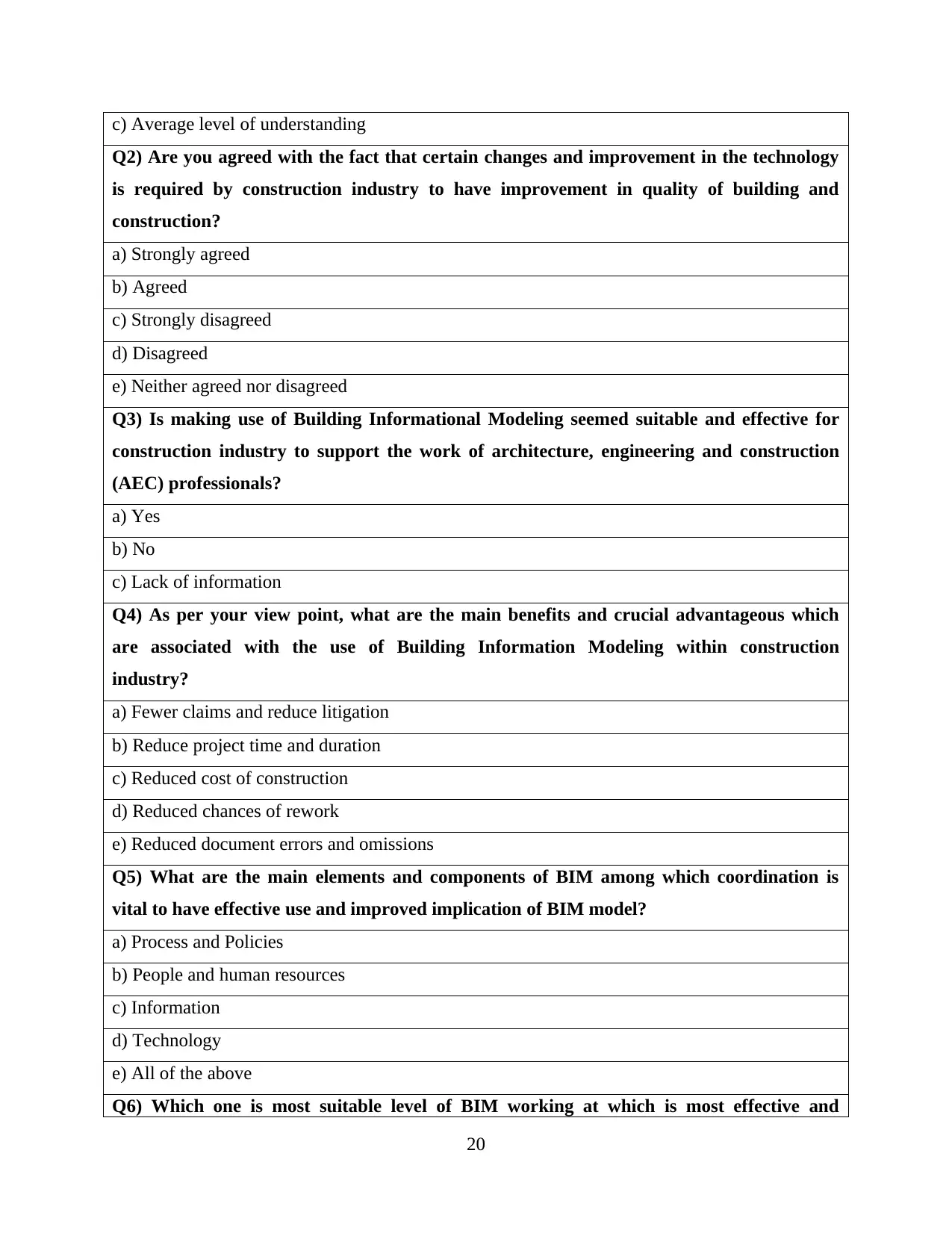
c) Average level of understanding
Q2) Are you agreed with the fact that certain changes and improvement in the technology
is required by construction industry to have improvement in quality of building and
construction?
a) Strongly agreed
b) Agreed
c) Strongly disagreed
d) Disagreed
e) Neither agreed nor disagreed
Q3) Is making use of Building Informational Modeling seemed suitable and effective for
construction industry to support the work of architecture, engineering and construction
(AEC) professionals?
a) Yes
b) No
c) Lack of information
Q4) As per your view point, what are the main benefits and crucial advantageous which
are associated with the use of Building Information Modeling within construction
industry?
a) Fewer claims and reduce litigation
b) Reduce project time and duration
c) Reduced cost of construction
d) Reduced chances of rework
e) Reduced document errors and omissions
Q5) What are the main elements and components of BIM among which coordination is
vital to have effective use and improved implication of BIM model?
a) Process and Policies
b) People and human resources
c) Information
d) Technology
e) All of the above
Q6) Which one is most suitable level of BIM working at which is most effective and
20
Q2) Are you agreed with the fact that certain changes and improvement in the technology
is required by construction industry to have improvement in quality of building and
construction?
a) Strongly agreed
b) Agreed
c) Strongly disagreed
d) Disagreed
e) Neither agreed nor disagreed
Q3) Is making use of Building Informational Modeling seemed suitable and effective for
construction industry to support the work of architecture, engineering and construction
(AEC) professionals?
a) Yes
b) No
c) Lack of information
Q4) As per your view point, what are the main benefits and crucial advantageous which
are associated with the use of Building Information Modeling within construction
industry?
a) Fewer claims and reduce litigation
b) Reduce project time and duration
c) Reduced cost of construction
d) Reduced chances of rework
e) Reduced document errors and omissions
Q5) What are the main elements and components of BIM among which coordination is
vital to have effective use and improved implication of BIM model?
a) Process and Policies
b) People and human resources
c) Information
d) Technology
e) All of the above
Q6) Which one is most suitable level of BIM working at which is most effective and
20
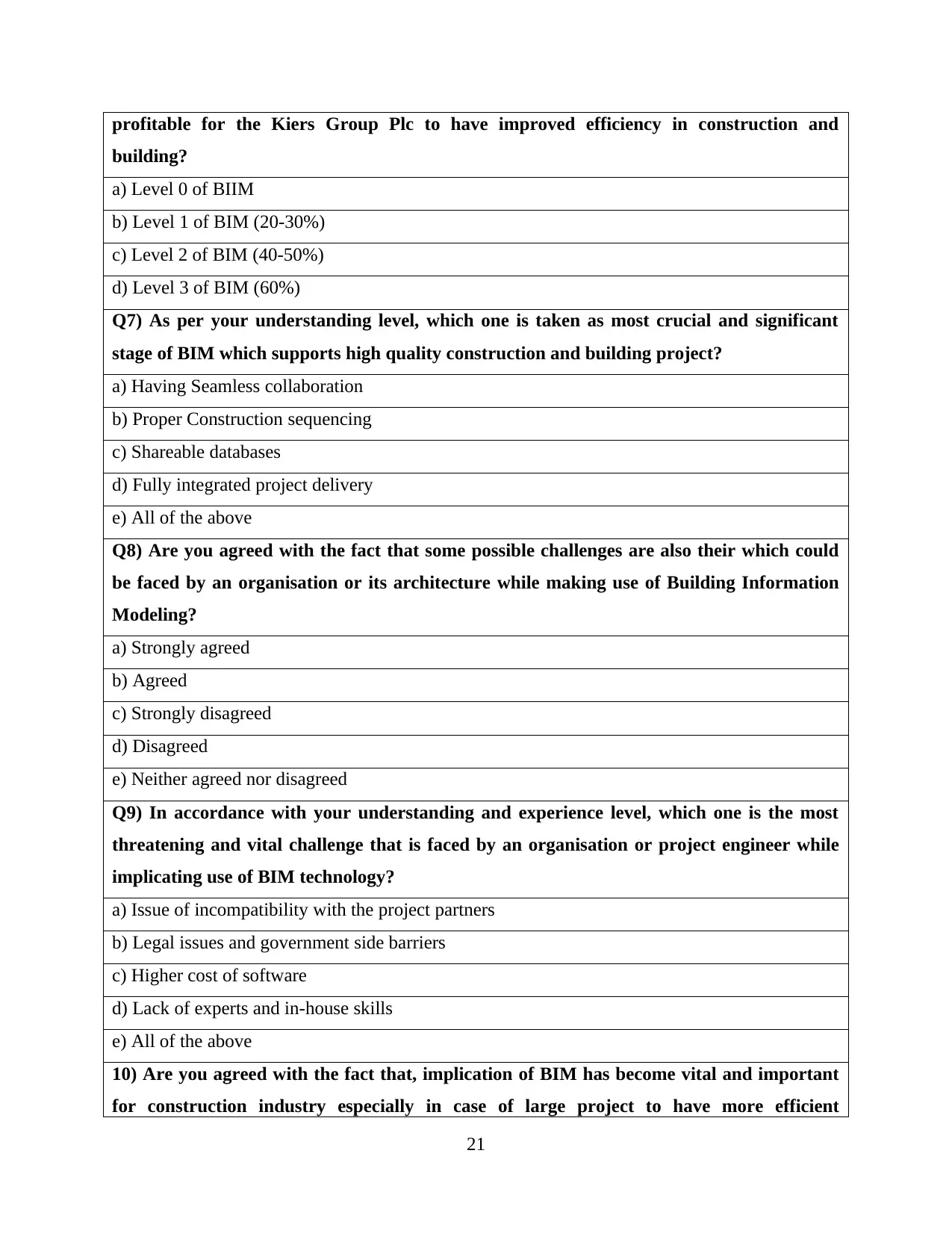
profitable for the Kiers Group Plc to have improved efficiency in construction and
building?
a) Level 0 of BIIM
b) Level 1 of BIM (20-30%)
c) Level 2 of BIM (40-50%)
d) Level 3 of BIM (60%)
Q7) As per your understanding level, which one is taken as most crucial and significant
stage of BIM which supports high quality construction and building project?
a) Having Seamless collaboration
b) Proper Construction sequencing
c) Shareable databases
d) Fully integrated project delivery
e) All of the above
Q8) Are you agreed with the fact that some possible challenges are also their which could
be faced by an organisation or its architecture while making use of Building Information
Modeling?
a) Strongly agreed
b) Agreed
c) Strongly disagreed
d) Disagreed
e) Neither agreed nor disagreed
Q9) In accordance with your understanding and experience level, which one is the most
threatening and vital challenge that is faced by an organisation or project engineer while
implicating use of BIM technology?
a) Issue of incompatibility with the project partners
b) Legal issues and government side barriers
c) Higher cost of software
d) Lack of experts and in-house skills
e) All of the above
10) Are you agreed with the fact that, implication of BIM has become vital and important
for construction industry especially in case of large project to have more efficient
21
building?
a) Level 0 of BIIM
b) Level 1 of BIM (20-30%)
c) Level 2 of BIM (40-50%)
d) Level 3 of BIM (60%)
Q7) As per your understanding level, which one is taken as most crucial and significant
stage of BIM which supports high quality construction and building project?
a) Having Seamless collaboration
b) Proper Construction sequencing
c) Shareable databases
d) Fully integrated project delivery
e) All of the above
Q8) Are you agreed with the fact that some possible challenges are also their which could
be faced by an organisation or its architecture while making use of Building Information
Modeling?
a) Strongly agreed
b) Agreed
c) Strongly disagreed
d) Disagreed
e) Neither agreed nor disagreed
Q9) In accordance with your understanding and experience level, which one is the most
threatening and vital challenge that is faced by an organisation or project engineer while
implicating use of BIM technology?
a) Issue of incompatibility with the project partners
b) Legal issues and government side barriers
c) Higher cost of software
d) Lack of experts and in-house skills
e) All of the above
10) Are you agreed with the fact that, implication of BIM has become vital and important
for construction industry especially in case of large project to have more efficient
21
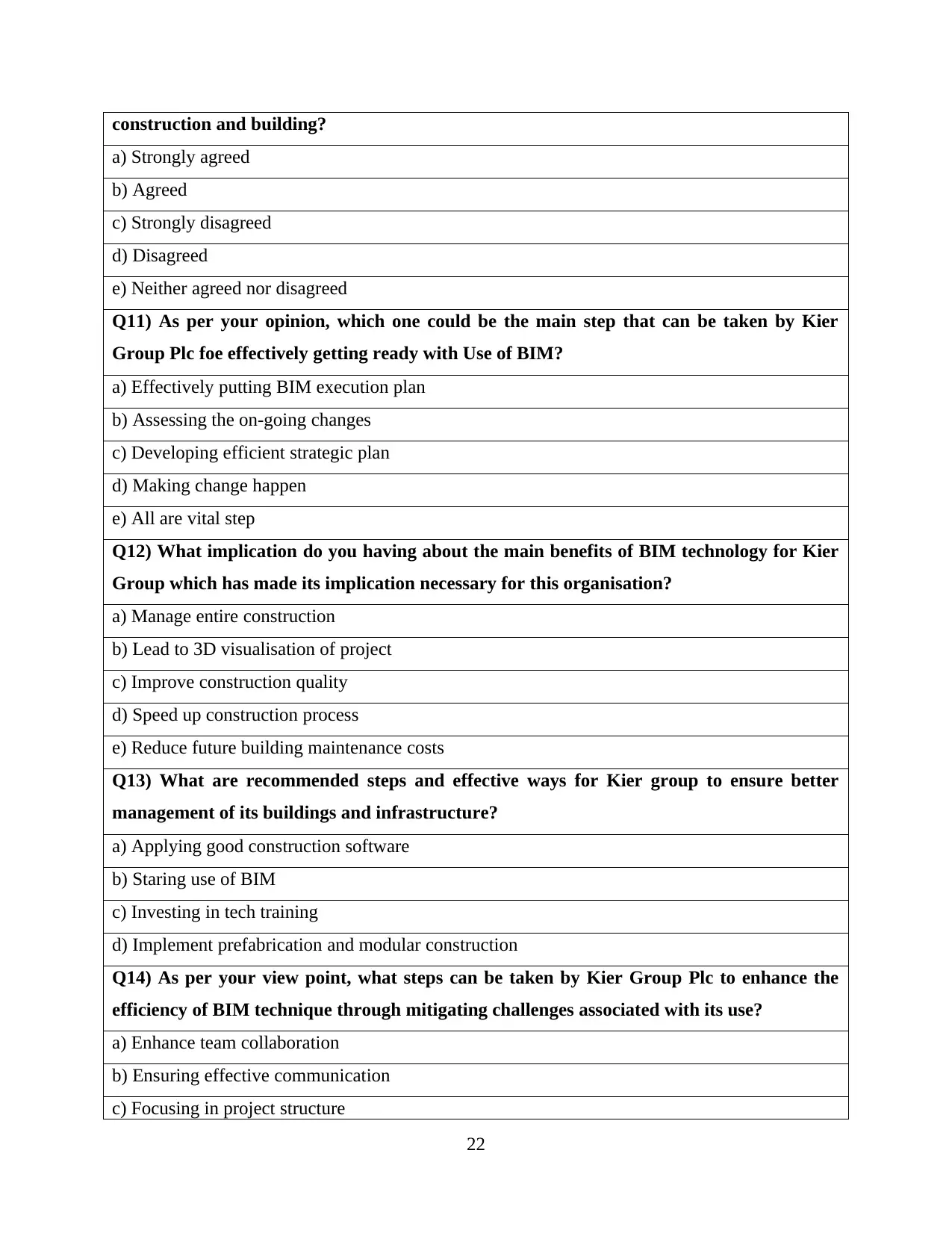
construction and building?
a) Strongly agreed
b) Agreed
c) Strongly disagreed
d) Disagreed
e) Neither agreed nor disagreed
Q11) As per your opinion, which one could be the main step that can be taken by Kier
Group Plc foe effectively getting ready with Use of BIM?
a) Effectively putting BIM execution plan
b) Assessing the on-going changes
c) Developing efficient strategic plan
d) Making change happen
e) All are vital step
Q12) What implication do you having about the main benefits of BIM technology for Kier
Group which has made its implication necessary for this organisation?
a) Manage entire construction
b) Lead to 3D visualisation of project
c) Improve construction quality
d) Speed up construction process
e) Reduce future building maintenance costs
Q13) What are recommended steps and effective ways for Kier group to ensure better
management of its buildings and infrastructure?
a) Applying good construction software
b) Staring use of BIM
c) Investing in tech training
d) Implement prefabrication and modular construction
Q14) As per your view point, what steps can be taken by Kier Group Plc to enhance the
efficiency of BIM technique through mitigating challenges associated with its use?
a) Enhance team collaboration
b) Ensuring effective communication
c) Focusing in project structure
22
a) Strongly agreed
b) Agreed
c) Strongly disagreed
d) Disagreed
e) Neither agreed nor disagreed
Q11) As per your opinion, which one could be the main step that can be taken by Kier
Group Plc foe effectively getting ready with Use of BIM?
a) Effectively putting BIM execution plan
b) Assessing the on-going changes
c) Developing efficient strategic plan
d) Making change happen
e) All are vital step
Q12) What implication do you having about the main benefits of BIM technology for Kier
Group which has made its implication necessary for this organisation?
a) Manage entire construction
b) Lead to 3D visualisation of project
c) Improve construction quality
d) Speed up construction process
e) Reduce future building maintenance costs
Q13) What are recommended steps and effective ways for Kier group to ensure better
management of its buildings and infrastructure?
a) Applying good construction software
b) Staring use of BIM
c) Investing in tech training
d) Implement prefabrication and modular construction
Q14) As per your view point, what steps can be taken by Kier Group Plc to enhance the
efficiency of BIM technique through mitigating challenges associated with its use?
a) Enhance team collaboration
b) Ensuring effective communication
c) Focusing in project structure
22
Paraphrase This Document
Need a fresh take? Get an instant paraphrase of this document with our AI Paraphraser
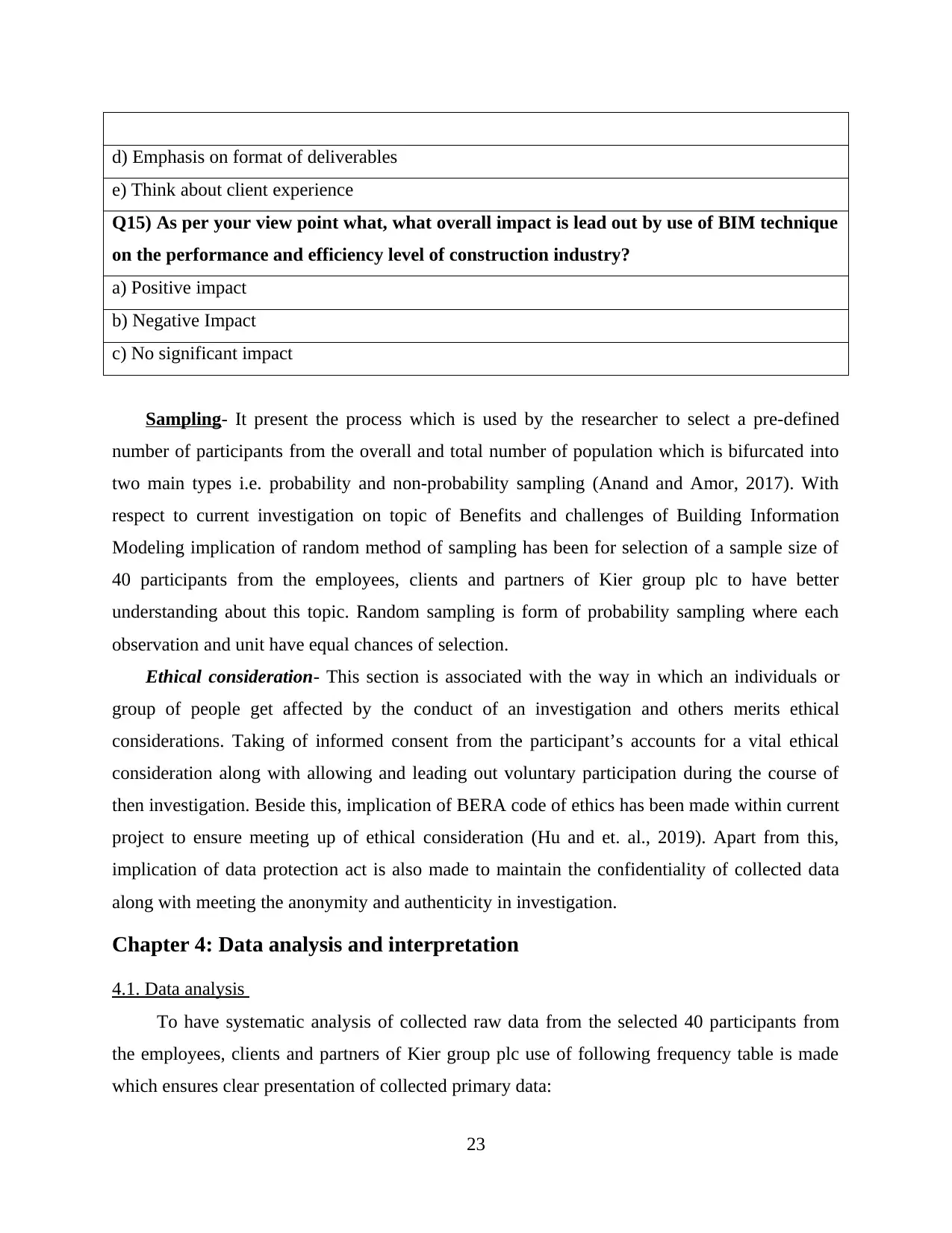
d) Emphasis on format of deliverables
e) Think about client experience
Q15) As per your view point what, what overall impact is lead out by use of BIM technique
on the performance and efficiency level of construction industry?
a) Positive impact
b) Negative Impact
c) No significant impact
Sampling- It present the process which is used by the researcher to select a pre-defined
number of participants from the overall and total number of population which is bifurcated into
two main types i.e. probability and non-probability sampling (Anand and Amor, 2017). With
respect to current investigation on topic of Benefits and challenges of Building Information
Modeling implication of random method of sampling has been for selection of a sample size of
40 participants from the employees, clients and partners of Kier group plc to have better
understanding about this topic. Random sampling is form of probability sampling where each
observation and unit have equal chances of selection.
Ethical consideration- This section is associated with the way in which an individuals or
group of people get affected by the conduct of an investigation and others merits ethical
considerations. Taking of informed consent from the participant’s accounts for a vital ethical
consideration along with allowing and leading out voluntary participation during the course of
then investigation. Beside this, implication of BERA code of ethics has been made within current
project to ensure meeting up of ethical consideration (Hu and et. al., 2019). Apart from this,
implication of data protection act is also made to maintain the confidentiality of collected data
along with meeting the anonymity and authenticity in investigation.
Chapter 4: Data analysis and interpretation
4.1. Data analysis
To have systematic analysis of collected raw data from the selected 40 participants from
the employees, clients and partners of Kier group plc use of following frequency table is made
which ensures clear presentation of collected primary data:
23
e) Think about client experience
Q15) As per your view point what, what overall impact is lead out by use of BIM technique
on the performance and efficiency level of construction industry?
a) Positive impact
b) Negative Impact
c) No significant impact
Sampling- It present the process which is used by the researcher to select a pre-defined
number of participants from the overall and total number of population which is bifurcated into
two main types i.e. probability and non-probability sampling (Anand and Amor, 2017). With
respect to current investigation on topic of Benefits and challenges of Building Information
Modeling implication of random method of sampling has been for selection of a sample size of
40 participants from the employees, clients and partners of Kier group plc to have better
understanding about this topic. Random sampling is form of probability sampling where each
observation and unit have equal chances of selection.
Ethical consideration- This section is associated with the way in which an individuals or
group of people get affected by the conduct of an investigation and others merits ethical
considerations. Taking of informed consent from the participant’s accounts for a vital ethical
consideration along with allowing and leading out voluntary participation during the course of
then investigation. Beside this, implication of BERA code of ethics has been made within current
project to ensure meeting up of ethical consideration (Hu and et. al., 2019). Apart from this,
implication of data protection act is also made to maintain the confidentiality of collected data
along with meeting the anonymity and authenticity in investigation.
Chapter 4: Data analysis and interpretation
4.1. Data analysis
To have systematic analysis of collected raw data from the selected 40 participants from
the employees, clients and partners of Kier group plc use of following frequency table is made
which ensures clear presentation of collected primary data:
23
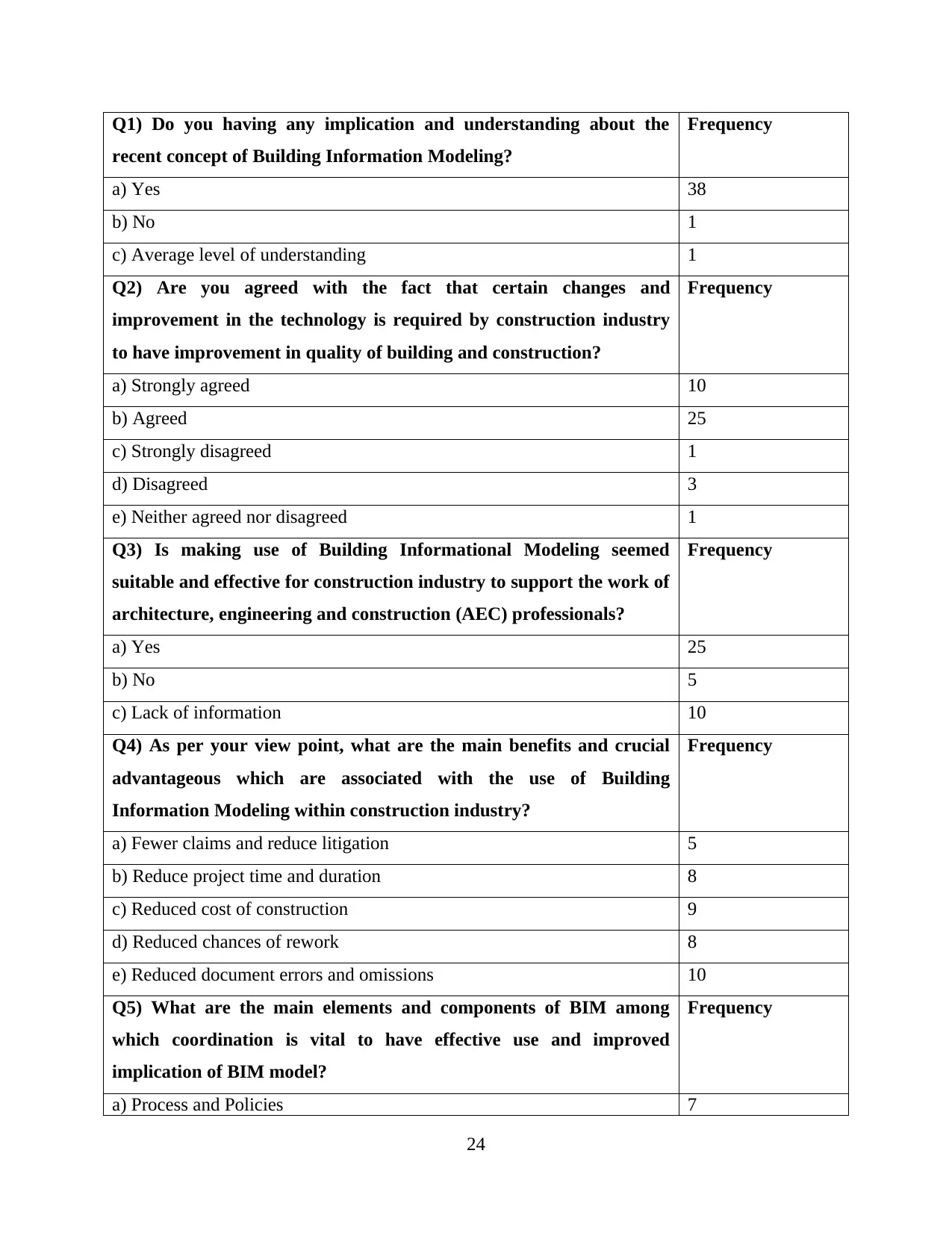
Q1) Do you having any implication and understanding about the
recent concept of Building Information Modeling?
Frequency
a) Yes 38
b) No 1
c) Average level of understanding 1
Q2) Are you agreed with the fact that certain changes and
improvement in the technology is required by construction industry
to have improvement in quality of building and construction?
Frequency
a) Strongly agreed 10
b) Agreed 25
c) Strongly disagreed 1
d) Disagreed 3
e) Neither agreed nor disagreed 1
Q3) Is making use of Building Informational Modeling seemed
suitable and effective for construction industry to support the work of
architecture, engineering and construction (AEC) professionals?
Frequency
a) Yes 25
b) No 5
c) Lack of information 10
Q4) As per your view point, what are the main benefits and crucial
advantageous which are associated with the use of Building
Information Modeling within construction industry?
Frequency
a) Fewer claims and reduce litigation 5
b) Reduce project time and duration 8
c) Reduced cost of construction 9
d) Reduced chances of rework 8
e) Reduced document errors and omissions 10
Q5) What are the main elements and components of BIM among
which coordination is vital to have effective use and improved
implication of BIM model?
Frequency
a) Process and Policies 7
24
recent concept of Building Information Modeling?
Frequency
a) Yes 38
b) No 1
c) Average level of understanding 1
Q2) Are you agreed with the fact that certain changes and
improvement in the technology is required by construction industry
to have improvement in quality of building and construction?
Frequency
a) Strongly agreed 10
b) Agreed 25
c) Strongly disagreed 1
d) Disagreed 3
e) Neither agreed nor disagreed 1
Q3) Is making use of Building Informational Modeling seemed
suitable and effective for construction industry to support the work of
architecture, engineering and construction (AEC) professionals?
Frequency
a) Yes 25
b) No 5
c) Lack of information 10
Q4) As per your view point, what are the main benefits and crucial
advantageous which are associated with the use of Building
Information Modeling within construction industry?
Frequency
a) Fewer claims and reduce litigation 5
b) Reduce project time and duration 8
c) Reduced cost of construction 9
d) Reduced chances of rework 8
e) Reduced document errors and omissions 10
Q5) What are the main elements and components of BIM among
which coordination is vital to have effective use and improved
implication of BIM model?
Frequency
a) Process and Policies 7
24
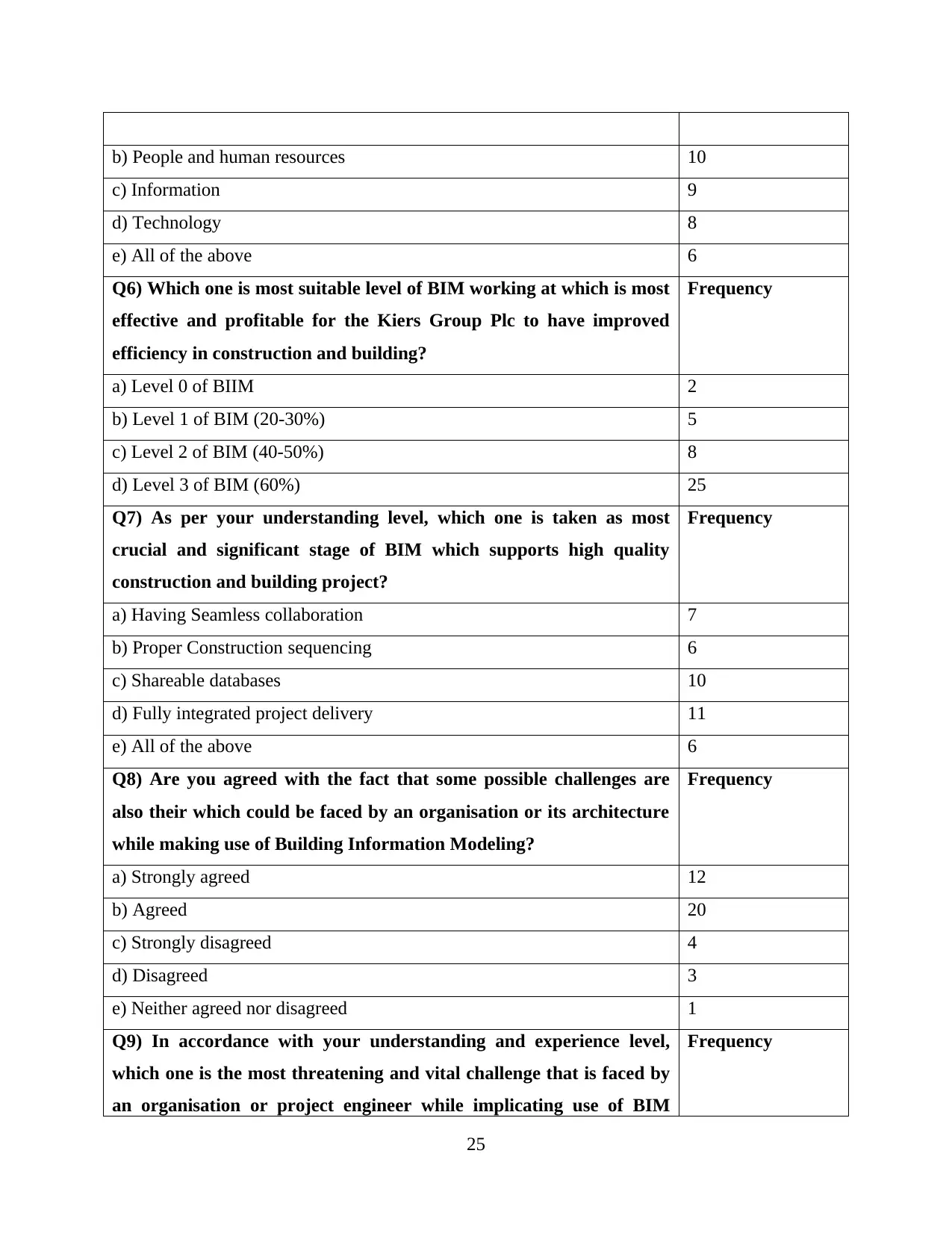
b) People and human resources 10
c) Information 9
d) Technology 8
e) All of the above 6
Q6) Which one is most suitable level of BIM working at which is most
effective and profitable for the Kiers Group Plc to have improved
efficiency in construction and building?
Frequency
a) Level 0 of BIIM 2
b) Level 1 of BIM (20-30%) 5
c) Level 2 of BIM (40-50%) 8
d) Level 3 of BIM (60%) 25
Q7) As per your understanding level, which one is taken as most
crucial and significant stage of BIM which supports high quality
construction and building project?
Frequency
a) Having Seamless collaboration 7
b) Proper Construction sequencing 6
c) Shareable databases 10
d) Fully integrated project delivery 11
e) All of the above 6
Q8) Are you agreed with the fact that some possible challenges are
also their which could be faced by an organisation or its architecture
while making use of Building Information Modeling?
Frequency
a) Strongly agreed 12
b) Agreed 20
c) Strongly disagreed 4
d) Disagreed 3
e) Neither agreed nor disagreed 1
Q9) In accordance with your understanding and experience level,
which one is the most threatening and vital challenge that is faced by
an organisation or project engineer while implicating use of BIM
Frequency
25
c) Information 9
d) Technology 8
e) All of the above 6
Q6) Which one is most suitable level of BIM working at which is most
effective and profitable for the Kiers Group Plc to have improved
efficiency in construction and building?
Frequency
a) Level 0 of BIIM 2
b) Level 1 of BIM (20-30%) 5
c) Level 2 of BIM (40-50%) 8
d) Level 3 of BIM (60%) 25
Q7) As per your understanding level, which one is taken as most
crucial and significant stage of BIM which supports high quality
construction and building project?
Frequency
a) Having Seamless collaboration 7
b) Proper Construction sequencing 6
c) Shareable databases 10
d) Fully integrated project delivery 11
e) All of the above 6
Q8) Are you agreed with the fact that some possible challenges are
also their which could be faced by an organisation or its architecture
while making use of Building Information Modeling?
Frequency
a) Strongly agreed 12
b) Agreed 20
c) Strongly disagreed 4
d) Disagreed 3
e) Neither agreed nor disagreed 1
Q9) In accordance with your understanding and experience level,
which one is the most threatening and vital challenge that is faced by
an organisation or project engineer while implicating use of BIM
Frequency
25
Secure Best Marks with AI Grader
Need help grading? Try our AI Grader for instant feedback on your assignments.
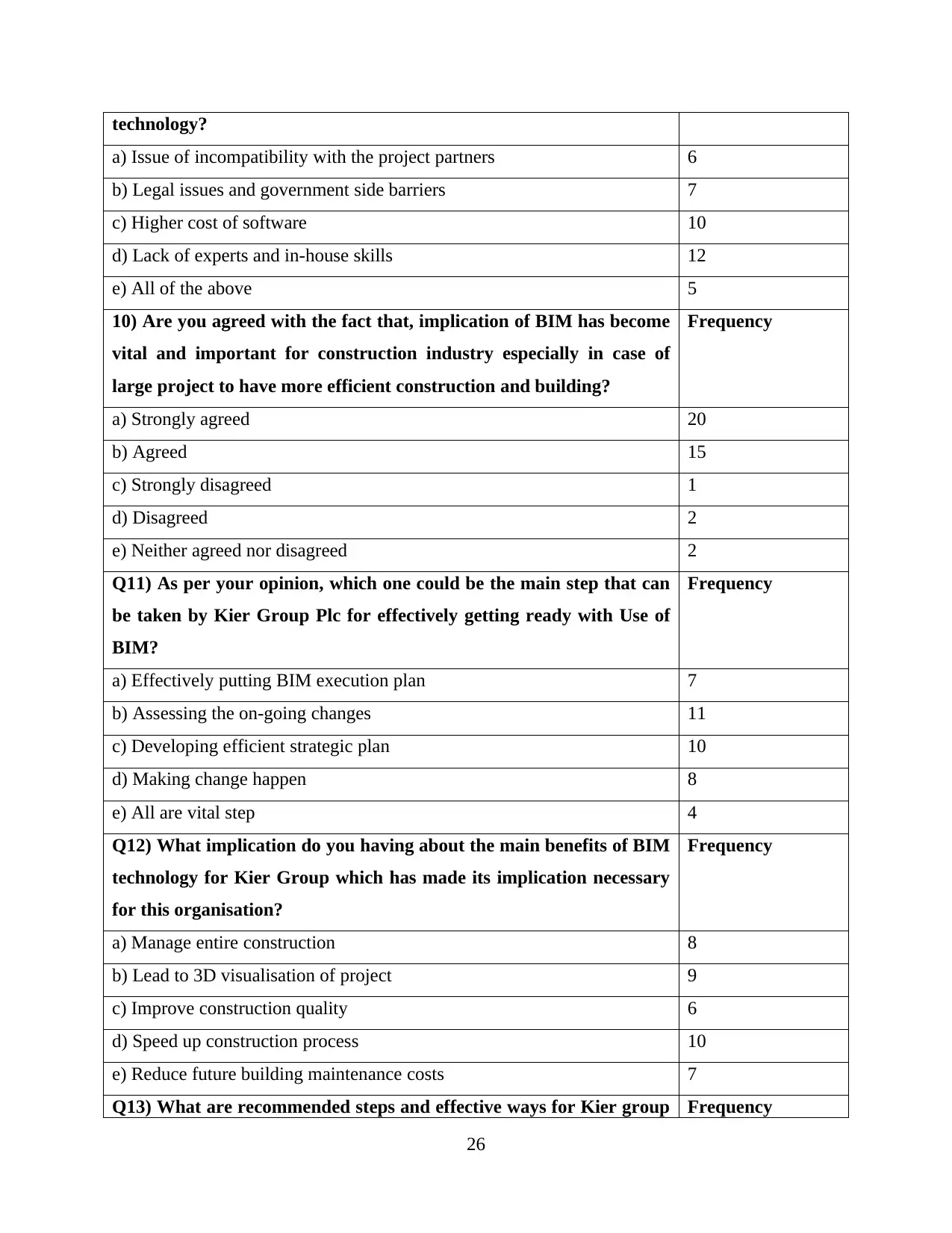
technology?
a) Issue of incompatibility with the project partners 6
b) Legal issues and government side barriers 7
c) Higher cost of software 10
d) Lack of experts and in-house skills 12
e) All of the above 5
10) Are you agreed with the fact that, implication of BIM has become
vital and important for construction industry especially in case of
large project to have more efficient construction and building?
Frequency
a) Strongly agreed 20
b) Agreed 15
c) Strongly disagreed 1
d) Disagreed 2
e) Neither agreed nor disagreed 2
Q11) As per your opinion, which one could be the main step that can
be taken by Kier Group Plc for effectively getting ready with Use of
BIM?
Frequency
a) Effectively putting BIM execution plan 7
b) Assessing the on-going changes 11
c) Developing efficient strategic plan 10
d) Making change happen 8
e) All are vital step 4
Q12) What implication do you having about the main benefits of BIM
technology for Kier Group which has made its implication necessary
for this organisation?
Frequency
a) Manage entire construction 8
b) Lead to 3D visualisation of project 9
c) Improve construction quality 6
d) Speed up construction process 10
e) Reduce future building maintenance costs 7
Q13) What are recommended steps and effective ways for Kier group Frequency
26
a) Issue of incompatibility with the project partners 6
b) Legal issues and government side barriers 7
c) Higher cost of software 10
d) Lack of experts and in-house skills 12
e) All of the above 5
10) Are you agreed with the fact that, implication of BIM has become
vital and important for construction industry especially in case of
large project to have more efficient construction and building?
Frequency
a) Strongly agreed 20
b) Agreed 15
c) Strongly disagreed 1
d) Disagreed 2
e) Neither agreed nor disagreed 2
Q11) As per your opinion, which one could be the main step that can
be taken by Kier Group Plc for effectively getting ready with Use of
BIM?
Frequency
a) Effectively putting BIM execution plan 7
b) Assessing the on-going changes 11
c) Developing efficient strategic plan 10
d) Making change happen 8
e) All are vital step 4
Q12) What implication do you having about the main benefits of BIM
technology for Kier Group which has made its implication necessary
for this organisation?
Frequency
a) Manage entire construction 8
b) Lead to 3D visualisation of project 9
c) Improve construction quality 6
d) Speed up construction process 10
e) Reduce future building maintenance costs 7
Q13) What are recommended steps and effective ways for Kier group Frequency
26
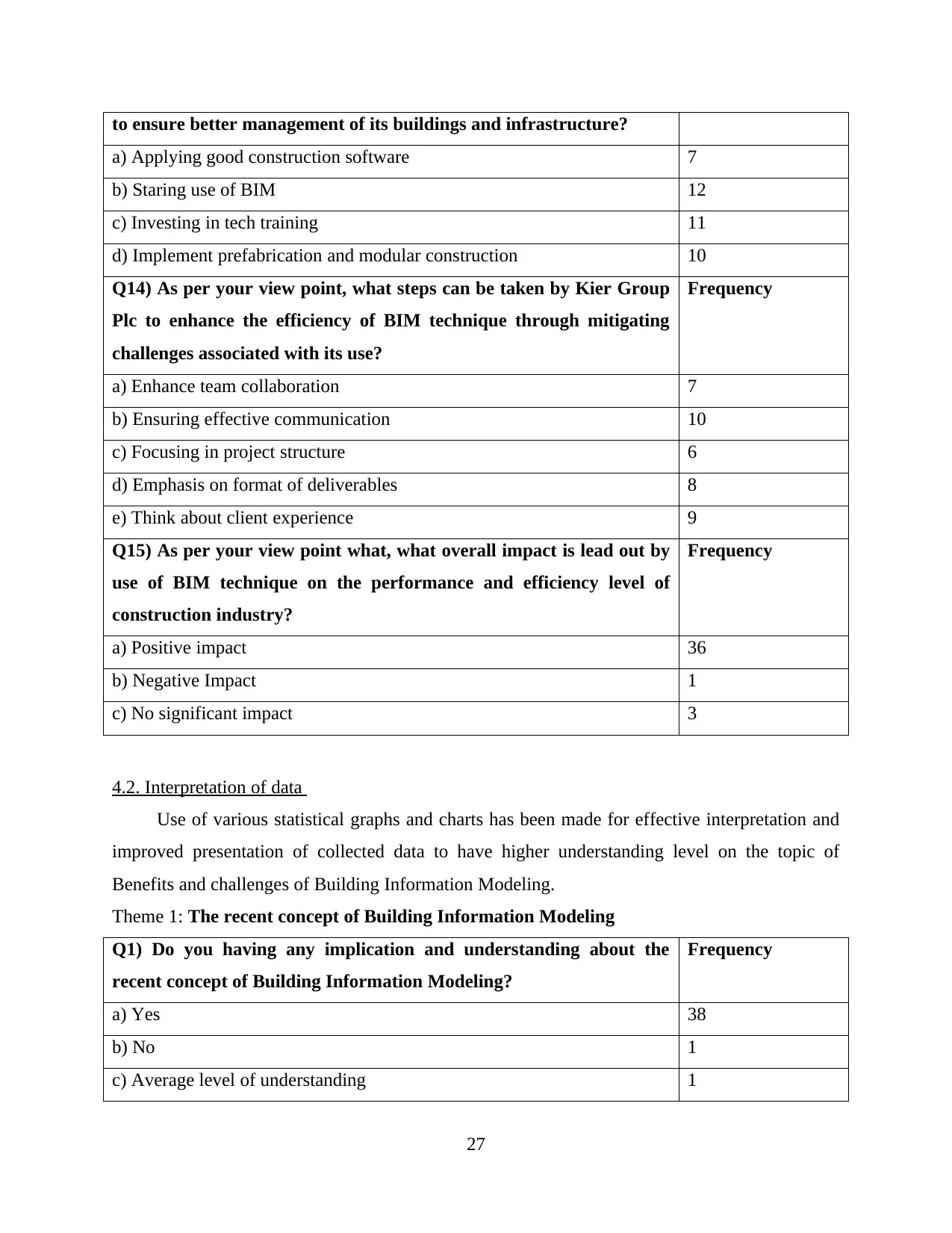
to ensure better management of its buildings and infrastructure?
a) Applying good construction software 7
b) Staring use of BIM 12
c) Investing in tech training 11
d) Implement prefabrication and modular construction 10
Q14) As per your view point, what steps can be taken by Kier Group
Plc to enhance the efficiency of BIM technique through mitigating
challenges associated with its use?
Frequency
a) Enhance team collaboration 7
b) Ensuring effective communication 10
c) Focusing in project structure 6
d) Emphasis on format of deliverables 8
e) Think about client experience 9
Q15) As per your view point what, what overall impact is lead out by
use of BIM technique on the performance and efficiency level of
construction industry?
Frequency
a) Positive impact 36
b) Negative Impact 1
c) No significant impact 3
4.2. Interpretation of data
Use of various statistical graphs and charts has been made for effective interpretation and
improved presentation of collected data to have higher understanding level on the topic of
Benefits and challenges of Building Information Modeling.
Theme 1: The recent concept of Building Information Modeling
Q1) Do you having any implication and understanding about the
recent concept of Building Information Modeling?
Frequency
a) Yes 38
b) No 1
c) Average level of understanding 1
27
a) Applying good construction software 7
b) Staring use of BIM 12
c) Investing in tech training 11
d) Implement prefabrication and modular construction 10
Q14) As per your view point, what steps can be taken by Kier Group
Plc to enhance the efficiency of BIM technique through mitigating
challenges associated with its use?
Frequency
a) Enhance team collaboration 7
b) Ensuring effective communication 10
c) Focusing in project structure 6
d) Emphasis on format of deliverables 8
e) Think about client experience 9
Q15) As per your view point what, what overall impact is lead out by
use of BIM technique on the performance and efficiency level of
construction industry?
Frequency
a) Positive impact 36
b) Negative Impact 1
c) No significant impact 3
4.2. Interpretation of data
Use of various statistical graphs and charts has been made for effective interpretation and
improved presentation of collected data to have higher understanding level on the topic of
Benefits and challenges of Building Information Modeling.
Theme 1: The recent concept of Building Information Modeling
Q1) Do you having any implication and understanding about the
recent concept of Building Information Modeling?
Frequency
a) Yes 38
b) No 1
c) Average level of understanding 1
27
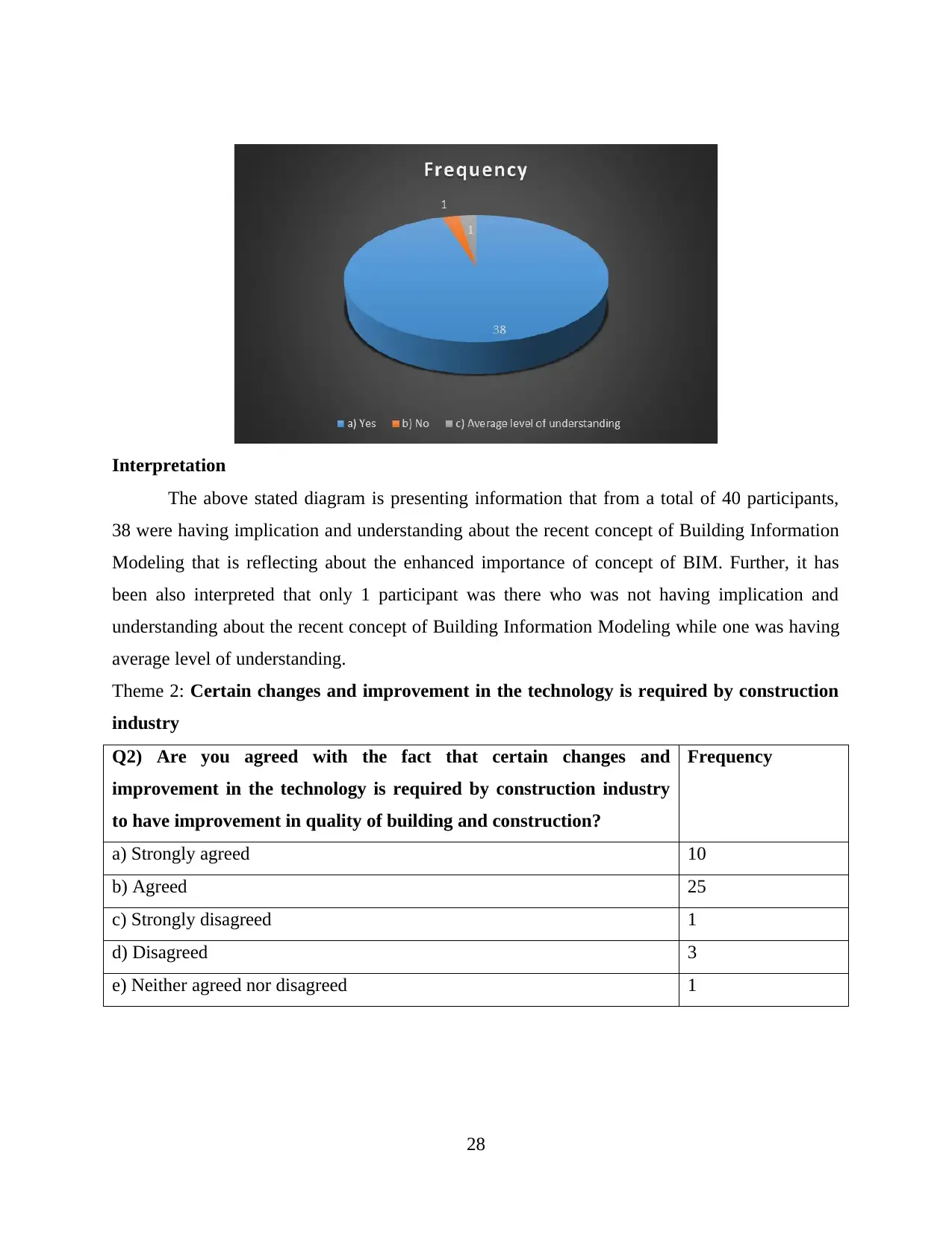
Interpretation
The above stated diagram is presenting information that from a total of 40 participants,
38 were having implication and understanding about the recent concept of Building Information
Modeling that is reflecting about the enhanced importance of concept of BIM. Further, it has
been also interpreted that only 1 participant was there who was not having implication and
understanding about the recent concept of Building Information Modeling while one was having
average level of understanding.
Theme 2: Certain changes and improvement in the technology is required by construction
industry
Q2) Are you agreed with the fact that certain changes and
improvement in the technology is required by construction industry
to have improvement in quality of building and construction?
Frequency
a) Strongly agreed 10
b) Agreed 25
c) Strongly disagreed 1
d) Disagreed 3
e) Neither agreed nor disagreed 1
28
The above stated diagram is presenting information that from a total of 40 participants,
38 were having implication and understanding about the recent concept of Building Information
Modeling that is reflecting about the enhanced importance of concept of BIM. Further, it has
been also interpreted that only 1 participant was there who was not having implication and
understanding about the recent concept of Building Information Modeling while one was having
average level of understanding.
Theme 2: Certain changes and improvement in the technology is required by construction
industry
Q2) Are you agreed with the fact that certain changes and
improvement in the technology is required by construction industry
to have improvement in quality of building and construction?
Frequency
a) Strongly agreed 10
b) Agreed 25
c) Strongly disagreed 1
d) Disagreed 3
e) Neither agreed nor disagreed 1
28
Paraphrase This Document
Need a fresh take? Get an instant paraphrase of this document with our AI Paraphraser
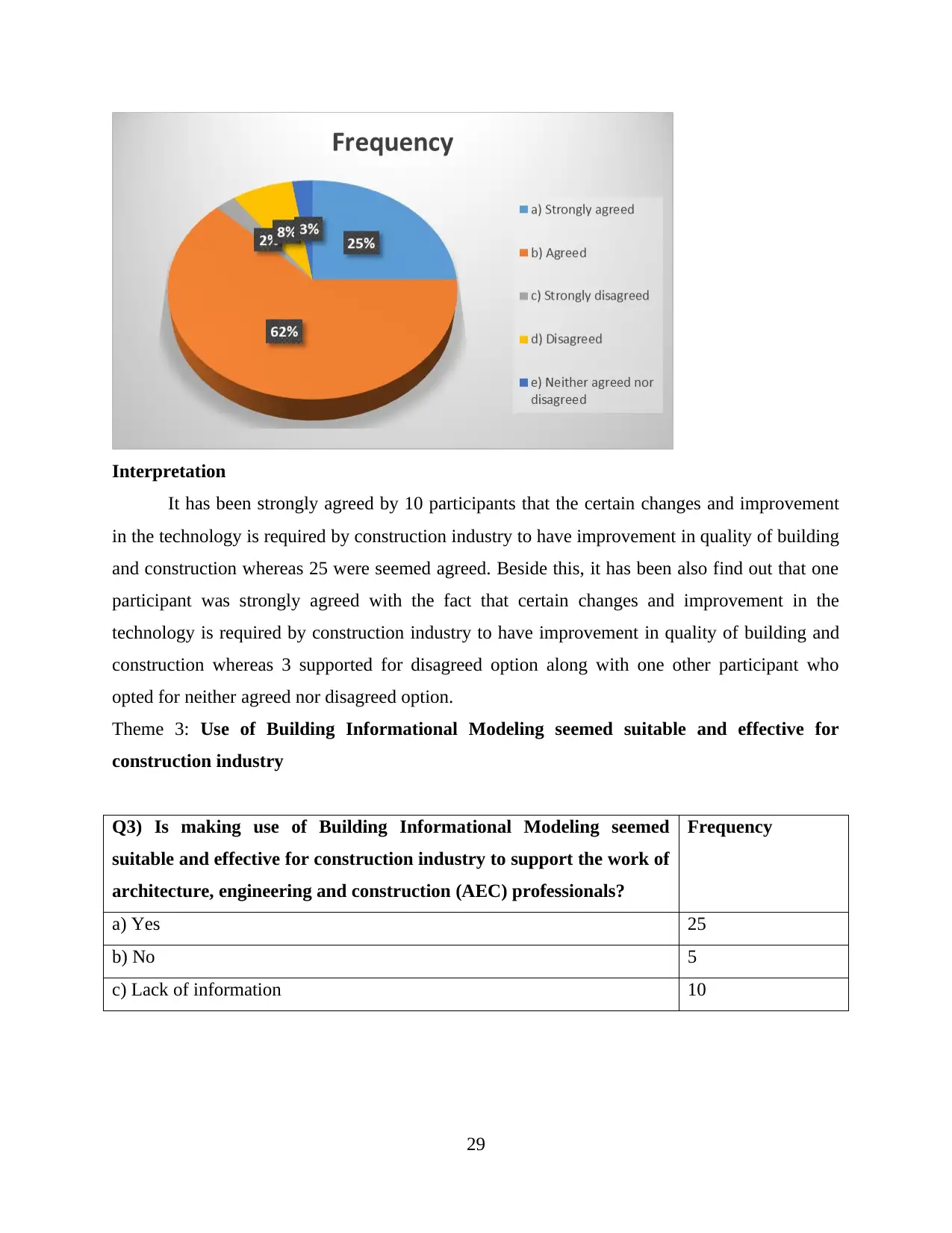
Interpretation
It has been strongly agreed by 10 participants that the certain changes and improvement
in the technology is required by construction industry to have improvement in quality of building
and construction whereas 25 were seemed agreed. Beside this, it has been also find out that one
participant was strongly agreed with the fact that certain changes and improvement in the
technology is required by construction industry to have improvement in quality of building and
construction whereas 3 supported for disagreed option along with one other participant who
opted for neither agreed nor disagreed option.
Theme 3: Use of Building Informational Modeling seemed suitable and effective for
construction industry
Q3) Is making use of Building Informational Modeling seemed
suitable and effective for construction industry to support the work of
architecture, engineering and construction (AEC) professionals?
Frequency
a) Yes 25
b) No 5
c) Lack of information 10
29
It has been strongly agreed by 10 participants that the certain changes and improvement
in the technology is required by construction industry to have improvement in quality of building
and construction whereas 25 were seemed agreed. Beside this, it has been also find out that one
participant was strongly agreed with the fact that certain changes and improvement in the
technology is required by construction industry to have improvement in quality of building and
construction whereas 3 supported for disagreed option along with one other participant who
opted for neither agreed nor disagreed option.
Theme 3: Use of Building Informational Modeling seemed suitable and effective for
construction industry
Q3) Is making use of Building Informational Modeling seemed
suitable and effective for construction industry to support the work of
architecture, engineering and construction (AEC) professionals?
Frequency
a) Yes 25
b) No 5
c) Lack of information 10
29
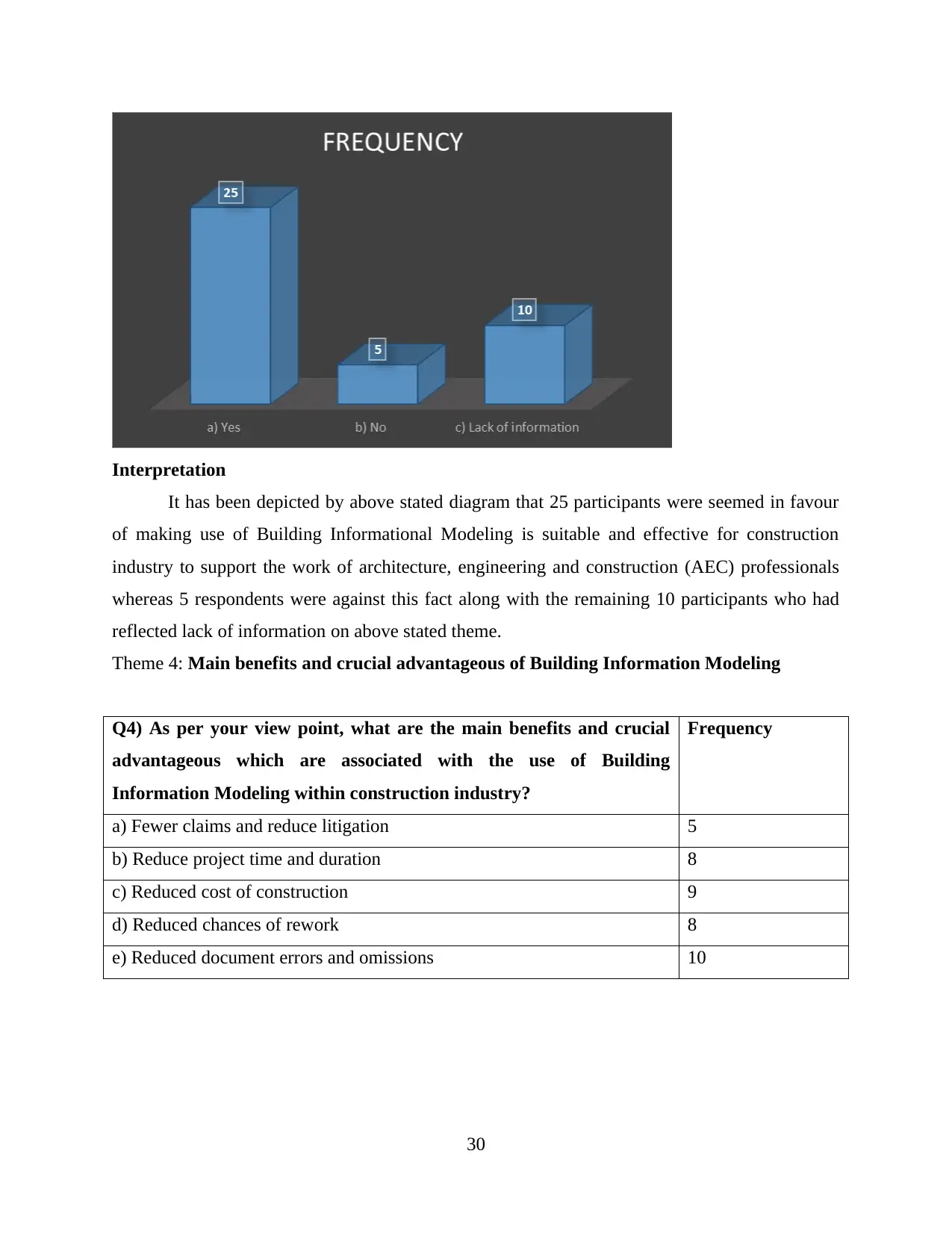
Interpretation
It has been depicted by above stated diagram that 25 participants were seemed in favour
of making use of Building Informational Modeling is suitable and effective for construction
industry to support the work of architecture, engineering and construction (AEC) professionals
whereas 5 respondents were against this fact along with the remaining 10 participants who had
reflected lack of information on above stated theme.
Theme 4: Main benefits and crucial advantageous of Building Information Modeling
Q4) As per your view point, what are the main benefits and crucial
advantageous which are associated with the use of Building
Information Modeling within construction industry?
Frequency
a) Fewer claims and reduce litigation 5
b) Reduce project time and duration 8
c) Reduced cost of construction 9
d) Reduced chances of rework 8
e) Reduced document errors and omissions 10
30
It has been depicted by above stated diagram that 25 participants were seemed in favour
of making use of Building Informational Modeling is suitable and effective for construction
industry to support the work of architecture, engineering and construction (AEC) professionals
whereas 5 respondents were against this fact along with the remaining 10 participants who had
reflected lack of information on above stated theme.
Theme 4: Main benefits and crucial advantageous of Building Information Modeling
Q4) As per your view point, what are the main benefits and crucial
advantageous which are associated with the use of Building
Information Modeling within construction industry?
Frequency
a) Fewer claims and reduce litigation 5
b) Reduce project time and duration 8
c) Reduced cost of construction 9
d) Reduced chances of rework 8
e) Reduced document errors and omissions 10
30
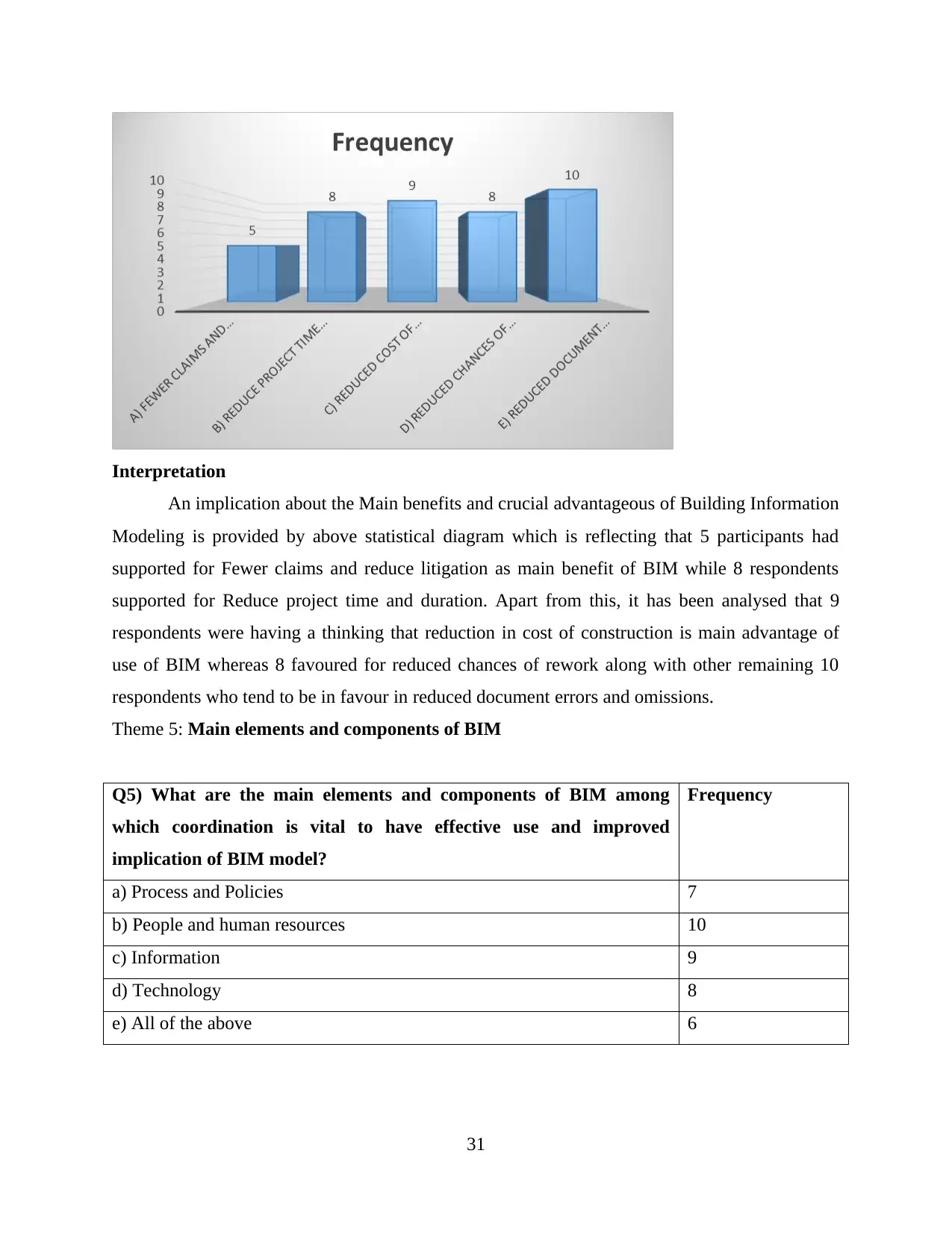
Interpretation
An implication about the Main benefits and crucial advantageous of Building Information
Modeling is provided by above statistical diagram which is reflecting that 5 participants had
supported for Fewer claims and reduce litigation as main benefit of BIM while 8 respondents
supported for Reduce project time and duration. Apart from this, it has been analysed that 9
respondents were having a thinking that reduction in cost of construction is main advantage of
use of BIM whereas 8 favoured for reduced chances of rework along with other remaining 10
respondents who tend to be in favour in reduced document errors and omissions.
Theme 5: Main elements and components of BIM
Q5) What are the main elements and components of BIM among
which coordination is vital to have effective use and improved
implication of BIM model?
Frequency
a) Process and Policies 7
b) People and human resources 10
c) Information 9
d) Technology 8
e) All of the above 6
31
An implication about the Main benefits and crucial advantageous of Building Information
Modeling is provided by above statistical diagram which is reflecting that 5 participants had
supported for Fewer claims and reduce litigation as main benefit of BIM while 8 respondents
supported for Reduce project time and duration. Apart from this, it has been analysed that 9
respondents were having a thinking that reduction in cost of construction is main advantage of
use of BIM whereas 8 favoured for reduced chances of rework along with other remaining 10
respondents who tend to be in favour in reduced document errors and omissions.
Theme 5: Main elements and components of BIM
Q5) What are the main elements and components of BIM among
which coordination is vital to have effective use and improved
implication of BIM model?
Frequency
a) Process and Policies 7
b) People and human resources 10
c) Information 9
d) Technology 8
e) All of the above 6
31
Secure Best Marks with AI Grader
Need help grading? Try our AI Grader for instant feedback on your assignments.
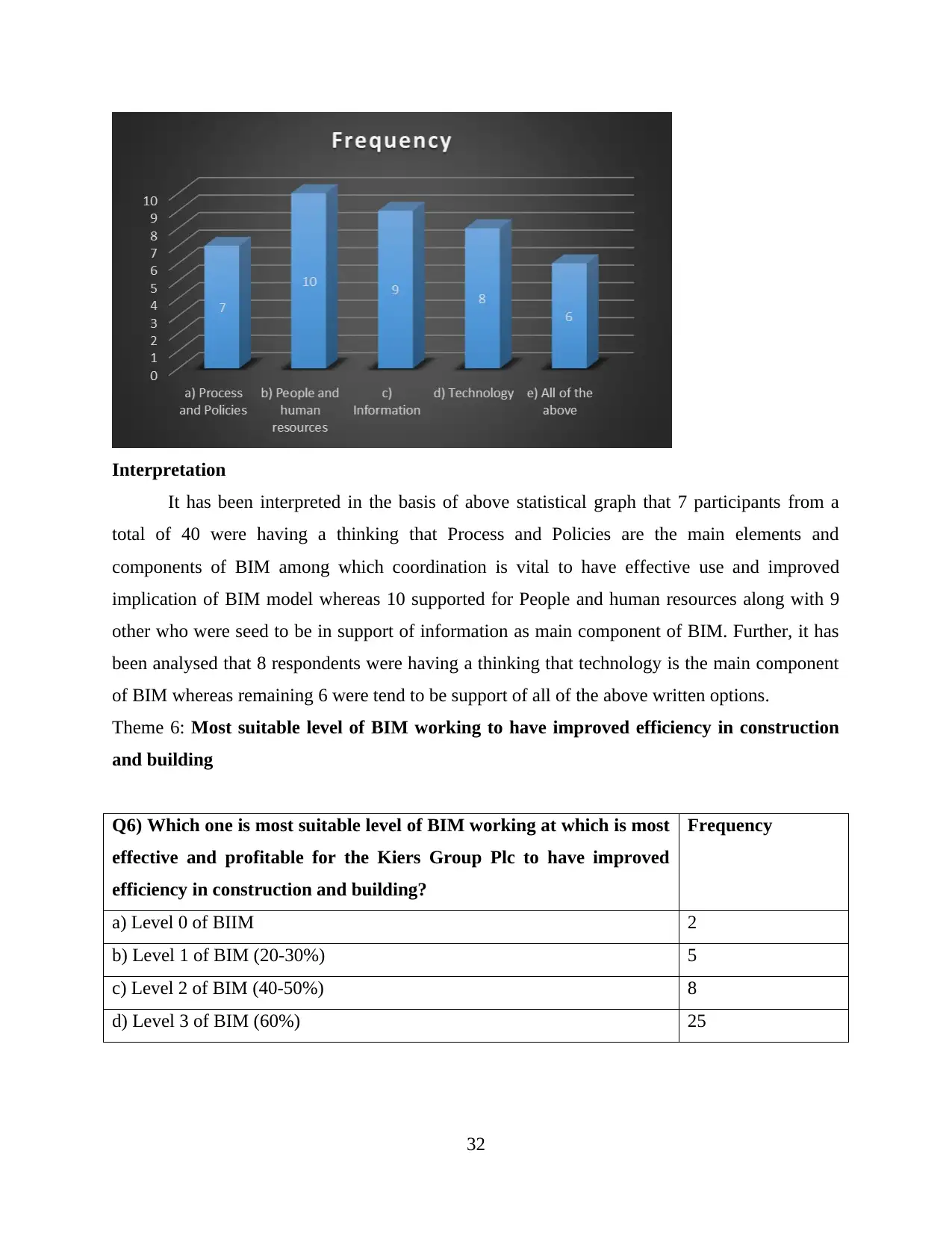
Interpretation
It has been interpreted in the basis of above statistical graph that 7 participants from a
total of 40 were having a thinking that Process and Policies are the main elements and
components of BIM among which coordination is vital to have effective use and improved
implication of BIM model whereas 10 supported for People and human resources along with 9
other who were seed to be in support of information as main component of BIM. Further, it has
been analysed that 8 respondents were having a thinking that technology is the main component
of BIM whereas remaining 6 were tend to be support of all of the above written options.
Theme 6: Most suitable level of BIM working to have improved efficiency in construction
and building
Q6) Which one is most suitable level of BIM working at which is most
effective and profitable for the Kiers Group Plc to have improved
efficiency in construction and building?
Frequency
a) Level 0 of BIIM 2
b) Level 1 of BIM (20-30%) 5
c) Level 2 of BIM (40-50%) 8
d) Level 3 of BIM (60%) 25
32
It has been interpreted in the basis of above statistical graph that 7 participants from a
total of 40 were having a thinking that Process and Policies are the main elements and
components of BIM among which coordination is vital to have effective use and improved
implication of BIM model whereas 10 supported for People and human resources along with 9
other who were seed to be in support of information as main component of BIM. Further, it has
been analysed that 8 respondents were having a thinking that technology is the main component
of BIM whereas remaining 6 were tend to be support of all of the above written options.
Theme 6: Most suitable level of BIM working to have improved efficiency in construction
and building
Q6) Which one is most suitable level of BIM working at which is most
effective and profitable for the Kiers Group Plc to have improved
efficiency in construction and building?
Frequency
a) Level 0 of BIIM 2
b) Level 1 of BIM (20-30%) 5
c) Level 2 of BIM (40-50%) 8
d) Level 3 of BIM (60%) 25
32
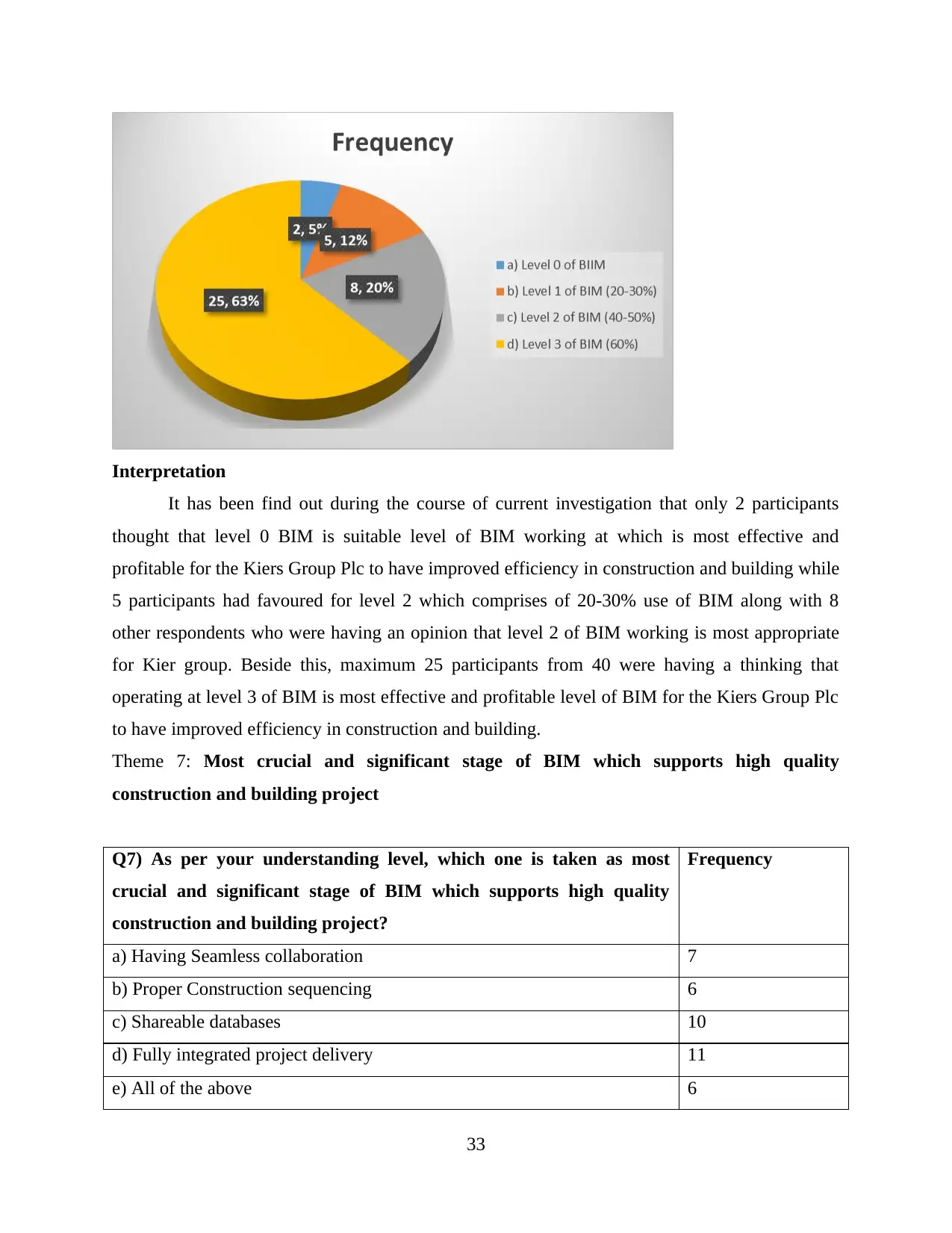
Interpretation
It has been find out during the course of current investigation that only 2 participants
thought that level 0 BIM is suitable level of BIM working at which is most effective and
profitable for the Kiers Group Plc to have improved efficiency in construction and building while
5 participants had favoured for level 2 which comprises of 20-30% use of BIM along with 8
other respondents who were having an opinion that level 2 of BIM working is most appropriate
for Kier group. Beside this, maximum 25 participants from 40 were having a thinking that
operating at level 3 of BIM is most effective and profitable level of BIM for the Kiers Group Plc
to have improved efficiency in construction and building.
Theme 7: Most crucial and significant stage of BIM which supports high quality
construction and building project
Q7) As per your understanding level, which one is taken as most
crucial and significant stage of BIM which supports high quality
construction and building project?
Frequency
a) Having Seamless collaboration 7
b) Proper Construction sequencing 6
c) Shareable databases 10
d) Fully integrated project delivery 11
e) All of the above 6
33
It has been find out during the course of current investigation that only 2 participants
thought that level 0 BIM is suitable level of BIM working at which is most effective and
profitable for the Kiers Group Plc to have improved efficiency in construction and building while
5 participants had favoured for level 2 which comprises of 20-30% use of BIM along with 8
other respondents who were having an opinion that level 2 of BIM working is most appropriate
for Kier group. Beside this, maximum 25 participants from 40 were having a thinking that
operating at level 3 of BIM is most effective and profitable level of BIM for the Kiers Group Plc
to have improved efficiency in construction and building.
Theme 7: Most crucial and significant stage of BIM which supports high quality
construction and building project
Q7) As per your understanding level, which one is taken as most
crucial and significant stage of BIM which supports high quality
construction and building project?
Frequency
a) Having Seamless collaboration 7
b) Proper Construction sequencing 6
c) Shareable databases 10
d) Fully integrated project delivery 11
e) All of the above 6
33
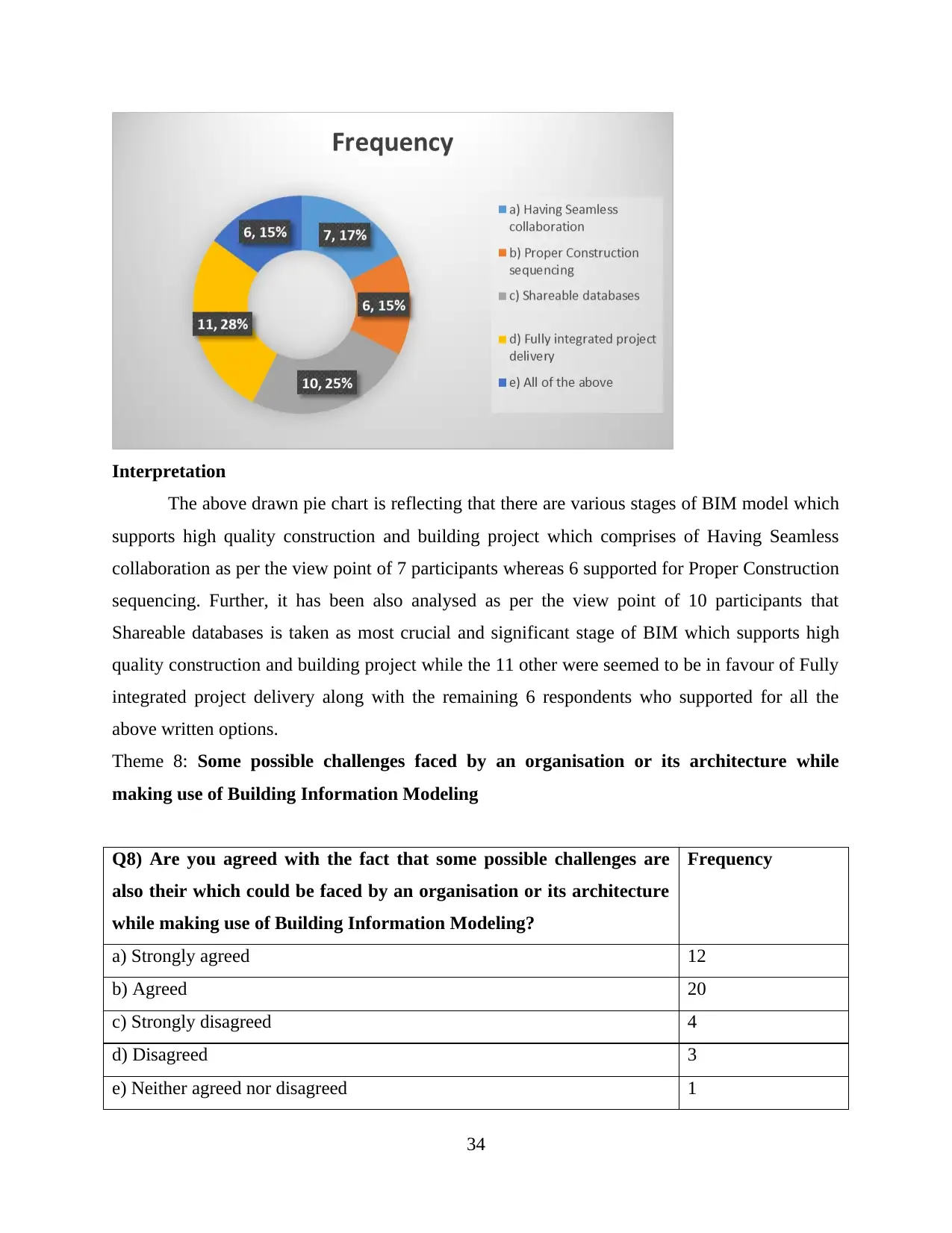
Interpretation
The above drawn pie chart is reflecting that there are various stages of BIM model which
supports high quality construction and building project which comprises of Having Seamless
collaboration as per the view point of 7 participants whereas 6 supported for Proper Construction
sequencing. Further, it has been also analysed as per the view point of 10 participants that
Shareable databases is taken as most crucial and significant stage of BIM which supports high
quality construction and building project while the 11 other were seemed to be in favour of Fully
integrated project delivery along with the remaining 6 respondents who supported for all the
above written options.
Theme 8: Some possible challenges faced by an organisation or its architecture while
making use of Building Information Modeling
Q8) Are you agreed with the fact that some possible challenges are
also their which could be faced by an organisation or its architecture
while making use of Building Information Modeling?
Frequency
a) Strongly agreed 12
b) Agreed 20
c) Strongly disagreed 4
d) Disagreed 3
e) Neither agreed nor disagreed 1
34
The above drawn pie chart is reflecting that there are various stages of BIM model which
supports high quality construction and building project which comprises of Having Seamless
collaboration as per the view point of 7 participants whereas 6 supported for Proper Construction
sequencing. Further, it has been also analysed as per the view point of 10 participants that
Shareable databases is taken as most crucial and significant stage of BIM which supports high
quality construction and building project while the 11 other were seemed to be in favour of Fully
integrated project delivery along with the remaining 6 respondents who supported for all the
above written options.
Theme 8: Some possible challenges faced by an organisation or its architecture while
making use of Building Information Modeling
Q8) Are you agreed with the fact that some possible challenges are
also their which could be faced by an organisation or its architecture
while making use of Building Information Modeling?
Frequency
a) Strongly agreed 12
b) Agreed 20
c) Strongly disagreed 4
d) Disagreed 3
e) Neither agreed nor disagreed 1
34
Paraphrase This Document
Need a fresh take? Get an instant paraphrase of this document with our AI Paraphraser
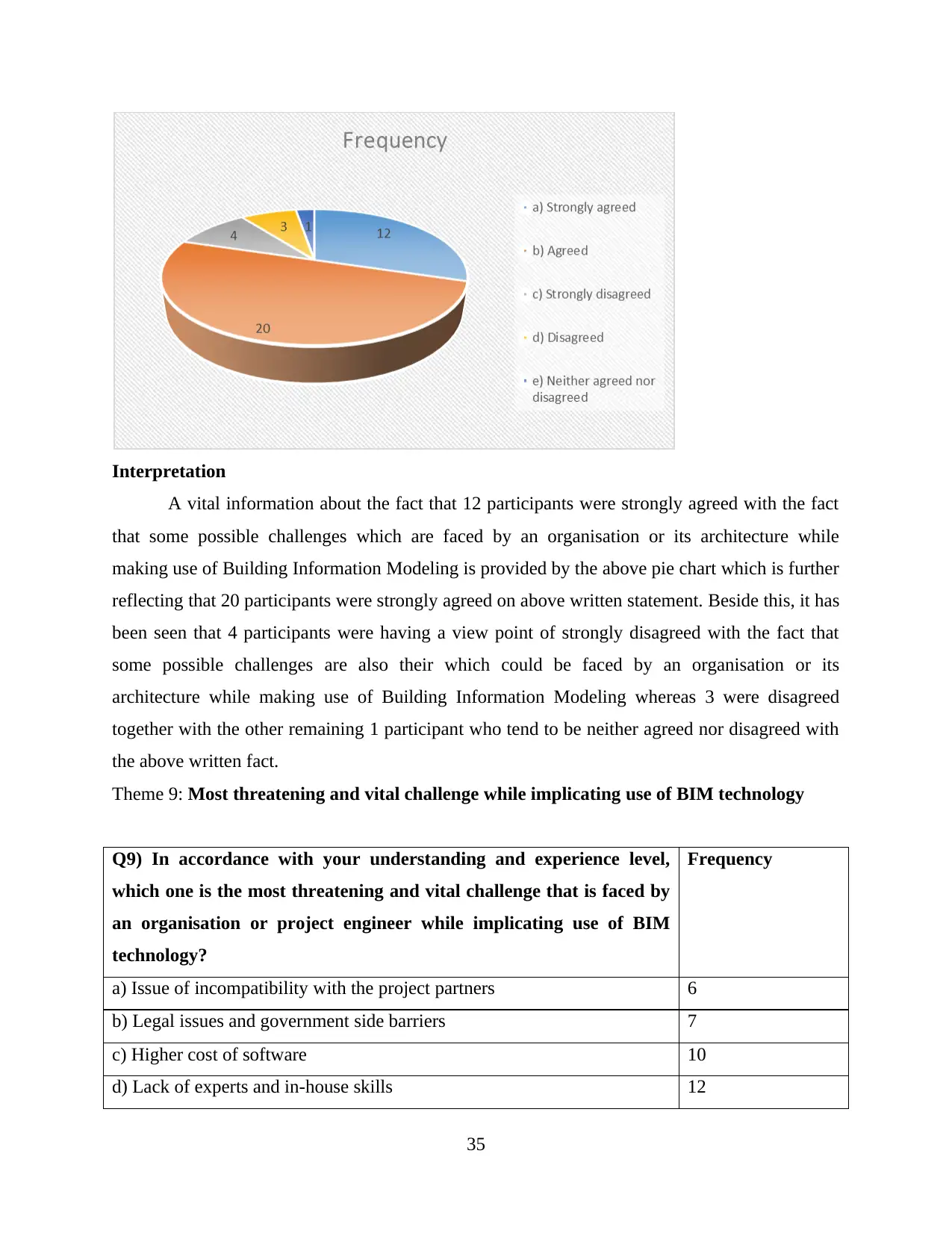
Interpretation
A vital information about the fact that 12 participants were strongly agreed with the fact
that some possible challenges which are faced by an organisation or its architecture while
making use of Building Information Modeling is provided by the above pie chart which is further
reflecting that 20 participants were strongly agreed on above written statement. Beside this, it has
been seen that 4 participants were having a view point of strongly disagreed with the fact that
some possible challenges are also their which could be faced by an organisation or its
architecture while making use of Building Information Modeling whereas 3 were disagreed
together with the other remaining 1 participant who tend to be neither agreed nor disagreed with
the above written fact.
Theme 9: Most threatening and vital challenge while implicating use of BIM technology
Q9) In accordance with your understanding and experience level,
which one is the most threatening and vital challenge that is faced by
an organisation or project engineer while implicating use of BIM
technology?
Frequency
a) Issue of incompatibility with the project partners 6
b) Legal issues and government side barriers 7
c) Higher cost of software 10
d) Lack of experts and in-house skills 12
35
A vital information about the fact that 12 participants were strongly agreed with the fact
that some possible challenges which are faced by an organisation or its architecture while
making use of Building Information Modeling is provided by the above pie chart which is further
reflecting that 20 participants were strongly agreed on above written statement. Beside this, it has
been seen that 4 participants were having a view point of strongly disagreed with the fact that
some possible challenges are also their which could be faced by an organisation or its
architecture while making use of Building Information Modeling whereas 3 were disagreed
together with the other remaining 1 participant who tend to be neither agreed nor disagreed with
the above written fact.
Theme 9: Most threatening and vital challenge while implicating use of BIM technology
Q9) In accordance with your understanding and experience level,
which one is the most threatening and vital challenge that is faced by
an organisation or project engineer while implicating use of BIM
technology?
Frequency
a) Issue of incompatibility with the project partners 6
b) Legal issues and government side barriers 7
c) Higher cost of software 10
d) Lack of experts and in-house skills 12
35
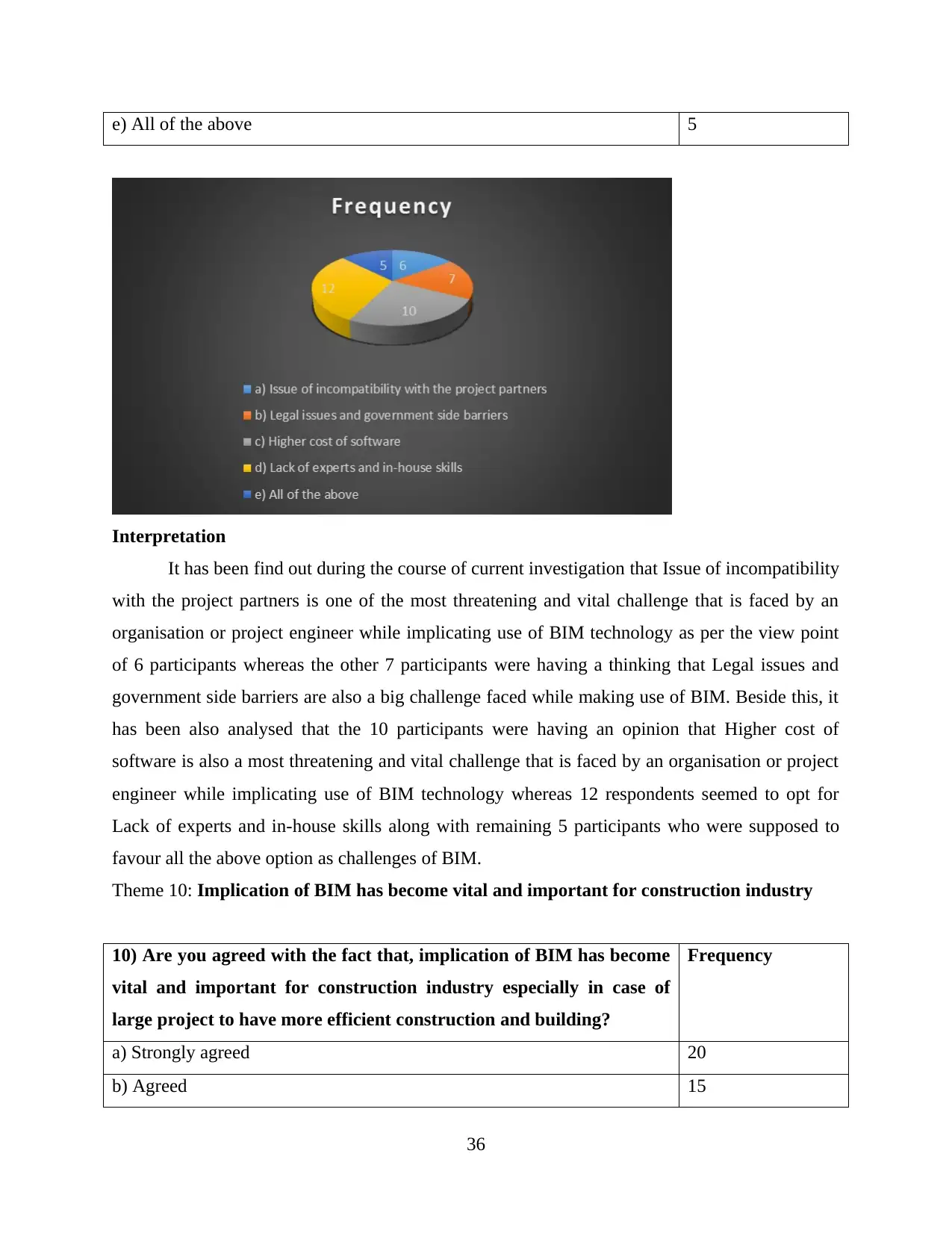
e) All of the above 5
Interpretation
It has been find out during the course of current investigation that Issue of incompatibility
with the project partners is one of the most threatening and vital challenge that is faced by an
organisation or project engineer while implicating use of BIM technology as per the view point
of 6 participants whereas the other 7 participants were having a thinking that Legal issues and
government side barriers are also a big challenge faced while making use of BIM. Beside this, it
has been also analysed that the 10 participants were having an opinion that Higher cost of
software is also a most threatening and vital challenge that is faced by an organisation or project
engineer while implicating use of BIM technology whereas 12 respondents seemed to opt for
Lack of experts and in-house skills along with remaining 5 participants who were supposed to
favour all the above option as challenges of BIM.
Theme 10: Implication of BIM has become vital and important for construction industry
10) Are you agreed with the fact that, implication of BIM has become
vital and important for construction industry especially in case of
large project to have more efficient construction and building?
Frequency
a) Strongly agreed 20
b) Agreed 15
36
Interpretation
It has been find out during the course of current investigation that Issue of incompatibility
with the project partners is one of the most threatening and vital challenge that is faced by an
organisation or project engineer while implicating use of BIM technology as per the view point
of 6 participants whereas the other 7 participants were having a thinking that Legal issues and
government side barriers are also a big challenge faced while making use of BIM. Beside this, it
has been also analysed that the 10 participants were having an opinion that Higher cost of
software is also a most threatening and vital challenge that is faced by an organisation or project
engineer while implicating use of BIM technology whereas 12 respondents seemed to opt for
Lack of experts and in-house skills along with remaining 5 participants who were supposed to
favour all the above option as challenges of BIM.
Theme 10: Implication of BIM has become vital and important for construction industry
10) Are you agreed with the fact that, implication of BIM has become
vital and important for construction industry especially in case of
large project to have more efficient construction and building?
Frequency
a) Strongly agreed 20
b) Agreed 15
36
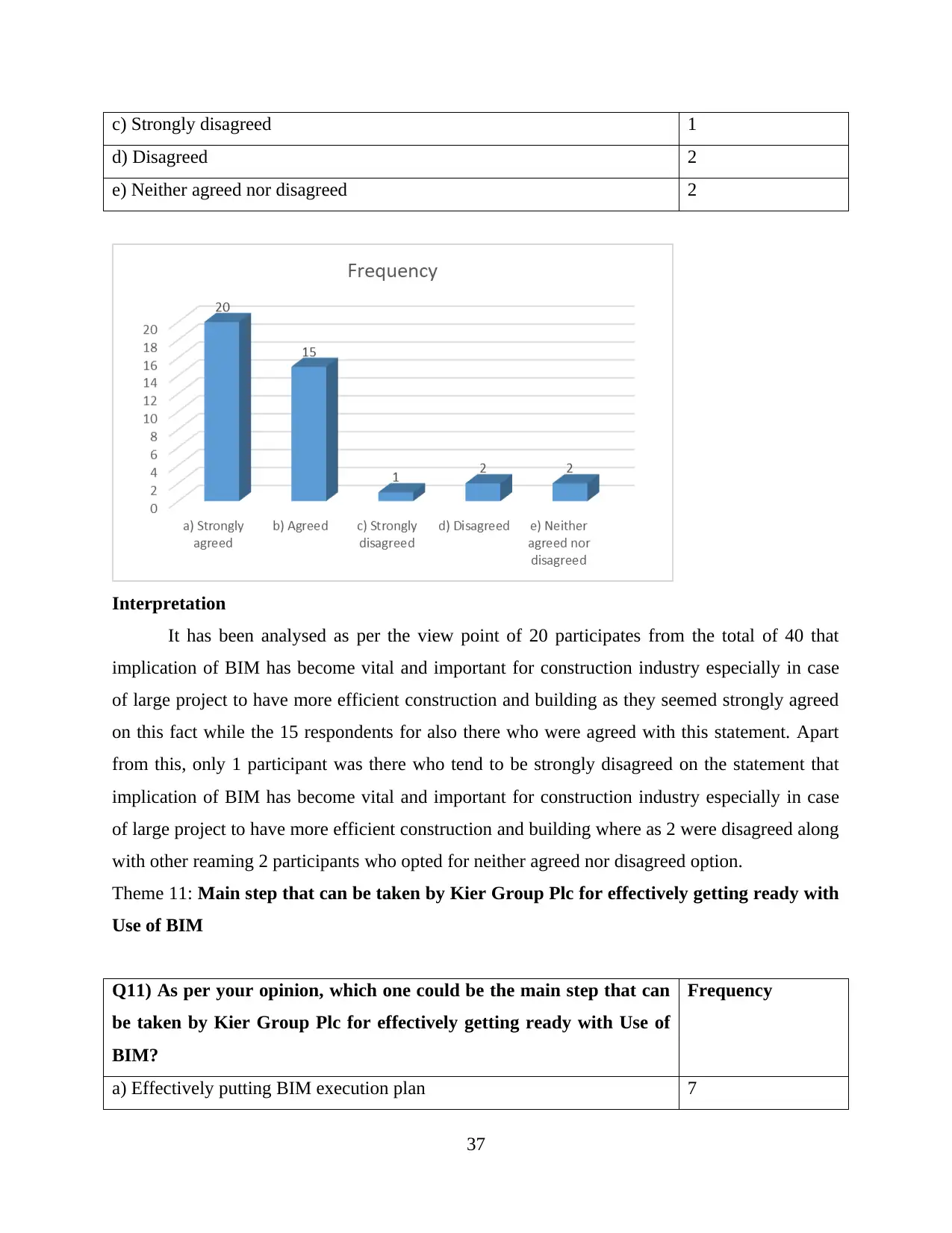
c) Strongly disagreed 1
d) Disagreed 2
e) Neither agreed nor disagreed 2
Interpretation
It has been analysed as per the view point of 20 participates from the total of 40 that
implication of BIM has become vital and important for construction industry especially in case
of large project to have more efficient construction and building as they seemed strongly agreed
on this fact while the 15 respondents for also there who were agreed with this statement. Apart
from this, only 1 participant was there who tend to be strongly disagreed on the statement that
implication of BIM has become vital and important for construction industry especially in case
of large project to have more efficient construction and building where as 2 were disagreed along
with other reaming 2 participants who opted for neither agreed nor disagreed option.
Theme 11: Main step that can be taken by Kier Group Plc for effectively getting ready with
Use of BIM
Q11) As per your opinion, which one could be the main step that can
be taken by Kier Group Plc for effectively getting ready with Use of
BIM?
Frequency
a) Effectively putting BIM execution plan 7
37
d) Disagreed 2
e) Neither agreed nor disagreed 2
Interpretation
It has been analysed as per the view point of 20 participates from the total of 40 that
implication of BIM has become vital and important for construction industry especially in case
of large project to have more efficient construction and building as they seemed strongly agreed
on this fact while the 15 respondents for also there who were agreed with this statement. Apart
from this, only 1 participant was there who tend to be strongly disagreed on the statement that
implication of BIM has become vital and important for construction industry especially in case
of large project to have more efficient construction and building where as 2 were disagreed along
with other reaming 2 participants who opted for neither agreed nor disagreed option.
Theme 11: Main step that can be taken by Kier Group Plc for effectively getting ready with
Use of BIM
Q11) As per your opinion, which one could be the main step that can
be taken by Kier Group Plc for effectively getting ready with Use of
BIM?
Frequency
a) Effectively putting BIM execution plan 7
37
Secure Best Marks with AI Grader
Need help grading? Try our AI Grader for instant feedback on your assignments.
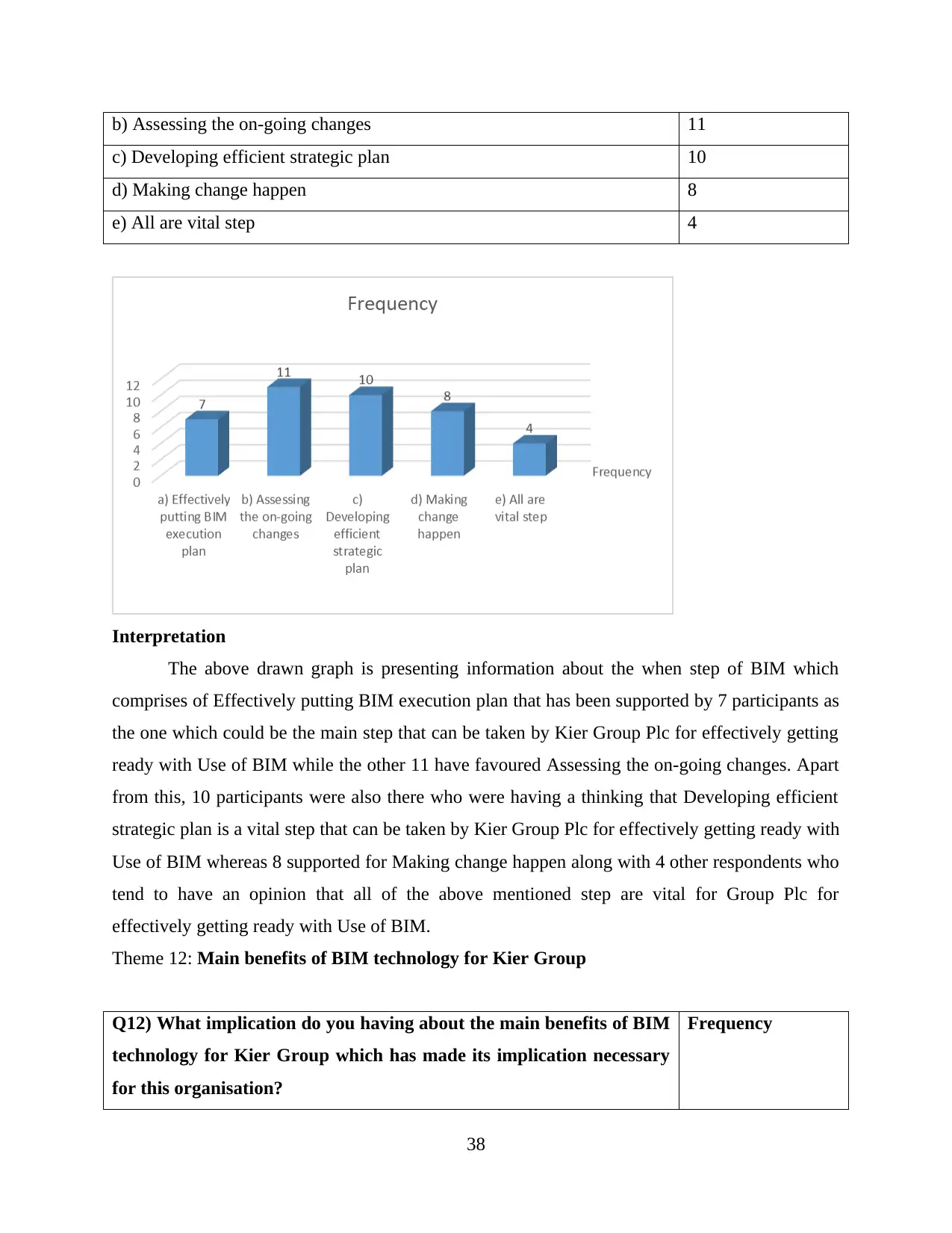
b) Assessing the on-going changes 11
c) Developing efficient strategic plan 10
d) Making change happen 8
e) All are vital step 4
Interpretation
The above drawn graph is presenting information about the when step of BIM which
comprises of Effectively putting BIM execution plan that has been supported by 7 participants as
the one which could be the main step that can be taken by Kier Group Plc for effectively getting
ready with Use of BIM while the other 11 have favoured Assessing the on-going changes. Apart
from this, 10 participants were also there who were having a thinking that Developing efficient
strategic plan is a vital step that can be taken by Kier Group Plc for effectively getting ready with
Use of BIM whereas 8 supported for Making change happen along with 4 other respondents who
tend to have an opinion that all of the above mentioned step are vital for Group Plc for
effectively getting ready with Use of BIM.
Theme 12: Main benefits of BIM technology for Kier Group
Q12) What implication do you having about the main benefits of BIM
technology for Kier Group which has made its implication necessary
for this organisation?
Frequency
38
c) Developing efficient strategic plan 10
d) Making change happen 8
e) All are vital step 4
Interpretation
The above drawn graph is presenting information about the when step of BIM which
comprises of Effectively putting BIM execution plan that has been supported by 7 participants as
the one which could be the main step that can be taken by Kier Group Plc for effectively getting
ready with Use of BIM while the other 11 have favoured Assessing the on-going changes. Apart
from this, 10 participants were also there who were having a thinking that Developing efficient
strategic plan is a vital step that can be taken by Kier Group Plc for effectively getting ready with
Use of BIM whereas 8 supported for Making change happen along with 4 other respondents who
tend to have an opinion that all of the above mentioned step are vital for Group Plc for
effectively getting ready with Use of BIM.
Theme 12: Main benefits of BIM technology for Kier Group
Q12) What implication do you having about the main benefits of BIM
technology for Kier Group which has made its implication necessary
for this organisation?
Frequency
38
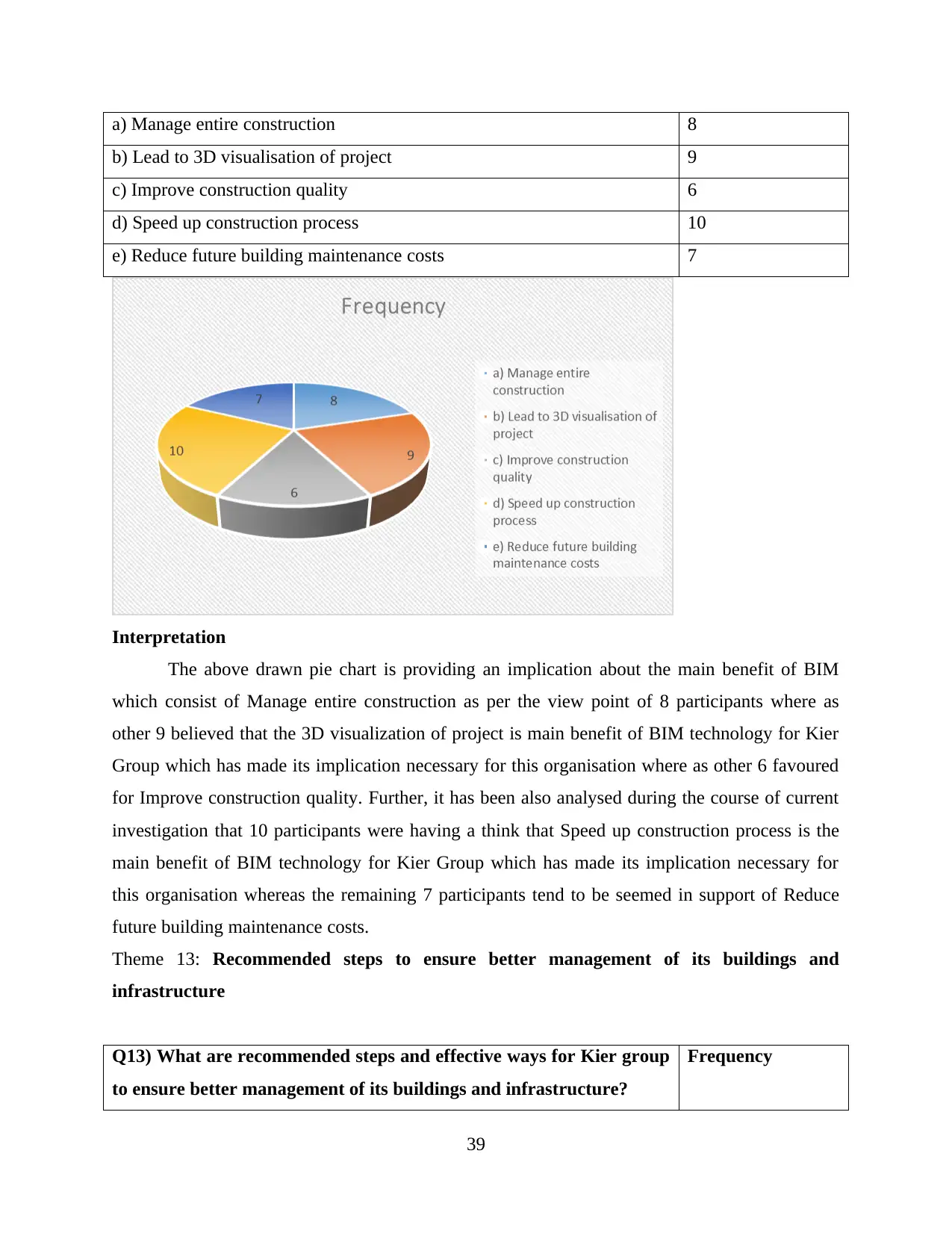
a) Manage entire construction 8
b) Lead to 3D visualisation of project 9
c) Improve construction quality 6
d) Speed up construction process 10
e) Reduce future building maintenance costs 7
Interpretation
The above drawn pie chart is providing an implication about the main benefit of BIM
which consist of Manage entire construction as per the view point of 8 participants where as
other 9 believed that the 3D visualization of project is main benefit of BIM technology for Kier
Group which has made its implication necessary for this organisation where as other 6 favoured
for Improve construction quality. Further, it has been also analysed during the course of current
investigation that 10 participants were having a think that Speed up construction process is the
main benefit of BIM technology for Kier Group which has made its implication necessary for
this organisation whereas the remaining 7 participants tend to be seemed in support of Reduce
future building maintenance costs.
Theme 13: Recommended steps to ensure better management of its buildings and
infrastructure
Q13) What are recommended steps and effective ways for Kier group
to ensure better management of its buildings and infrastructure?
Frequency
39
b) Lead to 3D visualisation of project 9
c) Improve construction quality 6
d) Speed up construction process 10
e) Reduce future building maintenance costs 7
Interpretation
The above drawn pie chart is providing an implication about the main benefit of BIM
which consist of Manage entire construction as per the view point of 8 participants where as
other 9 believed that the 3D visualization of project is main benefit of BIM technology for Kier
Group which has made its implication necessary for this organisation where as other 6 favoured
for Improve construction quality. Further, it has been also analysed during the course of current
investigation that 10 participants were having a think that Speed up construction process is the
main benefit of BIM technology for Kier Group which has made its implication necessary for
this organisation whereas the remaining 7 participants tend to be seemed in support of Reduce
future building maintenance costs.
Theme 13: Recommended steps to ensure better management of its buildings and
infrastructure
Q13) What are recommended steps and effective ways for Kier group
to ensure better management of its buildings and infrastructure?
Frequency
39
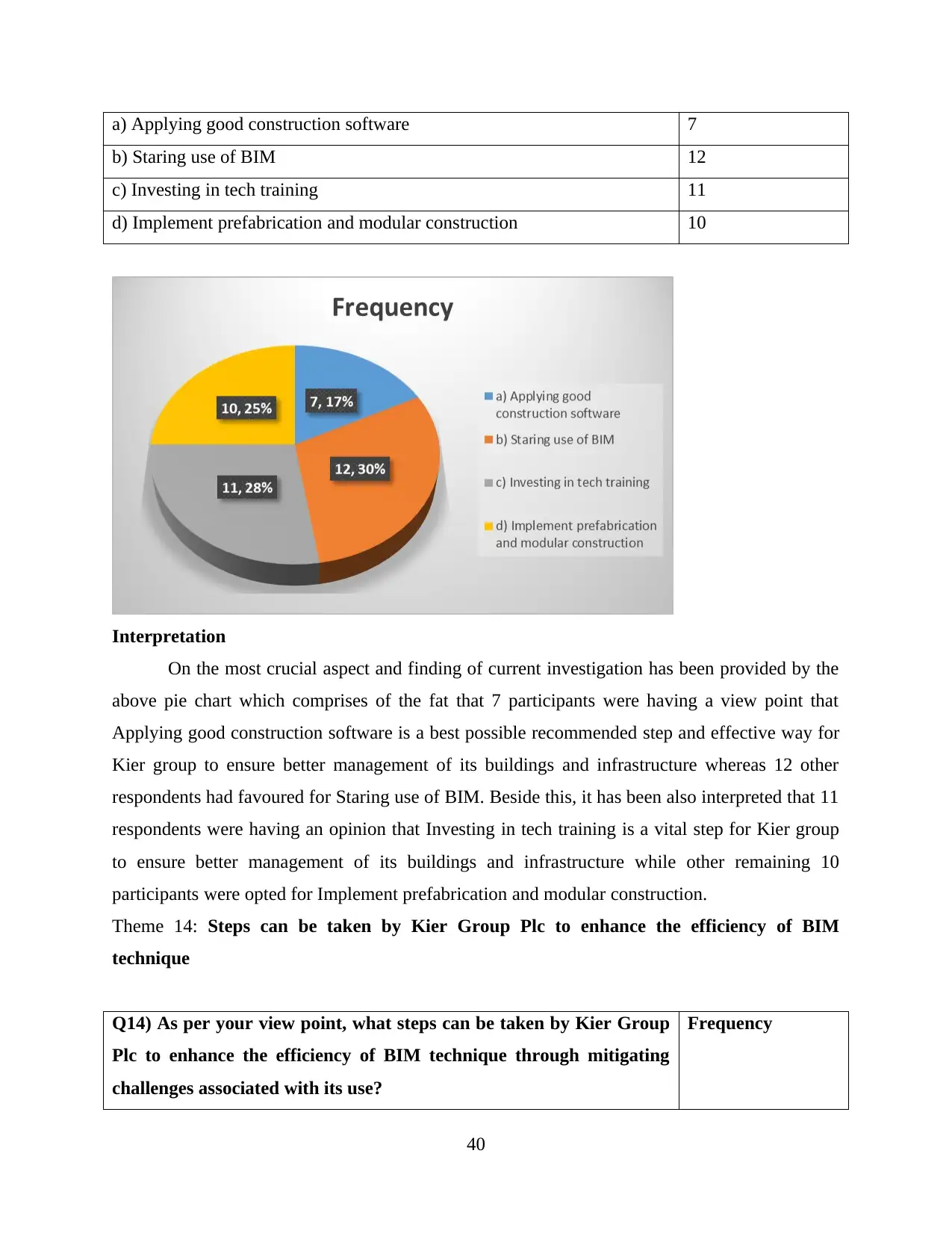
a) Applying good construction software 7
b) Staring use of BIM 12
c) Investing in tech training 11
d) Implement prefabrication and modular construction 10
Interpretation
On the most crucial aspect and finding of current investigation has been provided by the
above pie chart which comprises of the fat that 7 participants were having a view point that
Applying good construction software is a best possible recommended step and effective way for
Kier group to ensure better management of its buildings and infrastructure whereas 12 other
respondents had favoured for Staring use of BIM. Beside this, it has been also interpreted that 11
respondents were having an opinion that Investing in tech training is a vital step for Kier group
to ensure better management of its buildings and infrastructure while other remaining 10
participants were opted for Implement prefabrication and modular construction.
Theme 14: Steps can be taken by Kier Group Plc to enhance the efficiency of BIM
technique
Q14) As per your view point, what steps can be taken by Kier Group
Plc to enhance the efficiency of BIM technique through mitigating
challenges associated with its use?
Frequency
40
b) Staring use of BIM 12
c) Investing in tech training 11
d) Implement prefabrication and modular construction 10
Interpretation
On the most crucial aspect and finding of current investigation has been provided by the
above pie chart which comprises of the fat that 7 participants were having a view point that
Applying good construction software is a best possible recommended step and effective way for
Kier group to ensure better management of its buildings and infrastructure whereas 12 other
respondents had favoured for Staring use of BIM. Beside this, it has been also interpreted that 11
respondents were having an opinion that Investing in tech training is a vital step for Kier group
to ensure better management of its buildings and infrastructure while other remaining 10
participants were opted for Implement prefabrication and modular construction.
Theme 14: Steps can be taken by Kier Group Plc to enhance the efficiency of BIM
technique
Q14) As per your view point, what steps can be taken by Kier Group
Plc to enhance the efficiency of BIM technique through mitigating
challenges associated with its use?
Frequency
40
Paraphrase This Document
Need a fresh take? Get an instant paraphrase of this document with our AI Paraphraser
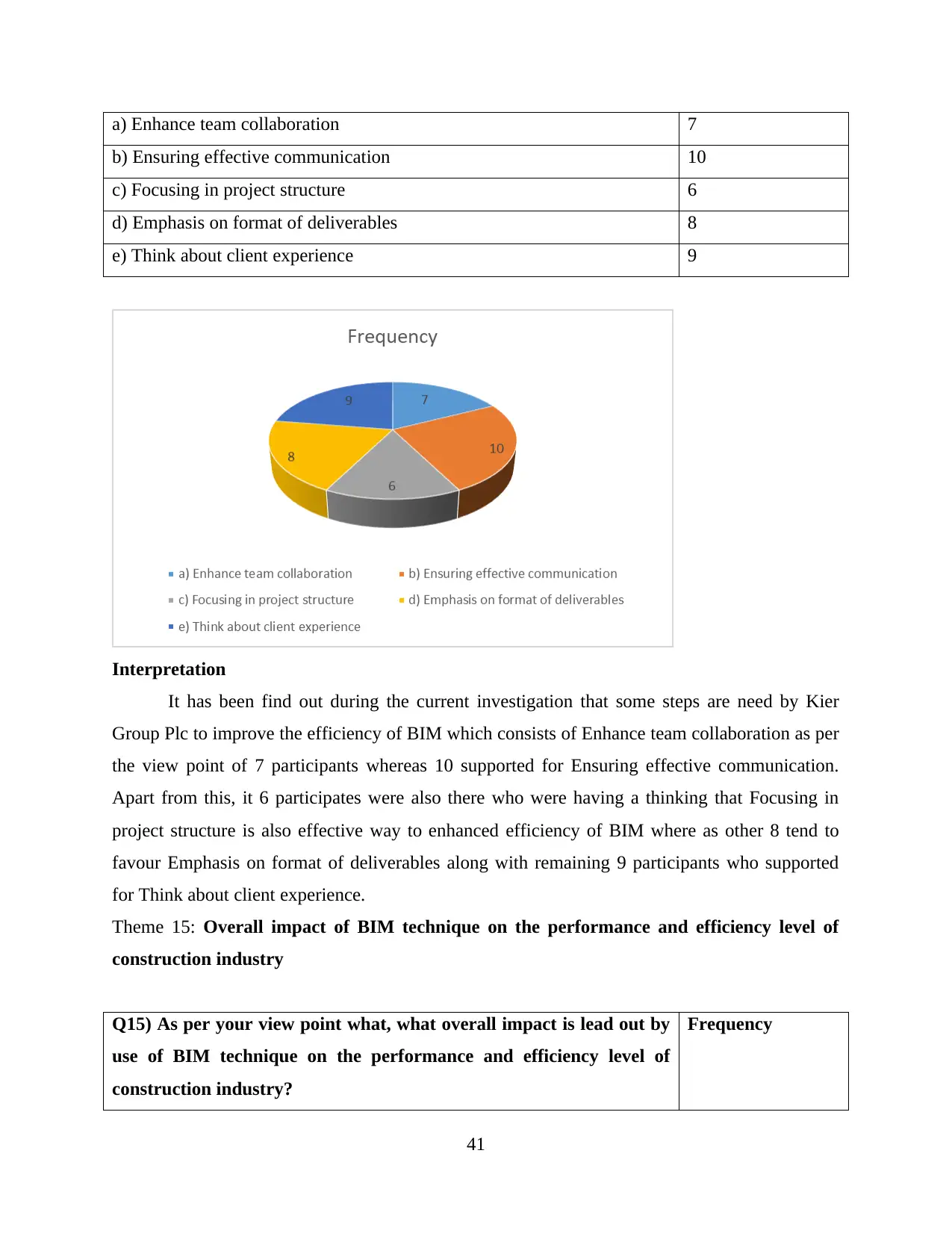
a) Enhance team collaboration 7
b) Ensuring effective communication 10
c) Focusing in project structure 6
d) Emphasis on format of deliverables 8
e) Think about client experience 9
Interpretation
It has been find out during the current investigation that some steps are need by Kier
Group Plc to improve the efficiency of BIM which consists of Enhance team collaboration as per
the view point of 7 participants whereas 10 supported for Ensuring effective communication.
Apart from this, it 6 participates were also there who were having a thinking that Focusing in
project structure is also effective way to enhanced efficiency of BIM where as other 8 tend to
favour Emphasis on format of deliverables along with remaining 9 participants who supported
for Think about client experience.
Theme 15: Overall impact of BIM technique on the performance and efficiency level of
construction industry
Q15) As per your view point what, what overall impact is lead out by
use of BIM technique on the performance and efficiency level of
construction industry?
Frequency
41
b) Ensuring effective communication 10
c) Focusing in project structure 6
d) Emphasis on format of deliverables 8
e) Think about client experience 9
Interpretation
It has been find out during the current investigation that some steps are need by Kier
Group Plc to improve the efficiency of BIM which consists of Enhance team collaboration as per
the view point of 7 participants whereas 10 supported for Ensuring effective communication.
Apart from this, it 6 participates were also there who were having a thinking that Focusing in
project structure is also effective way to enhanced efficiency of BIM where as other 8 tend to
favour Emphasis on format of deliverables along with remaining 9 participants who supported
for Think about client experience.
Theme 15: Overall impact of BIM technique on the performance and efficiency level of
construction industry
Q15) As per your view point what, what overall impact is lead out by
use of BIM technique on the performance and efficiency level of
construction industry?
Frequency
41
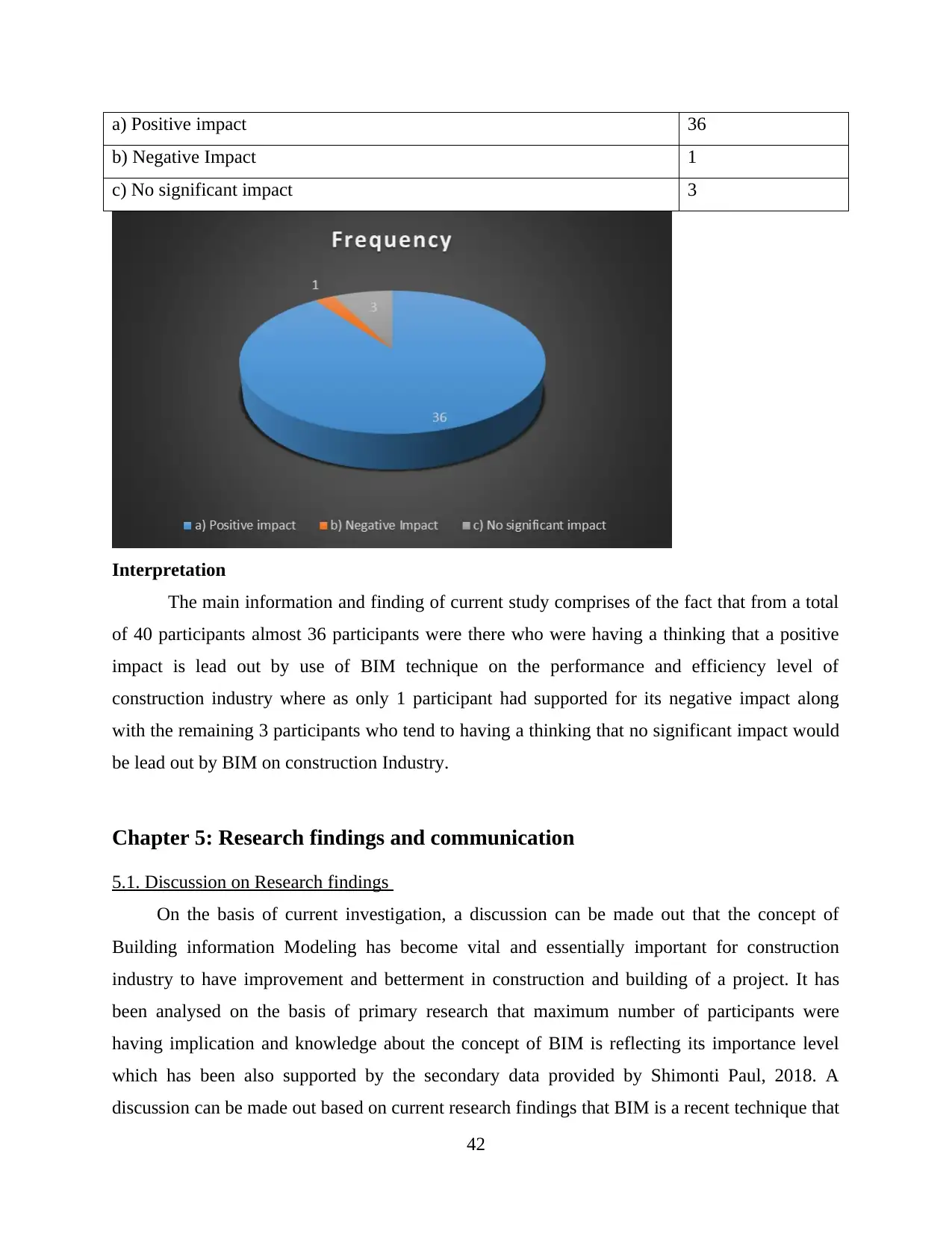
a) Positive impact 36
b) Negative Impact 1
c) No significant impact 3
Interpretation
The main information and finding of current study comprises of the fact that from a total
of 40 participants almost 36 participants were there who were having a thinking that a positive
impact is lead out by use of BIM technique on the performance and efficiency level of
construction industry where as only 1 participant had supported for its negative impact along
with the remaining 3 participants who tend to having a thinking that no significant impact would
be lead out by BIM on construction Industry.
Chapter 5: Research findings and communication
5.1. Discussion on Research findings
On the basis of current investigation, a discussion can be made out that the concept of
Building information Modeling has become vital and essentially important for construction
industry to have improvement and betterment in construction and building of a project. It has
been analysed on the basis of primary research that maximum number of participants were
having implication and knowledge about the concept of BIM is reflecting its importance level
which has been also supported by the secondary data provided by Shimonti Paul, 2018. A
discussion can be made out based on current research findings that BIM is a recent technique that
42
b) Negative Impact 1
c) No significant impact 3
Interpretation
The main information and finding of current study comprises of the fact that from a total
of 40 participants almost 36 participants were there who were having a thinking that a positive
impact is lead out by use of BIM technique on the performance and efficiency level of
construction industry where as only 1 participant had supported for its negative impact along
with the remaining 3 participants who tend to having a thinking that no significant impact would
be lead out by BIM on construction Industry.
Chapter 5: Research findings and communication
5.1. Discussion on Research findings
On the basis of current investigation, a discussion can be made out that the concept of
Building information Modeling has become vital and essentially important for construction
industry to have improvement and betterment in construction and building of a project. It has
been analysed on the basis of primary research that maximum number of participants were
having implication and knowledge about the concept of BIM is reflecting its importance level
which has been also supported by the secondary data provided by Shimonti Paul, 2018. A
discussion can be made out based on current research findings that BIM is a recent technique that
42
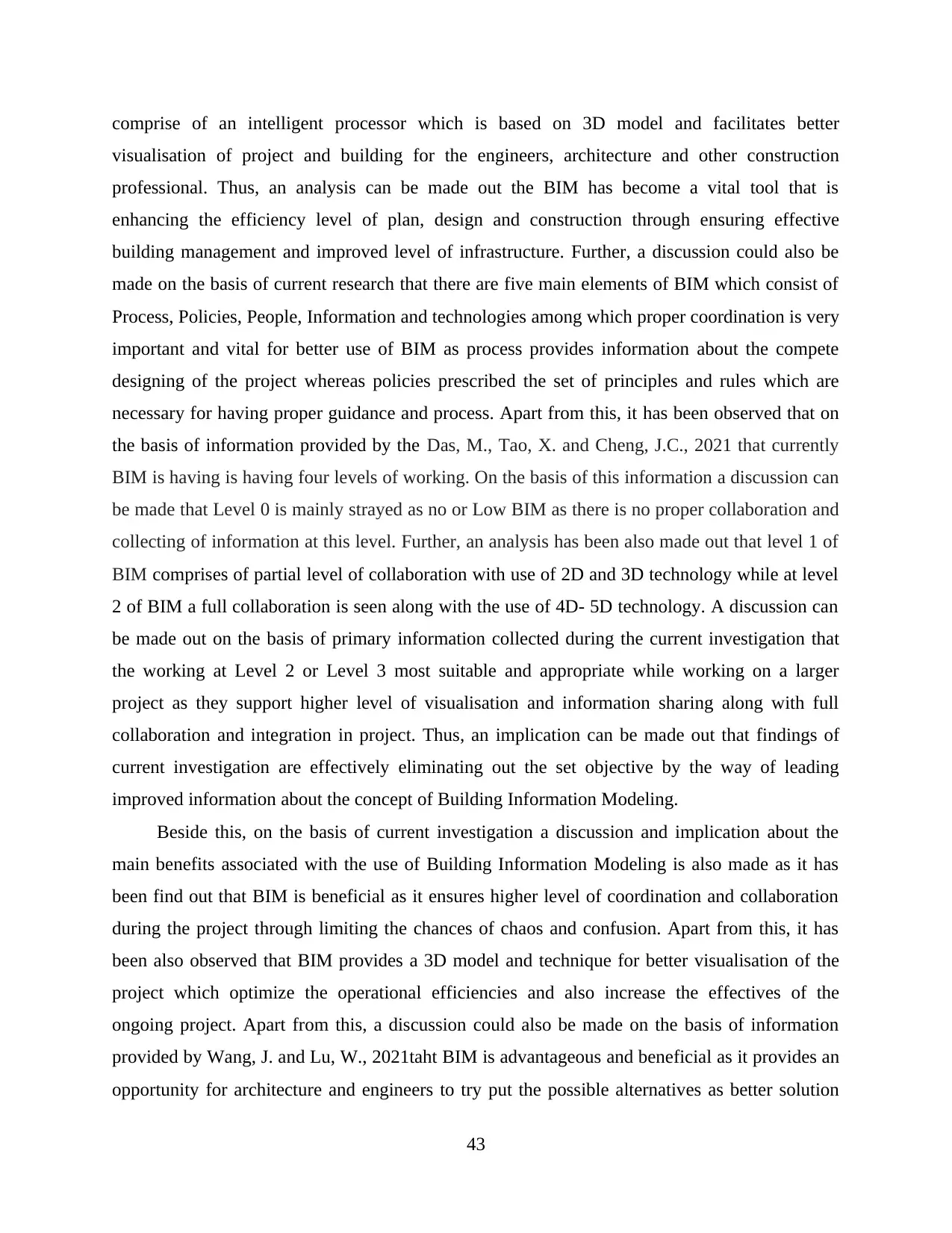
comprise of an intelligent processor which is based on 3D model and facilitates better
visualisation of project and building for the engineers, architecture and other construction
professional. Thus, an analysis can be made out the BIM has become a vital tool that is
enhancing the efficiency level of plan, design and construction through ensuring effective
building management and improved level of infrastructure. Further, a discussion could also be
made on the basis of current research that there are five main elements of BIM which consist of
Process, Policies, People, Information and technologies among which proper coordination is very
important and vital for better use of BIM as process provides information about the compete
designing of the project whereas policies prescribed the set of principles and rules which are
necessary for having proper guidance and process. Apart from this, it has been observed that on
the basis of information provided by the Das, M., Tao, X. and Cheng, J.C., 2021 that currently
BIM is having is having four levels of working. On the basis of this information a discussion can
be made that Level 0 is mainly strayed as no or Low BIM as there is no proper collaboration and
collecting of information at this level. Further, an analysis has been also made out that level 1 of
BIM comprises of partial level of collaboration with use of 2D and 3D technology while at level
2 of BIM a full collaboration is seen along with the use of 4D- 5D technology. A discussion can
be made out on the basis of primary information collected during the current investigation that
the working at Level 2 or Level 3 most suitable and appropriate while working on a larger
project as they support higher level of visualisation and information sharing along with full
collaboration and integration in project. Thus, an implication can be made out that findings of
current investigation are effectively eliminating out the set objective by the way of leading
improved information about the concept of Building Information Modeling.
Beside this, on the basis of current investigation a discussion and implication about the
main benefits associated with the use of Building Information Modeling is also made as it has
been find out that BIM is beneficial as it ensures higher level of coordination and collaboration
during the project through limiting the chances of chaos and confusion. Apart from this, it has
been also observed that BIM provides a 3D model and technique for better visualisation of the
project which optimize the operational efficiencies and also increase the effectives of the
ongoing project. Apart from this, a discussion could also be made on the basis of information
provided by Wang, J. and Lu, W., 2021taht BIM is advantageous and beneficial as it provides an
opportunity for architecture and engineers to try put the possible alternatives as better solution
43
visualisation of project and building for the engineers, architecture and other construction
professional. Thus, an analysis can be made out the BIM has become a vital tool that is
enhancing the efficiency level of plan, design and construction through ensuring effective
building management and improved level of infrastructure. Further, a discussion could also be
made on the basis of current research that there are five main elements of BIM which consist of
Process, Policies, People, Information and technologies among which proper coordination is very
important and vital for better use of BIM as process provides information about the compete
designing of the project whereas policies prescribed the set of principles and rules which are
necessary for having proper guidance and process. Apart from this, it has been observed that on
the basis of information provided by the Das, M., Tao, X. and Cheng, J.C., 2021 that currently
BIM is having is having four levels of working. On the basis of this information a discussion can
be made that Level 0 is mainly strayed as no or Low BIM as there is no proper collaboration and
collecting of information at this level. Further, an analysis has been also made out that level 1 of
BIM comprises of partial level of collaboration with use of 2D and 3D technology while at level
2 of BIM a full collaboration is seen along with the use of 4D- 5D technology. A discussion can
be made out on the basis of primary information collected during the current investigation that
the working at Level 2 or Level 3 most suitable and appropriate while working on a larger
project as they support higher level of visualisation and information sharing along with full
collaboration and integration in project. Thus, an implication can be made out that findings of
current investigation are effectively eliminating out the set objective by the way of leading
improved information about the concept of Building Information Modeling.
Beside this, on the basis of current investigation a discussion and implication about the
main benefits associated with the use of Building Information Modeling is also made as it has
been find out that BIM is beneficial as it ensures higher level of coordination and collaboration
during the project through limiting the chances of chaos and confusion. Apart from this, it has
been also observed that BIM provides a 3D model and technique for better visualisation of the
project which optimize the operational efficiencies and also increase the effectives of the
ongoing project. Apart from this, a discussion could also be made on the basis of information
provided by Wang, J. and Lu, W., 2021taht BIM is advantageous and beneficial as it provides an
opportunity for architecture and engineers to try put the possible alternatives as better solution
43
Secure Best Marks with AI Grader
Need help grading? Try our AI Grader for instant feedback on your assignments.
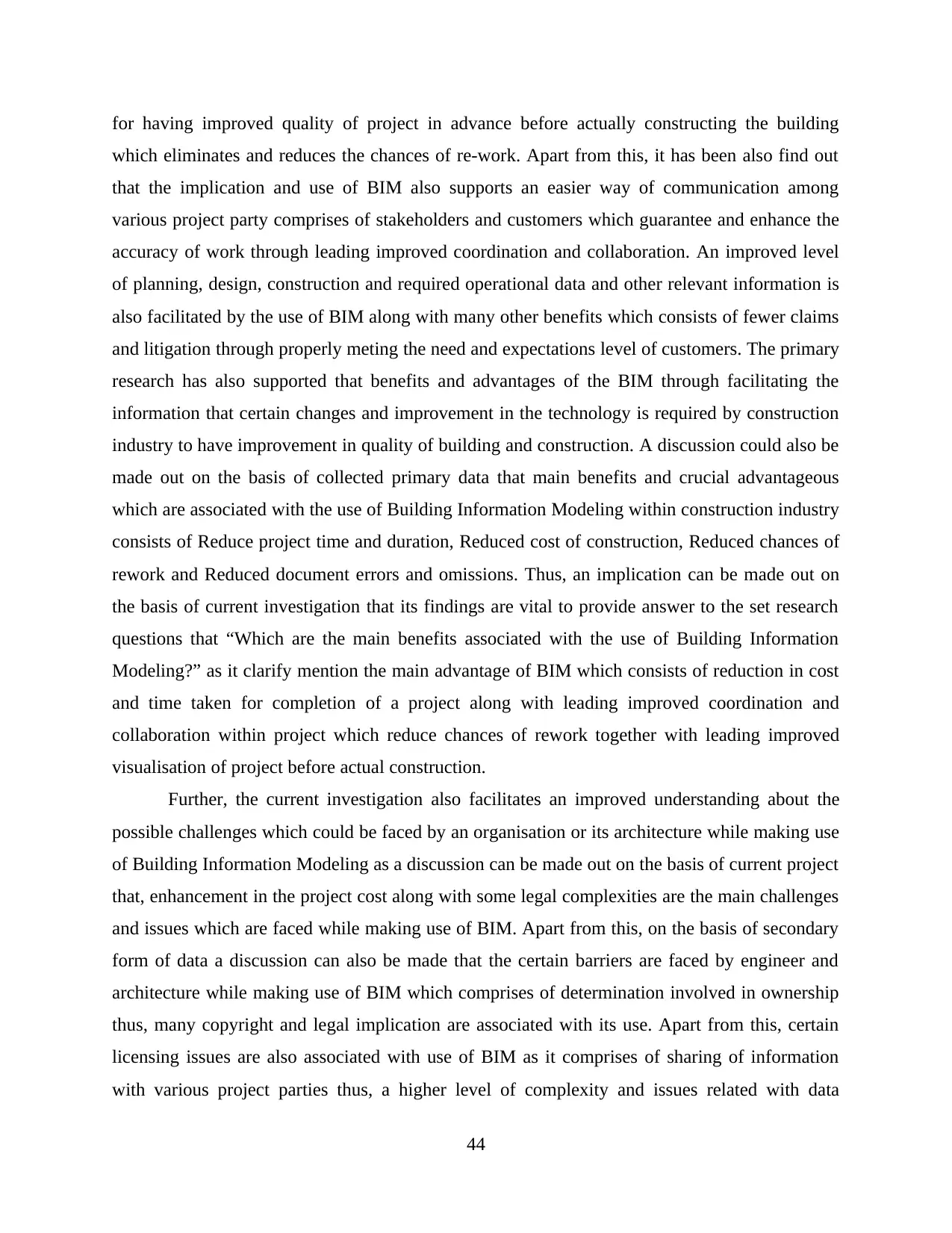
for having improved quality of project in advance before actually constructing the building
which eliminates and reduces the chances of re-work. Apart from this, it has been also find out
that the implication and use of BIM also supports an easier way of communication among
various project party comprises of stakeholders and customers which guarantee and enhance the
accuracy of work through leading improved coordination and collaboration. An improved level
of planning, design, construction and required operational data and other relevant information is
also facilitated by the use of BIM along with many other benefits which consists of fewer claims
and litigation through properly meting the need and expectations level of customers. The primary
research has also supported that benefits and advantages of the BIM through facilitating the
information that certain changes and improvement in the technology is required by construction
industry to have improvement in quality of building and construction. A discussion could also be
made out on the basis of collected primary data that main benefits and crucial advantageous
which are associated with the use of Building Information Modeling within construction industry
consists of Reduce project time and duration, Reduced cost of construction, Reduced chances of
rework and Reduced document errors and omissions. Thus, an implication can be made out on
the basis of current investigation that its findings are vital to provide answer to the set research
questions that “Which are the main benefits associated with the use of Building Information
Modeling?” as it clarify mention the main advantage of BIM which consists of reduction in cost
and time taken for completion of a project along with leading improved coordination and
collaboration within project which reduce chances of rework together with leading improved
visualisation of project before actual construction.
Further, the current investigation also facilitates an improved understanding about the
possible challenges which could be faced by an organisation or its architecture while making use
of Building Information Modeling as a discussion can be made out on the basis of current project
that, enhancement in the project cost along with some legal complexities are the main challenges
and issues which are faced while making use of BIM. Apart from this, on the basis of secondary
form of data a discussion can also be made that the certain barriers are faced by engineer and
architecture while making use of BIM which comprises of determination involved in ownership
thus, many copyright and legal implication are associated with its use. Apart from this, certain
licensing issues are also associated with use of BIM as it comprises of sharing of information
with various project parties thus, a higher level of complexity and issues related with data
44
which eliminates and reduces the chances of re-work. Apart from this, it has been also find out
that the implication and use of BIM also supports an easier way of communication among
various project party comprises of stakeholders and customers which guarantee and enhance the
accuracy of work through leading improved coordination and collaboration. An improved level
of planning, design, construction and required operational data and other relevant information is
also facilitated by the use of BIM along with many other benefits which consists of fewer claims
and litigation through properly meting the need and expectations level of customers. The primary
research has also supported that benefits and advantages of the BIM through facilitating the
information that certain changes and improvement in the technology is required by construction
industry to have improvement in quality of building and construction. A discussion could also be
made out on the basis of collected primary data that main benefits and crucial advantageous
which are associated with the use of Building Information Modeling within construction industry
consists of Reduce project time and duration, Reduced cost of construction, Reduced chances of
rework and Reduced document errors and omissions. Thus, an implication can be made out on
the basis of current investigation that its findings are vital to provide answer to the set research
questions that “Which are the main benefits associated with the use of Building Information
Modeling?” as it clarify mention the main advantage of BIM which consists of reduction in cost
and time taken for completion of a project along with leading improved coordination and
collaboration within project which reduce chances of rework together with leading improved
visualisation of project before actual construction.
Further, the current investigation also facilitates an improved understanding about the
possible challenges which could be faced by an organisation or its architecture while making use
of Building Information Modeling as a discussion can be made out on the basis of current project
that, enhancement in the project cost along with some legal complexities are the main challenges
and issues which are faced while making use of BIM. Apart from this, on the basis of secondary
form of data a discussion can also be made that the certain barriers are faced by engineer and
architecture while making use of BIM which comprises of determination involved in ownership
thus, many copyright and legal implication are associated with its use. Apart from this, certain
licensing issues are also associated with use of BIM as it comprises of sharing of information
with various project parties thus, a higher level of complexity and issues related with data
44
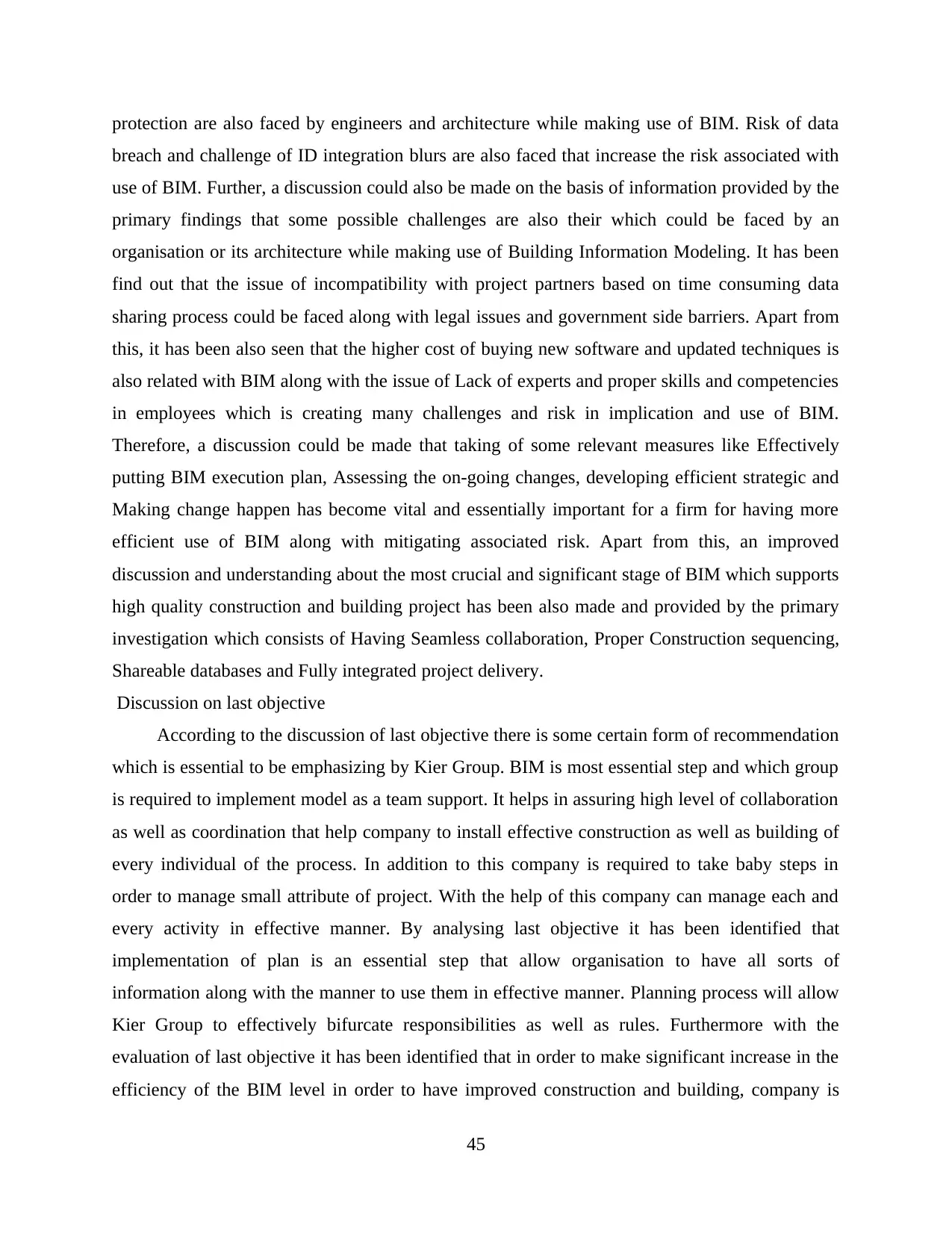
protection are also faced by engineers and architecture while making use of BIM. Risk of data
breach and challenge of ID integration blurs are also faced that increase the risk associated with
use of BIM. Further, a discussion could also be made on the basis of information provided by the
primary findings that some possible challenges are also their which could be faced by an
organisation or its architecture while making use of Building Information Modeling. It has been
find out that the issue of incompatibility with project partners based on time consuming data
sharing process could be faced along with legal issues and government side barriers. Apart from
this, it has been also seen that the higher cost of buying new software and updated techniques is
also related with BIM along with the issue of Lack of experts and proper skills and competencies
in employees which is creating many challenges and risk in implication and use of BIM.
Therefore, a discussion could be made that taking of some relevant measures like Effectively
putting BIM execution plan, Assessing the on-going changes, developing efficient strategic and
Making change happen has become vital and essentially important for a firm for having more
efficient use of BIM along with mitigating associated risk. Apart from this, an improved
discussion and understanding about the most crucial and significant stage of BIM which supports
high quality construction and building project has been also made and provided by the primary
investigation which consists of Having Seamless collaboration, Proper Construction sequencing,
Shareable databases and Fully integrated project delivery.
Discussion on last objective
According to the discussion of last objective there is some certain form of recommendation
which is essential to be emphasizing by Kier Group. BIM is most essential step and which group
is required to implement model as a team support. It helps in assuring high level of collaboration
as well as coordination that help company to install effective construction as well as building of
every individual of the process. In addition to this company is required to take baby steps in
order to manage small attribute of project. With the help of this company can manage each and
every activity in effective manner. By analysing last objective it has been identified that
implementation of plan is an essential step that allow organisation to have all sorts of
information along with the manner to use them in effective manner. Planning process will allow
Kier Group to effectively bifurcate responsibilities as well as rules. Furthermore with the
evaluation of last objective it has been identified that in order to make significant increase in the
efficiency of the BIM level in order to have improved construction and building, company is
45
breach and challenge of ID integration blurs are also faced that increase the risk associated with
use of BIM. Further, a discussion could also be made on the basis of information provided by the
primary findings that some possible challenges are also their which could be faced by an
organisation or its architecture while making use of Building Information Modeling. It has been
find out that the issue of incompatibility with project partners based on time consuming data
sharing process could be faced along with legal issues and government side barriers. Apart from
this, it has been also seen that the higher cost of buying new software and updated techniques is
also related with BIM along with the issue of Lack of experts and proper skills and competencies
in employees which is creating many challenges and risk in implication and use of BIM.
Therefore, a discussion could be made that taking of some relevant measures like Effectively
putting BIM execution plan, Assessing the on-going changes, developing efficient strategic and
Making change happen has become vital and essentially important for a firm for having more
efficient use of BIM along with mitigating associated risk. Apart from this, an improved
discussion and understanding about the most crucial and significant stage of BIM which supports
high quality construction and building project has been also made and provided by the primary
investigation which consists of Having Seamless collaboration, Proper Construction sequencing,
Shareable databases and Fully integrated project delivery.
Discussion on last objective
According to the discussion of last objective there is some certain form of recommendation
which is essential to be emphasizing by Kier Group. BIM is most essential step and which group
is required to implement model as a team support. It helps in assuring high level of collaboration
as well as coordination that help company to install effective construction as well as building of
every individual of the process. In addition to this company is required to take baby steps in
order to manage small attribute of project. With the help of this company can manage each and
every activity in effective manner. By analysing last objective it has been identified that
implementation of plan is an essential step that allow organisation to have all sorts of
information along with the manner to use them in effective manner. Planning process will allow
Kier Group to effectively bifurcate responsibilities as well as rules. Furthermore with the
evaluation of last objective it has been identified that in order to make significant increase in the
efficiency of the BIM level in order to have improved construction and building, company is
45
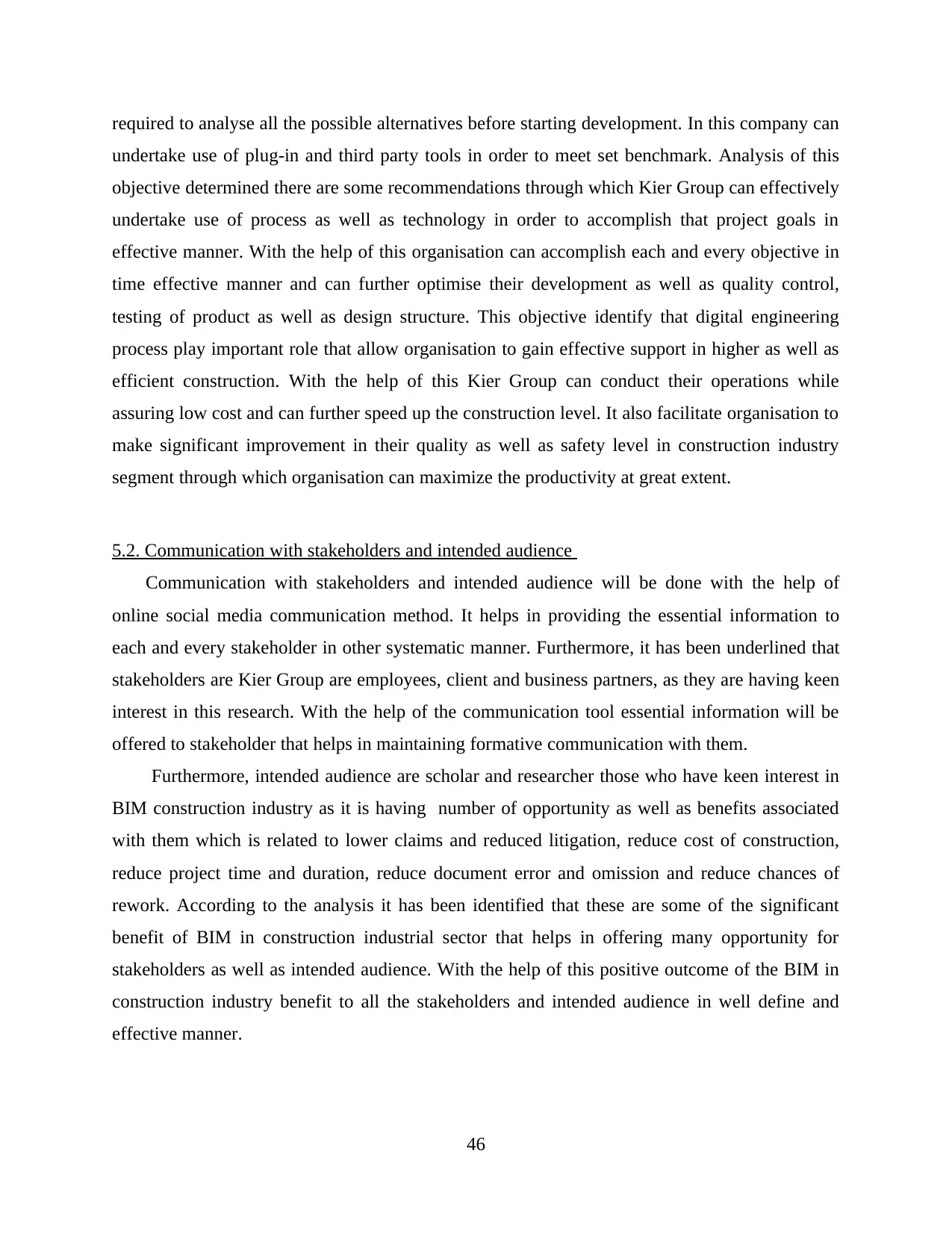
required to analyse all the possible alternatives before starting development. In this company can
undertake use of plug-in and third party tools in order to meet set benchmark. Analysis of this
objective determined there are some recommendations through which Kier Group can effectively
undertake use of process as well as technology in order to accomplish that project goals in
effective manner. With the help of this organisation can accomplish each and every objective in
time effective manner and can further optimise their development as well as quality control,
testing of product as well as design structure. This objective identify that digital engineering
process play important role that allow organisation to gain effective support in higher as well as
efficient construction. With the help of this Kier Group can conduct their operations while
assuring low cost and can further speed up the construction level. It also facilitate organisation to
make significant improvement in their quality as well as safety level in construction industry
segment through which organisation can maximize the productivity at great extent.
5.2. Communication with stakeholders and intended audience
Communication with stakeholders and intended audience will be done with the help of
online social media communication method. It helps in providing the essential information to
each and every stakeholder in other systematic manner. Furthermore, it has been underlined that
stakeholders are Kier Group are employees, client and business partners, as they are having keen
interest in this research. With the help of the communication tool essential information will be
offered to stakeholder that helps in maintaining formative communication with them.
Furthermore, intended audience are scholar and researcher those who have keen interest in
BIM construction industry as it is having number of opportunity as well as benefits associated
with them which is related to lower claims and reduced litigation, reduce cost of construction,
reduce project time and duration, reduce document error and omission and reduce chances of
rework. According to the analysis it has been identified that these are some of the significant
benefit of BIM in construction industrial sector that helps in offering many opportunity for
stakeholders as well as intended audience. With the help of this positive outcome of the BIM in
construction industry benefit to all the stakeholders and intended audience in well define and
effective manner.
46
undertake use of plug-in and third party tools in order to meet set benchmark. Analysis of this
objective determined there are some recommendations through which Kier Group can effectively
undertake use of process as well as technology in order to accomplish that project goals in
effective manner. With the help of this organisation can accomplish each and every objective in
time effective manner and can further optimise their development as well as quality control,
testing of product as well as design structure. This objective identify that digital engineering
process play important role that allow organisation to gain effective support in higher as well as
efficient construction. With the help of this Kier Group can conduct their operations while
assuring low cost and can further speed up the construction level. It also facilitate organisation to
make significant improvement in their quality as well as safety level in construction industry
segment through which organisation can maximize the productivity at great extent.
5.2. Communication with stakeholders and intended audience
Communication with stakeholders and intended audience will be done with the help of
online social media communication method. It helps in providing the essential information to
each and every stakeholder in other systematic manner. Furthermore, it has been underlined that
stakeholders are Kier Group are employees, client and business partners, as they are having keen
interest in this research. With the help of the communication tool essential information will be
offered to stakeholder that helps in maintaining formative communication with them.
Furthermore, intended audience are scholar and researcher those who have keen interest in
BIM construction industry as it is having number of opportunity as well as benefits associated
with them which is related to lower claims and reduced litigation, reduce cost of construction,
reduce project time and duration, reduce document error and omission and reduce chances of
rework. According to the analysis it has been identified that these are some of the significant
benefit of BIM in construction industrial sector that helps in offering many opportunity for
stakeholders as well as intended audience. With the help of this positive outcome of the BIM in
construction industry benefit to all the stakeholders and intended audience in well define and
effective manner.
46
Paraphrase This Document
Need a fresh take? Get an instant paraphrase of this document with our AI Paraphraser
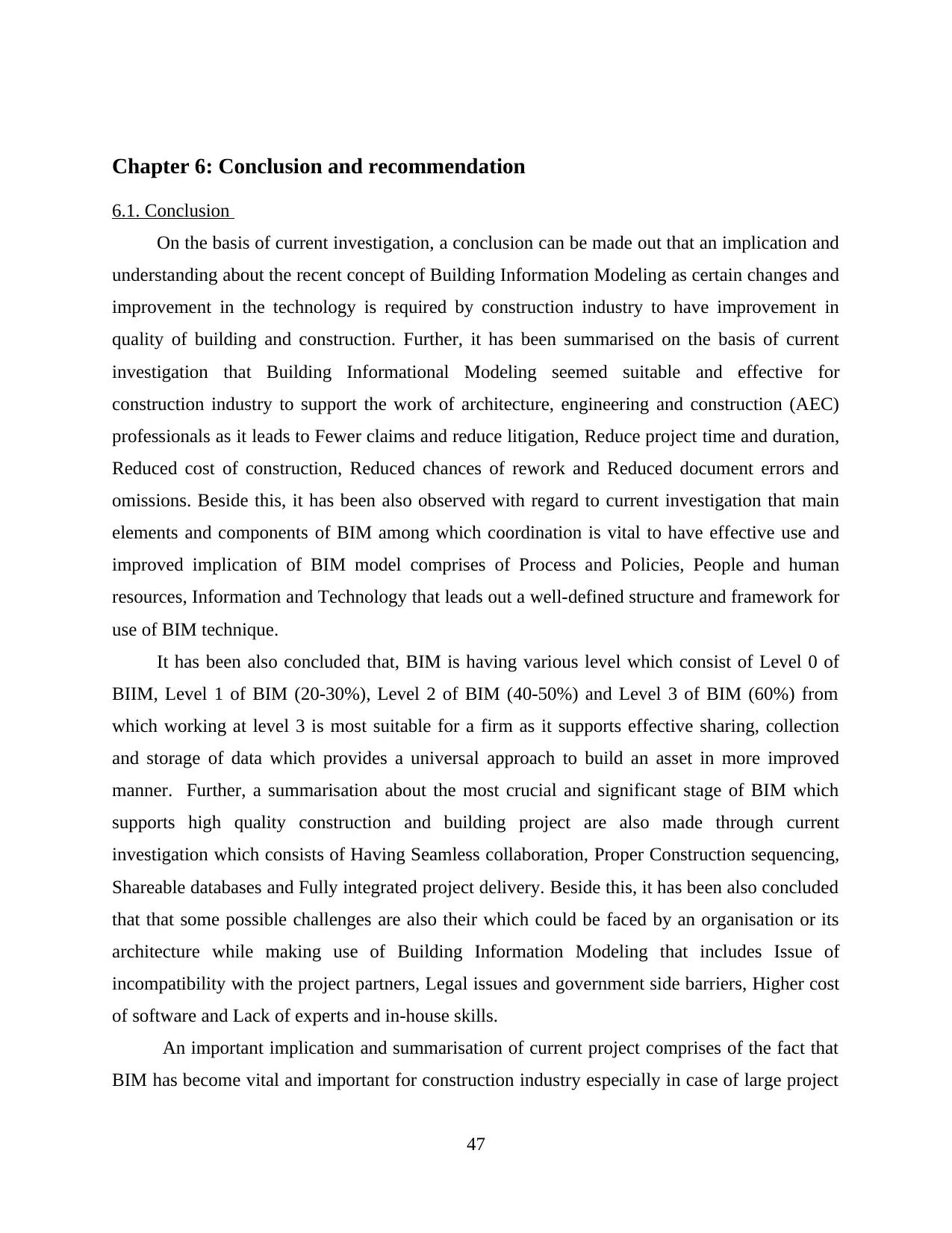
Chapter 6: Conclusion and recommendation
6.1. Conclusion
On the basis of current investigation, a conclusion can be made out that an implication and
understanding about the recent concept of Building Information Modeling as certain changes and
improvement in the technology is required by construction industry to have improvement in
quality of building and construction. Further, it has been summarised on the basis of current
investigation that Building Informational Modeling seemed suitable and effective for
construction industry to support the work of architecture, engineering and construction (AEC)
professionals as it leads to Fewer claims and reduce litigation, Reduce project time and duration,
Reduced cost of construction, Reduced chances of rework and Reduced document errors and
omissions. Beside this, it has been also observed with regard to current investigation that main
elements and components of BIM among which coordination is vital to have effective use and
improved implication of BIM model comprises of Process and Policies, People and human
resources, Information and Technology that leads out a well-defined structure and framework for
use of BIM technique.
It has been also concluded that, BIM is having various level which consist of Level 0 of
BIIM, Level 1 of BIM (20-30%), Level 2 of BIM (40-50%) and Level 3 of BIM (60%) from
which working at level 3 is most suitable for a firm as it supports effective sharing, collection
and storage of data which provides a universal approach to build an asset in more improved
manner. Further, a summarisation about the most crucial and significant stage of BIM which
supports high quality construction and building project are also made through current
investigation which consists of Having Seamless collaboration, Proper Construction sequencing,
Shareable databases and Fully integrated project delivery. Beside this, it has been also concluded
that that some possible challenges are also their which could be faced by an organisation or its
architecture while making use of Building Information Modeling that includes Issue of
incompatibility with the project partners, Legal issues and government side barriers, Higher cost
of software and Lack of experts and in-house skills.
An important implication and summarisation of current project comprises of the fact that
BIM has become vital and important for construction industry especially in case of large project
47
6.1. Conclusion
On the basis of current investigation, a conclusion can be made out that an implication and
understanding about the recent concept of Building Information Modeling as certain changes and
improvement in the technology is required by construction industry to have improvement in
quality of building and construction. Further, it has been summarised on the basis of current
investigation that Building Informational Modeling seemed suitable and effective for
construction industry to support the work of architecture, engineering and construction (AEC)
professionals as it leads to Fewer claims and reduce litigation, Reduce project time and duration,
Reduced cost of construction, Reduced chances of rework and Reduced document errors and
omissions. Beside this, it has been also observed with regard to current investigation that main
elements and components of BIM among which coordination is vital to have effective use and
improved implication of BIM model comprises of Process and Policies, People and human
resources, Information and Technology that leads out a well-defined structure and framework for
use of BIM technique.
It has been also concluded that, BIM is having various level which consist of Level 0 of
BIIM, Level 1 of BIM (20-30%), Level 2 of BIM (40-50%) and Level 3 of BIM (60%) from
which working at level 3 is most suitable for a firm as it supports effective sharing, collection
and storage of data which provides a universal approach to build an asset in more improved
manner. Further, a summarisation about the most crucial and significant stage of BIM which
supports high quality construction and building project are also made through current
investigation which consists of Having Seamless collaboration, Proper Construction sequencing,
Shareable databases and Fully integrated project delivery. Beside this, it has been also concluded
that that some possible challenges are also their which could be faced by an organisation or its
architecture while making use of Building Information Modeling that includes Issue of
incompatibility with the project partners, Legal issues and government side barriers, Higher cost
of software and Lack of experts and in-house skills.
An important implication and summarisation of current project comprises of the fact that
BIM has become vital and important for construction industry especially in case of large project
47
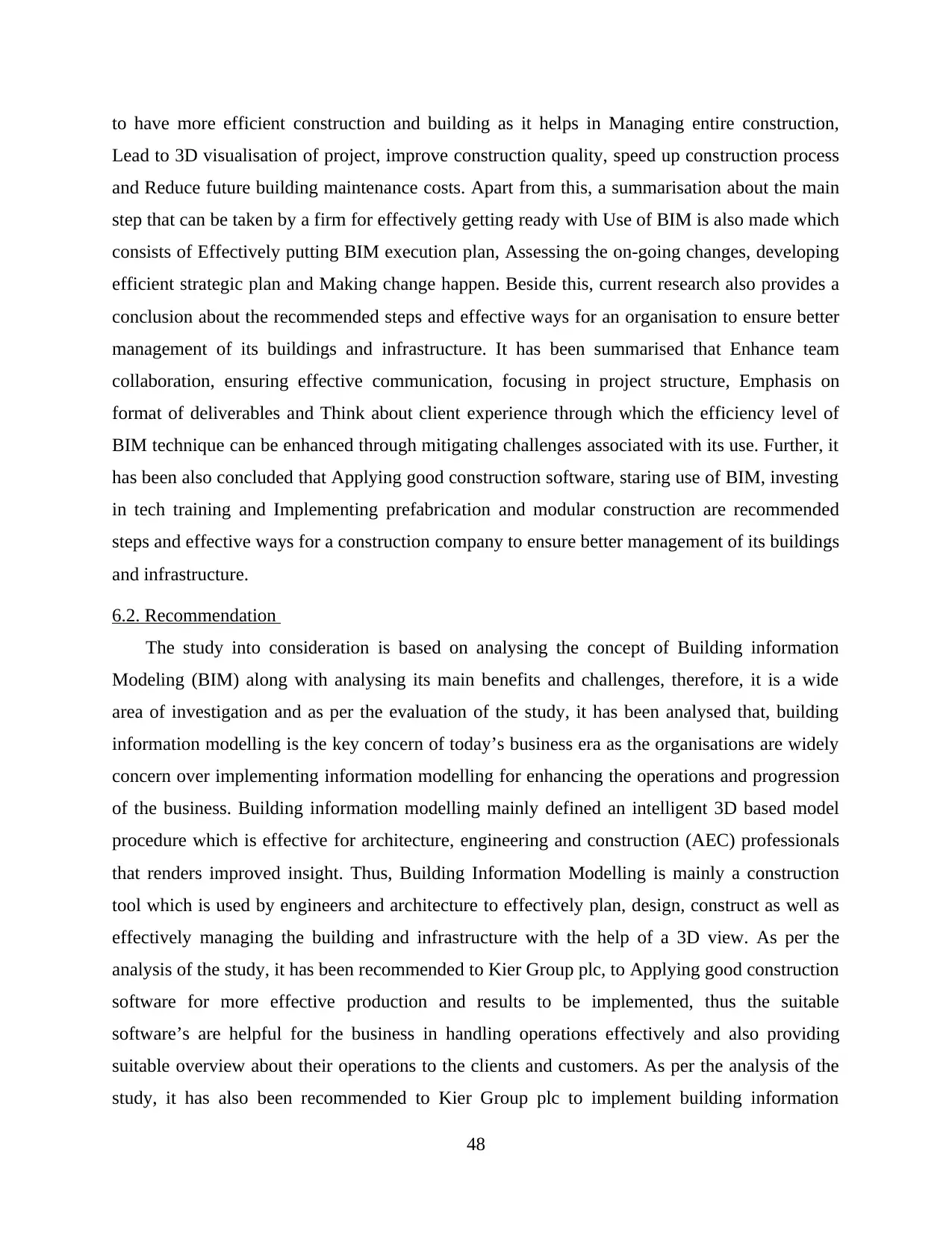
to have more efficient construction and building as it helps in Managing entire construction,
Lead to 3D visualisation of project, improve construction quality, speed up construction process
and Reduce future building maintenance costs. Apart from this, a summarisation about the main
step that can be taken by a firm for effectively getting ready with Use of BIM is also made which
consists of Effectively putting BIM execution plan, Assessing the on-going changes, developing
efficient strategic plan and Making change happen. Beside this, current research also provides a
conclusion about the recommended steps and effective ways for an organisation to ensure better
management of its buildings and infrastructure. It has been summarised that Enhance team
collaboration, ensuring effective communication, focusing in project structure, Emphasis on
format of deliverables and Think about client experience through which the efficiency level of
BIM technique can be enhanced through mitigating challenges associated with its use. Further, it
has been also concluded that Applying good construction software, staring use of BIM, investing
in tech training and Implementing prefabrication and modular construction are recommended
steps and effective ways for a construction company to ensure better management of its buildings
and infrastructure.
6.2. Recommendation
The study into consideration is based on analysing the concept of Building information
Modeling (BIM) along with analysing its main benefits and challenges, therefore, it is a wide
area of investigation and as per the evaluation of the study, it has been analysed that, building
information modelling is the key concern of today’s business era as the organisations are widely
concern over implementing information modelling for enhancing the operations and progression
of the business. Building information modelling mainly defined an intelligent 3D based model
procedure which is effective for architecture, engineering and construction (AEC) professionals
that renders improved insight. Thus, Building Information Modelling is mainly a construction
tool which is used by engineers and architecture to effectively plan, design, construct as well as
effectively managing the building and infrastructure with the help of a 3D view. As per the
analysis of the study, it has been recommended to Kier Group plc, to Applying good construction
software for more effective production and results to be implemented, thus the suitable
software’s are helpful for the business in handling operations effectively and also providing
suitable overview about their operations to the clients and customers. As per the analysis of the
study, it has also been recommended to Kier Group plc to implement building information
48
Lead to 3D visualisation of project, improve construction quality, speed up construction process
and Reduce future building maintenance costs. Apart from this, a summarisation about the main
step that can be taken by a firm for effectively getting ready with Use of BIM is also made which
consists of Effectively putting BIM execution plan, Assessing the on-going changes, developing
efficient strategic plan and Making change happen. Beside this, current research also provides a
conclusion about the recommended steps and effective ways for an organisation to ensure better
management of its buildings and infrastructure. It has been summarised that Enhance team
collaboration, ensuring effective communication, focusing in project structure, Emphasis on
format of deliverables and Think about client experience through which the efficiency level of
BIM technique can be enhanced through mitigating challenges associated with its use. Further, it
has been also concluded that Applying good construction software, staring use of BIM, investing
in tech training and Implementing prefabrication and modular construction are recommended
steps and effective ways for a construction company to ensure better management of its buildings
and infrastructure.
6.2. Recommendation
The study into consideration is based on analysing the concept of Building information
Modeling (BIM) along with analysing its main benefits and challenges, therefore, it is a wide
area of investigation and as per the evaluation of the study, it has been analysed that, building
information modelling is the key concern of today’s business era as the organisations are widely
concern over implementing information modelling for enhancing the operations and progression
of the business. Building information modelling mainly defined an intelligent 3D based model
procedure which is effective for architecture, engineering and construction (AEC) professionals
that renders improved insight. Thus, Building Information Modelling is mainly a construction
tool which is used by engineers and architecture to effectively plan, design, construct as well as
effectively managing the building and infrastructure with the help of a 3D view. As per the
analysis of the study, it has been recommended to Kier Group plc, to Applying good construction
software for more effective production and results to be implemented, thus the suitable
software’s are helpful for the business in handling operations effectively and also providing
suitable overview about their operations to the clients and customers. As per the analysis of the
study, it has also been recommended to Kier Group plc to implement building information
48
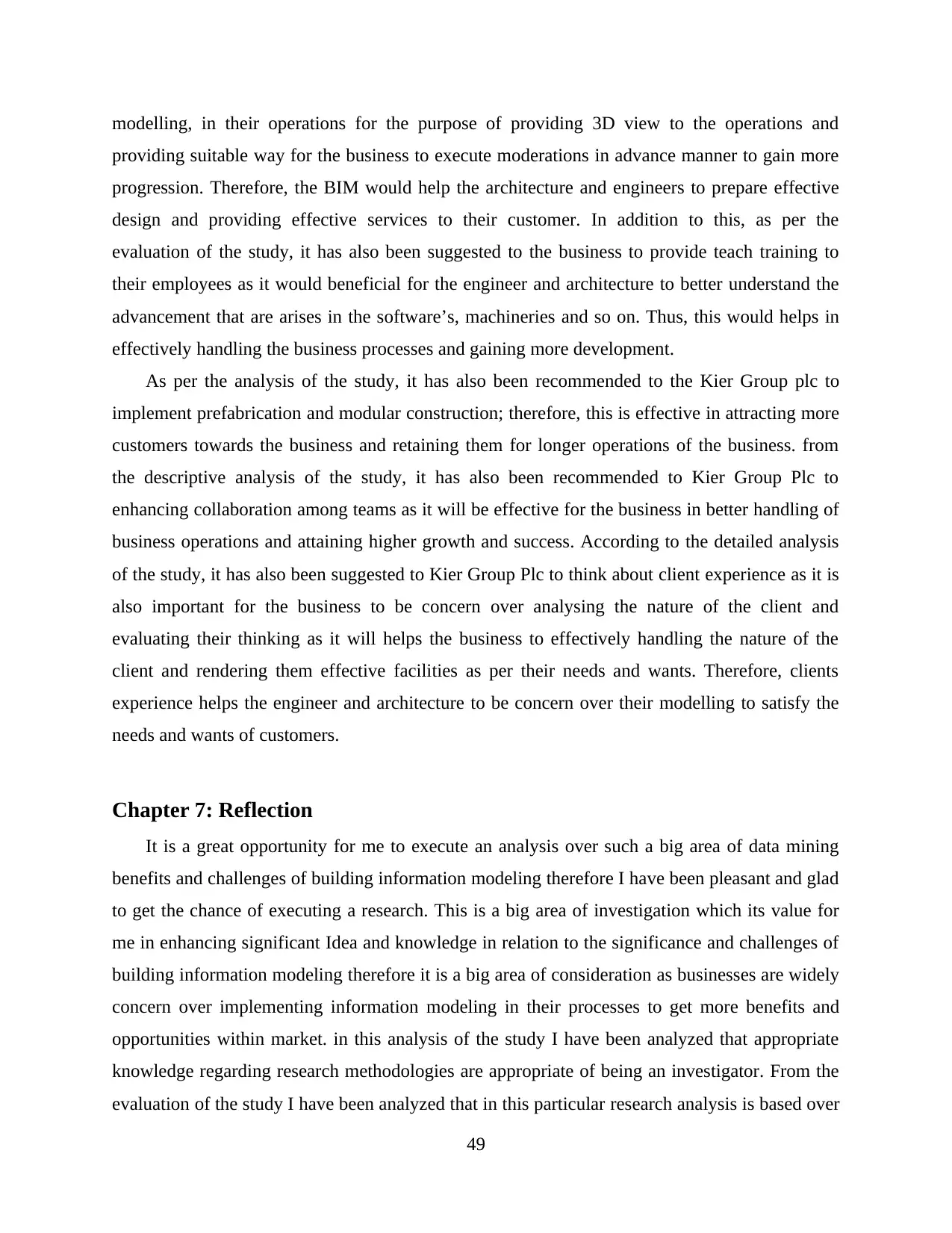
modelling, in their operations for the purpose of providing 3D view to the operations and
providing suitable way for the business to execute moderations in advance manner to gain more
progression. Therefore, the BIM would help the architecture and engineers to prepare effective
design and providing effective services to their customer. In addition to this, as per the
evaluation of the study, it has also been suggested to the business to provide teach training to
their employees as it would beneficial for the engineer and architecture to better understand the
advancement that are arises in the software’s, machineries and so on. Thus, this would helps in
effectively handling the business processes and gaining more development.
As per the analysis of the study, it has also been recommended to the Kier Group plc to
implement prefabrication and modular construction; therefore, this is effective in attracting more
customers towards the business and retaining them for longer operations of the business. from
the descriptive analysis of the study, it has also been recommended to Kier Group Plc to
enhancing collaboration among teams as it will be effective for the business in better handling of
business operations and attaining higher growth and success. According to the detailed analysis
of the study, it has also been suggested to Kier Group Plc to think about client experience as it is
also important for the business to be concern over analysing the nature of the client and
evaluating their thinking as it will helps the business to effectively handling the nature of the
client and rendering them effective facilities as per their needs and wants. Therefore, clients
experience helps the engineer and architecture to be concern over their modelling to satisfy the
needs and wants of customers.
Chapter 7: Reflection
It is a great opportunity for me to execute an analysis over such a big area of data mining
benefits and challenges of building information modeling therefore I have been pleasant and glad
to get the chance of executing a research. This is a big area of investigation which its value for
me in enhancing significant Idea and knowledge in relation to the significance and challenges of
building information modeling therefore it is a big area of consideration as businesses are widely
concern over implementing information modeling in their processes to get more benefits and
opportunities within market. in this analysis of the study I have been analyzed that appropriate
knowledge regarding research methodologies are appropriate of being an investigator. From the
evaluation of the study I have been analyzed that in this particular research analysis is based over
49
providing suitable way for the business to execute moderations in advance manner to gain more
progression. Therefore, the BIM would help the architecture and engineers to prepare effective
design and providing effective services to their customer. In addition to this, as per the
evaluation of the study, it has also been suggested to the business to provide teach training to
their employees as it would beneficial for the engineer and architecture to better understand the
advancement that are arises in the software’s, machineries and so on. Thus, this would helps in
effectively handling the business processes and gaining more development.
As per the analysis of the study, it has also been recommended to the Kier Group plc to
implement prefabrication and modular construction; therefore, this is effective in attracting more
customers towards the business and retaining them for longer operations of the business. from
the descriptive analysis of the study, it has also been recommended to Kier Group Plc to
enhancing collaboration among teams as it will be effective for the business in better handling of
business operations and attaining higher growth and success. According to the detailed analysis
of the study, it has also been suggested to Kier Group Plc to think about client experience as it is
also important for the business to be concern over analysing the nature of the client and
evaluating their thinking as it will helps the business to effectively handling the nature of the
client and rendering them effective facilities as per their needs and wants. Therefore, clients
experience helps the engineer and architecture to be concern over their modelling to satisfy the
needs and wants of customers.
Chapter 7: Reflection
It is a great opportunity for me to execute an analysis over such a big area of data mining
benefits and challenges of building information modeling therefore I have been pleasant and glad
to get the chance of executing a research. This is a big area of investigation which its value for
me in enhancing significant Idea and knowledge in relation to the significance and challenges of
building information modeling therefore it is a big area of consideration as businesses are widely
concern over implementing information modeling in their processes to get more benefits and
opportunities within market. in this analysis of the study I have been analyzed that appropriate
knowledge regarding research methodologies are appropriate of being an investigator. From the
evaluation of the study I have been analyzed that in this particular research analysis is based over
49
Secure Best Marks with AI Grader
Need help grading? Try our AI Grader for instant feedback on your assignments.
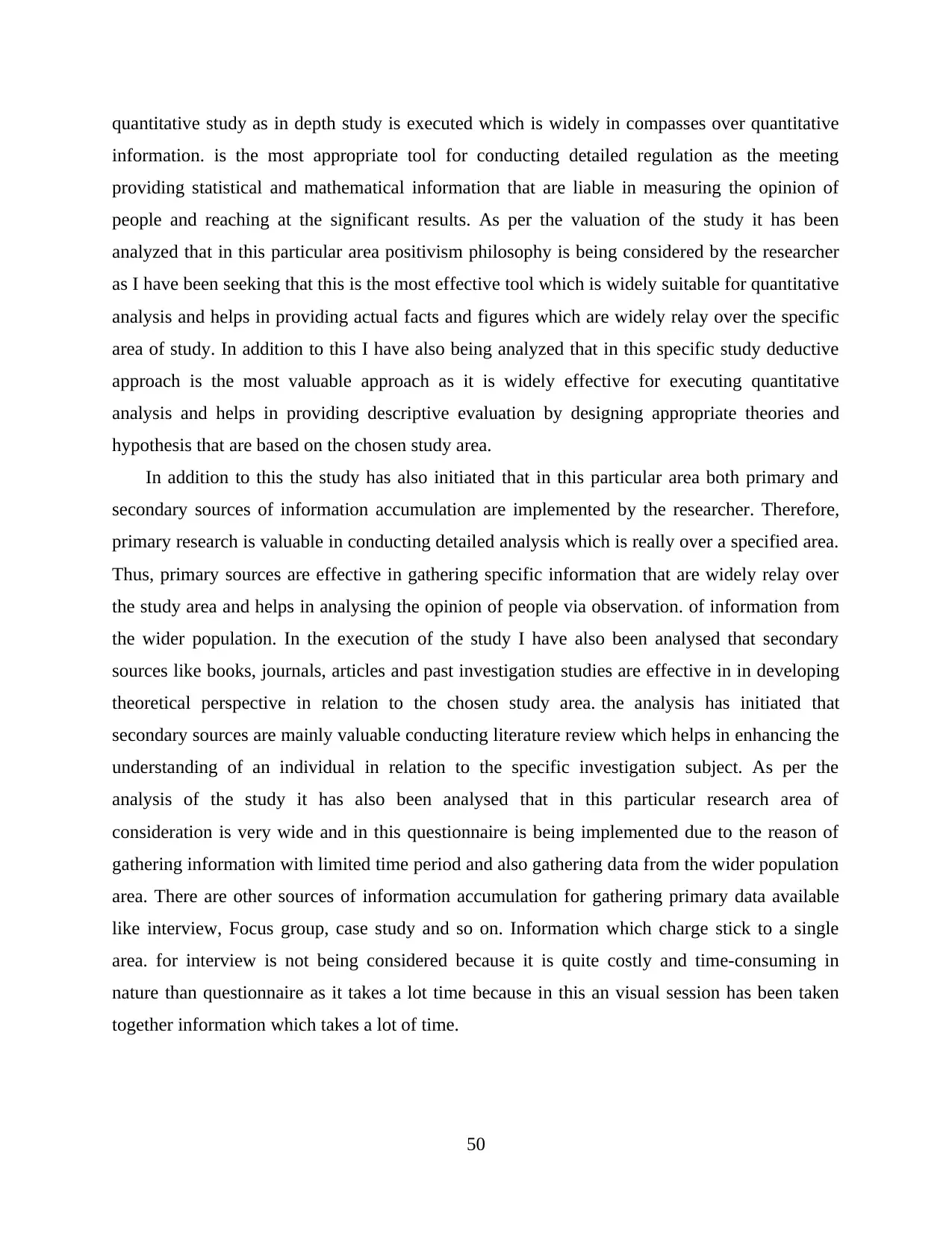
quantitative study as in depth study is executed which is widely in compasses over quantitative
information. is the most appropriate tool for conducting detailed regulation as the meeting
providing statistical and mathematical information that are liable in measuring the opinion of
people and reaching at the significant results. As per the valuation of the study it has been
analyzed that in this particular area positivism philosophy is being considered by the researcher
as I have been seeking that this is the most effective tool which is widely suitable for quantitative
analysis and helps in providing actual facts and figures which are widely relay over the specific
area of study. In addition to this I have also being analyzed that in this specific study deductive
approach is the most valuable approach as it is widely effective for executing quantitative
analysis and helps in providing descriptive evaluation by designing appropriate theories and
hypothesis that are based on the chosen study area.
In addition to this the study has also initiated that in this particular area both primary and
secondary sources of information accumulation are implemented by the researcher. Therefore,
primary research is valuable in conducting detailed analysis which is really over a specified area.
Thus, primary sources are effective in gathering specific information that are widely relay over
the study area and helps in analysing the opinion of people via observation. of information from
the wider population. In the execution of the study I have also been analysed that secondary
sources like books, journals, articles and past investigation studies are effective in in developing
theoretical perspective in relation to the chosen study area. the analysis has initiated that
secondary sources are mainly valuable conducting literature review which helps in enhancing the
understanding of an individual in relation to the specific investigation subject. As per the
analysis of the study it has also been analysed that in this particular research area of
consideration is very wide and in this questionnaire is being implemented due to the reason of
gathering information with limited time period and also gathering data from the wider population
area. There are other sources of information accumulation for gathering primary data available
like interview, Focus group, case study and so on. Information which charge stick to a single
area. for interview is not being considered because it is quite costly and time-consuming in
nature than questionnaire as it takes a lot time because in this an visual session has been taken
together information which takes a lot of time.
50
information. is the most appropriate tool for conducting detailed regulation as the meeting
providing statistical and mathematical information that are liable in measuring the opinion of
people and reaching at the significant results. As per the valuation of the study it has been
analyzed that in this particular area positivism philosophy is being considered by the researcher
as I have been seeking that this is the most effective tool which is widely suitable for quantitative
analysis and helps in providing actual facts and figures which are widely relay over the specific
area of study. In addition to this I have also being analyzed that in this specific study deductive
approach is the most valuable approach as it is widely effective for executing quantitative
analysis and helps in providing descriptive evaluation by designing appropriate theories and
hypothesis that are based on the chosen study area.
In addition to this the study has also initiated that in this particular area both primary and
secondary sources of information accumulation are implemented by the researcher. Therefore,
primary research is valuable in conducting detailed analysis which is really over a specified area.
Thus, primary sources are effective in gathering specific information that are widely relay over
the study area and helps in analysing the opinion of people via observation. of information from
the wider population. In the execution of the study I have also been analysed that secondary
sources like books, journals, articles and past investigation studies are effective in in developing
theoretical perspective in relation to the chosen study area. the analysis has initiated that
secondary sources are mainly valuable conducting literature review which helps in enhancing the
understanding of an individual in relation to the specific investigation subject. As per the
analysis of the study it has also been analysed that in this particular research area of
consideration is very wide and in this questionnaire is being implemented due to the reason of
gathering information with limited time period and also gathering data from the wider population
area. There are other sources of information accumulation for gathering primary data available
like interview, Focus group, case study and so on. Information which charge stick to a single
area. for interview is not being considered because it is quite costly and time-consuming in
nature than questionnaire as it takes a lot time because in this an visual session has been taken
together information which takes a lot of time.
50
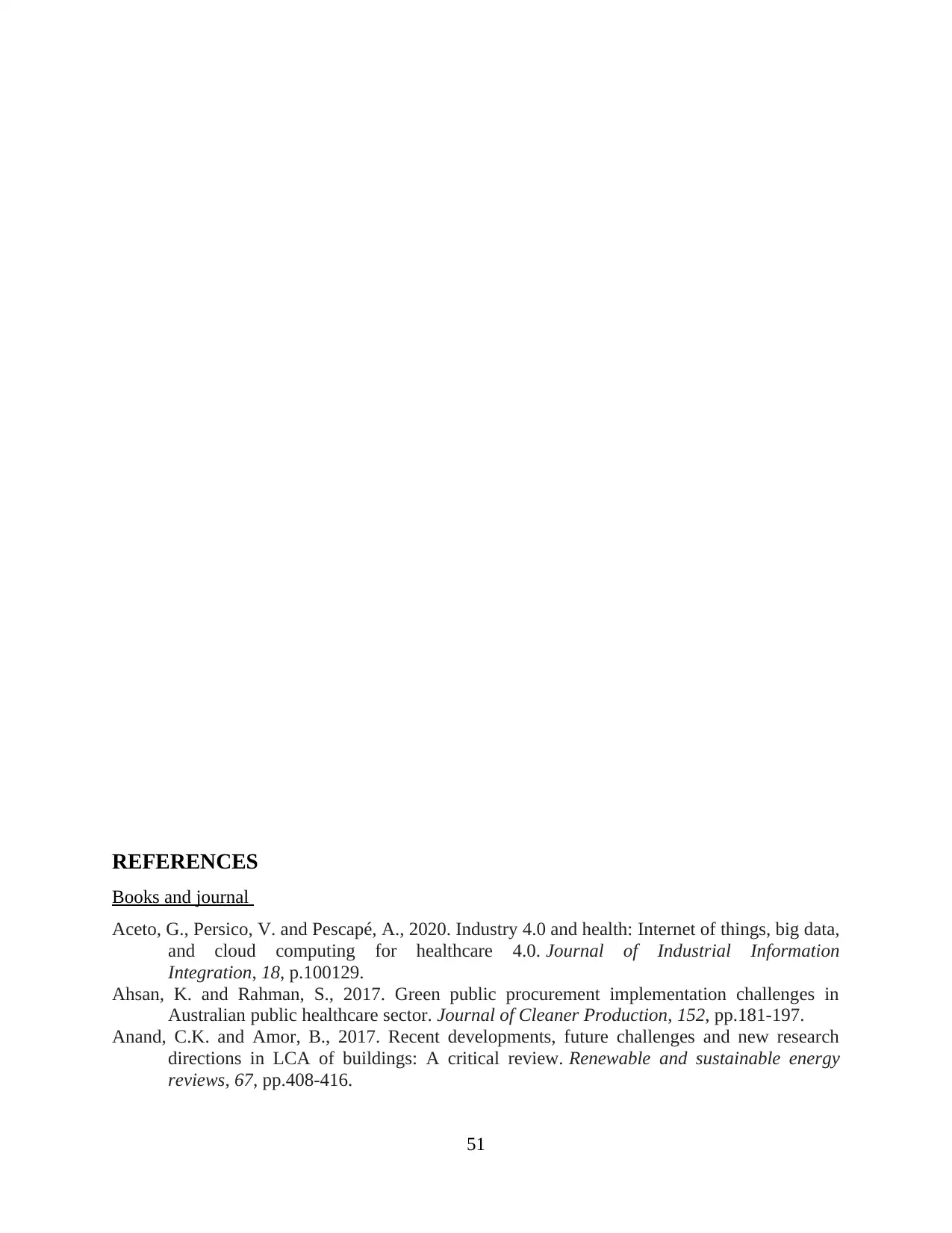
REFERENCES
Books and journal
Aceto, G., Persico, V. and Pescapé, A., 2020. Industry 4.0 and health: Internet of things, big data,
and cloud computing for healthcare 4.0. Journal of Industrial Information
Integration, 18, p.100129.
Ahsan, K. and Rahman, S., 2017. Green public procurement implementation challenges in
Australian public healthcare sector. Journal of Cleaner Production, 152, pp.181-197.
Anand, C.K. and Amor, B., 2017. Recent developments, future challenges and new research
directions in LCA of buildings: A critical review. Renewable and sustainable energy
reviews, 67, pp.408-416.
51
Books and journal
Aceto, G., Persico, V. and Pescapé, A., 2020. Industry 4.0 and health: Internet of things, big data,
and cloud computing for healthcare 4.0. Journal of Industrial Information
Integration, 18, p.100129.
Ahsan, K. and Rahman, S., 2017. Green public procurement implementation challenges in
Australian public healthcare sector. Journal of Cleaner Production, 152, pp.181-197.
Anand, C.K. and Amor, B., 2017. Recent developments, future challenges and new research
directions in LCA of buildings: A critical review. Renewable and sustainable energy
reviews, 67, pp.408-416.
51
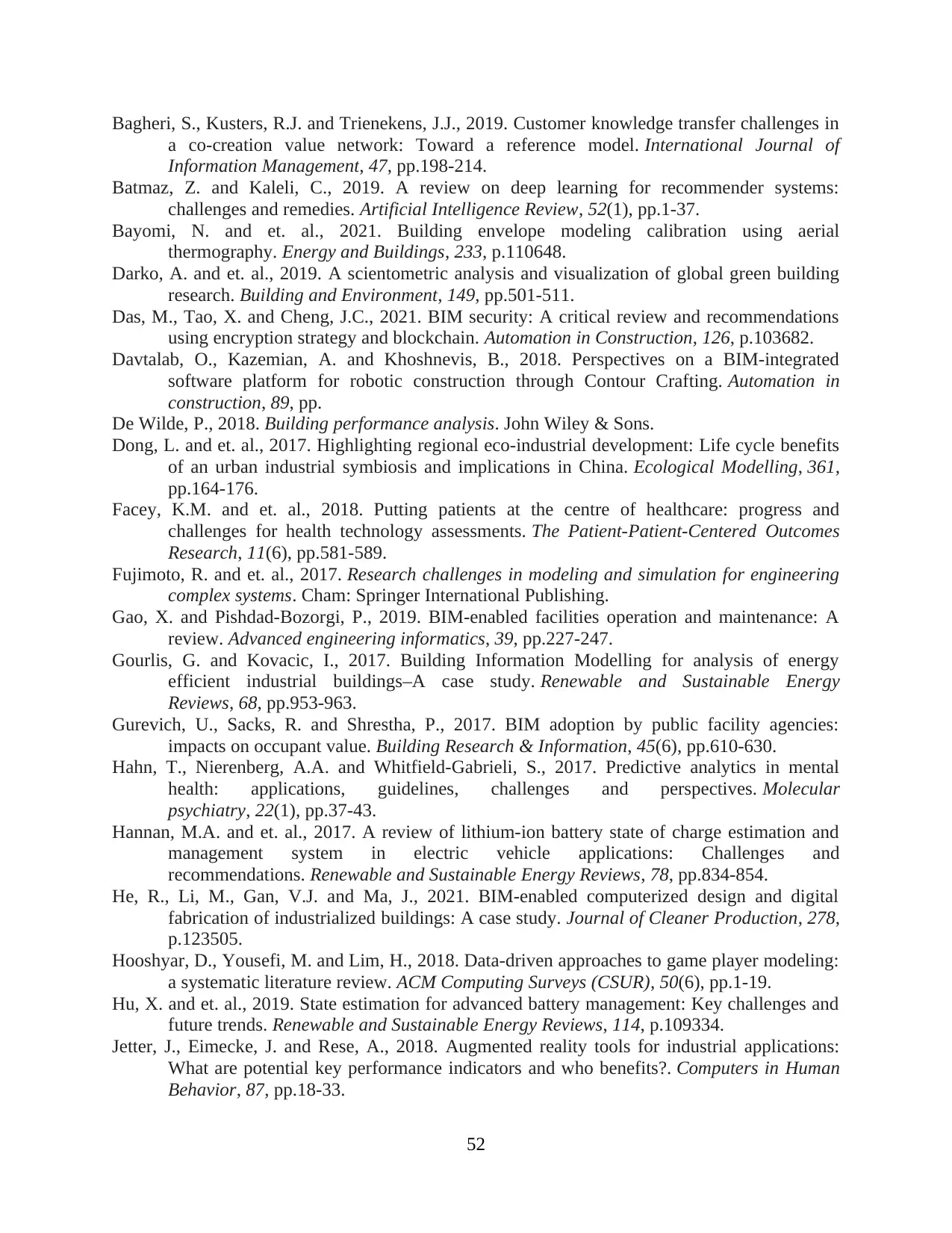
Bagheri, S., Kusters, R.J. and Trienekens, J.J., 2019. Customer knowledge transfer challenges in
a co-creation value network: Toward a reference model. International Journal of
Information Management, 47, pp.198-214.
Batmaz, Z. and Kaleli, C., 2019. A review on deep learning for recommender systems:
challenges and remedies. Artificial Intelligence Review, 52(1), pp.1-37.
Bayomi, N. and et. al., 2021. Building envelope modeling calibration using aerial
thermography. Energy and Buildings, 233, p.110648.
Darko, A. and et. al., 2019. A scientometric analysis and visualization of global green building
research. Building and Environment, 149, pp.501-511.
Das, M., Tao, X. and Cheng, J.C., 2021. BIM security: A critical review and recommendations
using encryption strategy and blockchain. Automation in Construction, 126, p.103682.
Davtalab, O., Kazemian, A. and Khoshnevis, B., 2018. Perspectives on a BIM-integrated
software platform for robotic construction through Contour Crafting. Automation in
construction, 89, pp.
De Wilde, P., 2018. Building performance analysis. John Wiley & Sons.
Dong, L. and et. al., 2017. Highlighting regional eco-industrial development: Life cycle benefits
of an urban industrial symbiosis and implications in China. Ecological Modelling, 361,
pp.164-176.
Facey, K.M. and et. al., 2018. Putting patients at the centre of healthcare: progress and
challenges for health technology assessments. The Patient-Patient-Centered Outcomes
Research, 11(6), pp.581-589.
Fujimoto, R. and et. al., 2017. Research challenges in modeling and simulation for engineering
complex systems. Cham: Springer International Publishing.
Gao, X. and Pishdad-Bozorgi, P., 2019. BIM-enabled facilities operation and maintenance: A
review. Advanced engineering informatics, 39, pp.227-247.
Gourlis, G. and Kovacic, I., 2017. Building Information Modelling for analysis of energy
efficient industrial buildings–A case study. Renewable and Sustainable Energy
Reviews, 68, pp.953-963.
Gurevich, U., Sacks, R. and Shrestha, P., 2017. BIM adoption by public facility agencies:
impacts on occupant value. Building Research & Information, 45(6), pp.610-630.
Hahn, T., Nierenberg, A.A. and Whitfield-Gabrieli, S., 2017. Predictive analytics in mental
health: applications, guidelines, challenges and perspectives. Molecular
psychiatry, 22(1), pp.37-43.
Hannan, M.A. and et. al., 2017. A review of lithium-ion battery state of charge estimation and
management system in electric vehicle applications: Challenges and
recommendations. Renewable and Sustainable Energy Reviews, 78, pp.834-854.
He, R., Li, M., Gan, V.J. and Ma, J., 2021. BIM-enabled computerized design and digital
fabrication of industrialized buildings: A case study. Journal of Cleaner Production, 278,
p.123505.
Hooshyar, D., Yousefi, M. and Lim, H., 2018. Data-driven approaches to game player modeling:
a systematic literature review. ACM Computing Surveys (CSUR), 50(6), pp.1-19.
Hu, X. and et. al., 2019. State estimation for advanced battery management: Key challenges and
future trends. Renewable and Sustainable Energy Reviews, 114, p.109334.
Jetter, J., Eimecke, J. and Rese, A., 2018. Augmented reality tools for industrial applications:
What are potential key performance indicators and who benefits?. Computers in Human
Behavior, 87, pp.18-33.
52
a co-creation value network: Toward a reference model. International Journal of
Information Management, 47, pp.198-214.
Batmaz, Z. and Kaleli, C., 2019. A review on deep learning for recommender systems:
challenges and remedies. Artificial Intelligence Review, 52(1), pp.1-37.
Bayomi, N. and et. al., 2021. Building envelope modeling calibration using aerial
thermography. Energy and Buildings, 233, p.110648.
Darko, A. and et. al., 2019. A scientometric analysis and visualization of global green building
research. Building and Environment, 149, pp.501-511.
Das, M., Tao, X. and Cheng, J.C., 2021. BIM security: A critical review and recommendations
using encryption strategy and blockchain. Automation in Construction, 126, p.103682.
Davtalab, O., Kazemian, A. and Khoshnevis, B., 2018. Perspectives on a BIM-integrated
software platform for robotic construction through Contour Crafting. Automation in
construction, 89, pp.
De Wilde, P., 2018. Building performance analysis. John Wiley & Sons.
Dong, L. and et. al., 2017. Highlighting regional eco-industrial development: Life cycle benefits
of an urban industrial symbiosis and implications in China. Ecological Modelling, 361,
pp.164-176.
Facey, K.M. and et. al., 2018. Putting patients at the centre of healthcare: progress and
challenges for health technology assessments. The Patient-Patient-Centered Outcomes
Research, 11(6), pp.581-589.
Fujimoto, R. and et. al., 2017. Research challenges in modeling and simulation for engineering
complex systems. Cham: Springer International Publishing.
Gao, X. and Pishdad-Bozorgi, P., 2019. BIM-enabled facilities operation and maintenance: A
review. Advanced engineering informatics, 39, pp.227-247.
Gourlis, G. and Kovacic, I., 2017. Building Information Modelling for analysis of energy
efficient industrial buildings–A case study. Renewable and Sustainable Energy
Reviews, 68, pp.953-963.
Gurevich, U., Sacks, R. and Shrestha, P., 2017. BIM adoption by public facility agencies:
impacts on occupant value. Building Research & Information, 45(6), pp.610-630.
Hahn, T., Nierenberg, A.A. and Whitfield-Gabrieli, S., 2017. Predictive analytics in mental
health: applications, guidelines, challenges and perspectives. Molecular
psychiatry, 22(1), pp.37-43.
Hannan, M.A. and et. al., 2017. A review of lithium-ion battery state of charge estimation and
management system in electric vehicle applications: Challenges and
recommendations. Renewable and Sustainable Energy Reviews, 78, pp.834-854.
He, R., Li, M., Gan, V.J. and Ma, J., 2021. BIM-enabled computerized design and digital
fabrication of industrialized buildings: A case study. Journal of Cleaner Production, 278,
p.123505.
Hooshyar, D., Yousefi, M. and Lim, H., 2018. Data-driven approaches to game player modeling:
a systematic literature review. ACM Computing Surveys (CSUR), 50(6), pp.1-19.
Hu, X. and et. al., 2019. State estimation for advanced battery management: Key challenges and
future trends. Renewable and Sustainable Energy Reviews, 114, p.109334.
Jetter, J., Eimecke, J. and Rese, A., 2018. Augmented reality tools for industrial applications:
What are potential key performance indicators and who benefits?. Computers in Human
Behavior, 87, pp.18-33.
52
Paraphrase This Document
Need a fresh take? Get an instant paraphrase of this document with our AI Paraphraser
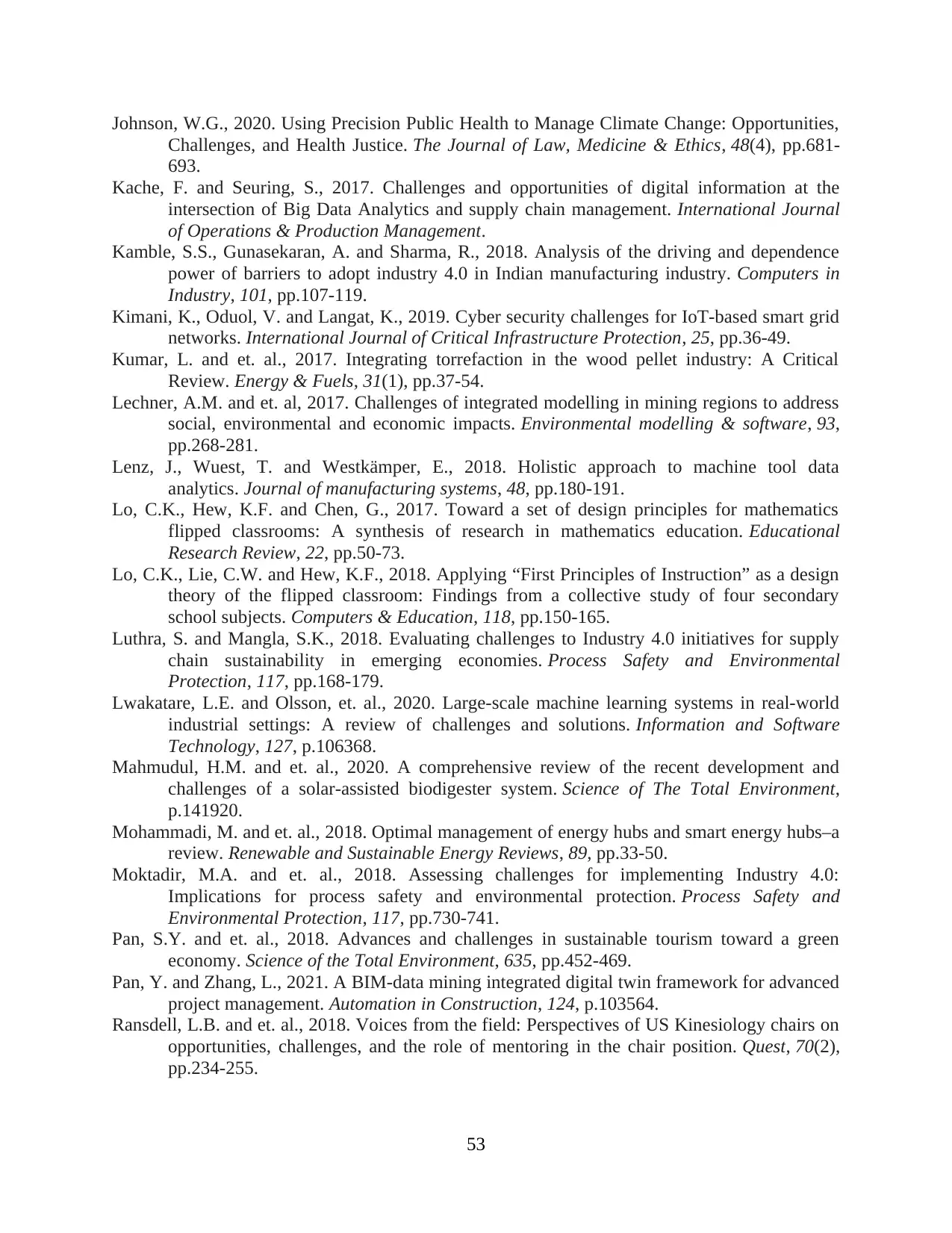
Johnson, W.G., 2020. Using Precision Public Health to Manage Climate Change: Opportunities,
Challenges, and Health Justice. The Journal of Law, Medicine & Ethics, 48(4), pp.681-
693.
Kache, F. and Seuring, S., 2017. Challenges and opportunities of digital information at the
intersection of Big Data Analytics and supply chain management. International Journal
of Operations & Production Management.
Kamble, S.S., Gunasekaran, A. and Sharma, R., 2018. Analysis of the driving and dependence
power of barriers to adopt industry 4.0 in Indian manufacturing industry. Computers in
Industry, 101, pp.107-119.
Kimani, K., Oduol, V. and Langat, K., 2019. Cyber security challenges for IoT-based smart grid
networks. International Journal of Critical Infrastructure Protection, 25, pp.36-49.
Kumar, L. and et. al., 2017. Integrating torrefaction in the wood pellet industry: A Critical
Review. Energy & Fuels, 31(1), pp.37-54.
Lechner, A.M. and et. al, 2017. Challenges of integrated modelling in mining regions to address
social, environmental and economic impacts. Environmental modelling & software, 93,
pp.268-281.
Lenz, J., Wuest, T. and Westkämper, E., 2018. Holistic approach to machine tool data
analytics. Journal of manufacturing systems, 48, pp.180-191.
Lo, C.K., Hew, K.F. and Chen, G., 2017. Toward a set of design principles for mathematics
flipped classrooms: A synthesis of research in mathematics education. Educational
Research Review, 22, pp.50-73.
Lo, C.K., Lie, C.W. and Hew, K.F., 2018. Applying “First Principles of Instruction” as a design
theory of the flipped classroom: Findings from a collective study of four secondary
school subjects. Computers & Education, 118, pp.150-165.
Luthra, S. and Mangla, S.K., 2018. Evaluating challenges to Industry 4.0 initiatives for supply
chain sustainability in emerging economies. Process Safety and Environmental
Protection, 117, pp.168-179.
Lwakatare, L.E. and Olsson, et. al., 2020. Large-scale machine learning systems in real-world
industrial settings: A review of challenges and solutions. Information and Software
Technology, 127, p.106368.
Mahmudul, H.M. and et. al., 2020. A comprehensive review of the recent development and
challenges of a solar-assisted biodigester system. Science of The Total Environment,
p.141920.
Mohammadi, M. and et. al., 2018. Optimal management of energy hubs and smart energy hubs–a
review. Renewable and Sustainable Energy Reviews, 89, pp.33-50.
Moktadir, M.A. and et. al., 2018. Assessing challenges for implementing Industry 4.0:
Implications for process safety and environmental protection. Process Safety and
Environmental Protection, 117, pp.730-741.
Pan, S.Y. and et. al., 2018. Advances and challenges in sustainable tourism toward a green
economy. Science of the Total Environment, 635, pp.452-469.
Pan, Y. and Zhang, L., 2021. A BIM-data mining integrated digital twin framework for advanced
project management. Automation in Construction, 124, p.103564.
Ransdell, L.B. and et. al., 2018. Voices from the field: Perspectives of US Kinesiology chairs on
opportunities, challenges, and the role of mentoring in the chair position. Quest, 70(2),
pp.234-255.
53
Challenges, and Health Justice. The Journal of Law, Medicine & Ethics, 48(4), pp.681-
693.
Kache, F. and Seuring, S., 2017. Challenges and opportunities of digital information at the
intersection of Big Data Analytics and supply chain management. International Journal
of Operations & Production Management.
Kamble, S.S., Gunasekaran, A. and Sharma, R., 2018. Analysis of the driving and dependence
power of barriers to adopt industry 4.0 in Indian manufacturing industry. Computers in
Industry, 101, pp.107-119.
Kimani, K., Oduol, V. and Langat, K., 2019. Cyber security challenges for IoT-based smart grid
networks. International Journal of Critical Infrastructure Protection, 25, pp.36-49.
Kumar, L. and et. al., 2017. Integrating torrefaction in the wood pellet industry: A Critical
Review. Energy & Fuels, 31(1), pp.37-54.
Lechner, A.M. and et. al, 2017. Challenges of integrated modelling in mining regions to address
social, environmental and economic impacts. Environmental modelling & software, 93,
pp.268-281.
Lenz, J., Wuest, T. and Westkämper, E., 2018. Holistic approach to machine tool data
analytics. Journal of manufacturing systems, 48, pp.180-191.
Lo, C.K., Hew, K.F. and Chen, G., 2017. Toward a set of design principles for mathematics
flipped classrooms: A synthesis of research in mathematics education. Educational
Research Review, 22, pp.50-73.
Lo, C.K., Lie, C.W. and Hew, K.F., 2018. Applying “First Principles of Instruction” as a design
theory of the flipped classroom: Findings from a collective study of four secondary
school subjects. Computers & Education, 118, pp.150-165.
Luthra, S. and Mangla, S.K., 2018. Evaluating challenges to Industry 4.0 initiatives for supply
chain sustainability in emerging economies. Process Safety and Environmental
Protection, 117, pp.168-179.
Lwakatare, L.E. and Olsson, et. al., 2020. Large-scale machine learning systems in real-world
industrial settings: A review of challenges and solutions. Information and Software
Technology, 127, p.106368.
Mahmudul, H.M. and et. al., 2020. A comprehensive review of the recent development and
challenges of a solar-assisted biodigester system. Science of The Total Environment,
p.141920.
Mohammadi, M. and et. al., 2018. Optimal management of energy hubs and smart energy hubs–a
review. Renewable and Sustainable Energy Reviews, 89, pp.33-50.
Moktadir, M.A. and et. al., 2018. Assessing challenges for implementing Industry 4.0:
Implications for process safety and environmental protection. Process Safety and
Environmental Protection, 117, pp.730-741.
Pan, S.Y. and et. al., 2018. Advances and challenges in sustainable tourism toward a green
economy. Science of the Total Environment, 635, pp.452-469.
Pan, Y. and Zhang, L., 2021. A BIM-data mining integrated digital twin framework for advanced
project management. Automation in Construction, 124, p.103564.
Ransdell, L.B. and et. al., 2018. Voices from the field: Perspectives of US Kinesiology chairs on
opportunities, challenges, and the role of mentoring in the chair position. Quest, 70(2),
pp.234-255.
53
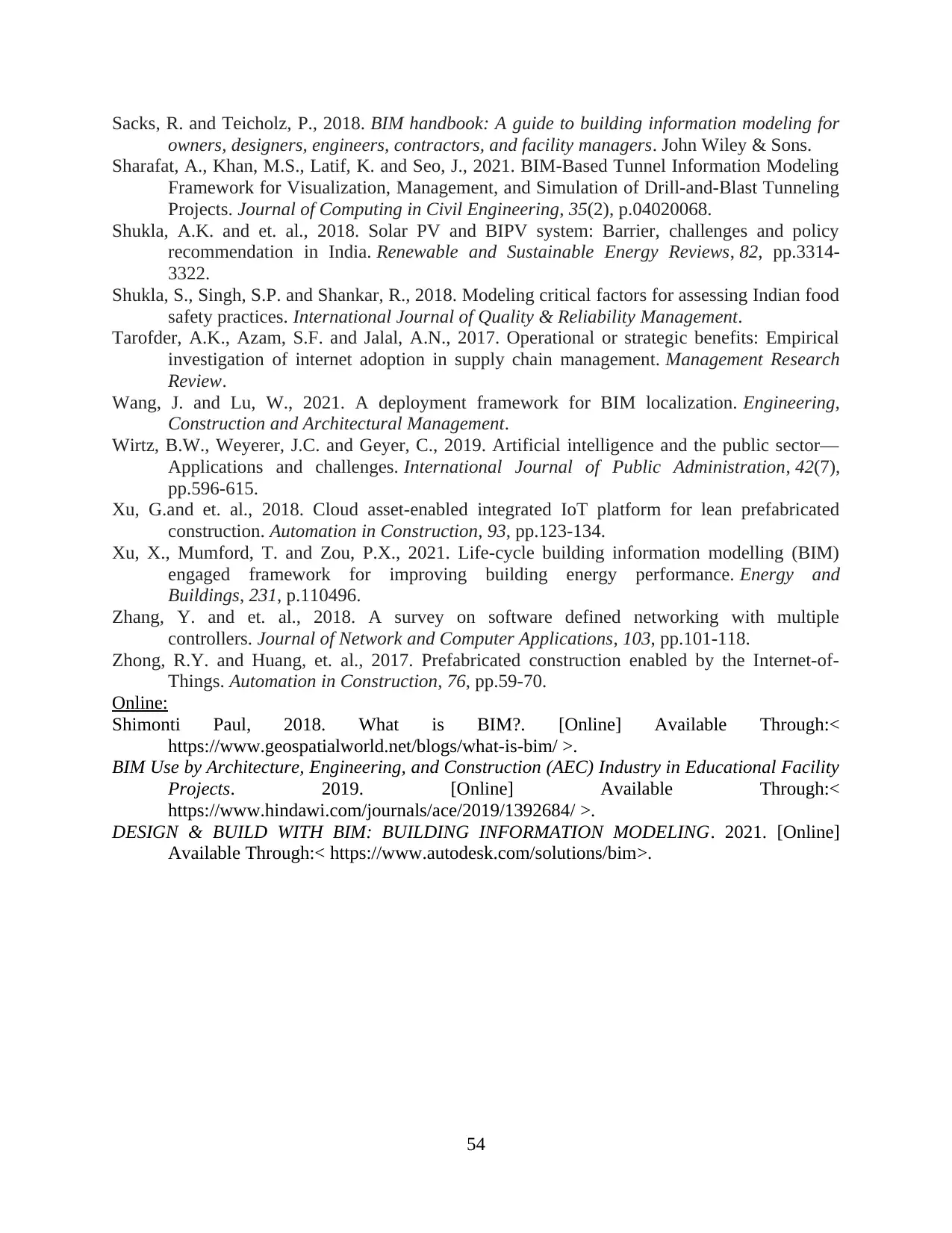
Sacks, R. and Teicholz, P., 2018. BIM handbook: A guide to building information modeling for
owners, designers, engineers, contractors, and facility managers. John Wiley & Sons.
Sharafat, A., Khan, M.S., Latif, K. and Seo, J., 2021. BIM-Based Tunnel Information Modeling
Framework for Visualization, Management, and Simulation of Drill-and-Blast Tunneling
Projects. Journal of Computing in Civil Engineering, 35(2), p.04020068.
Shukla, A.K. and et. al., 2018. Solar PV and BIPV system: Barrier, challenges and policy
recommendation in India. Renewable and Sustainable Energy Reviews, 82, pp.3314-
3322.
Shukla, S., Singh, S.P. and Shankar, R., 2018. Modeling critical factors for assessing Indian food
safety practices. International Journal of Quality & Reliability Management.
Tarofder, A.K., Azam, S.F. and Jalal, A.N., 2017. Operational or strategic benefits: Empirical
investigation of internet adoption in supply chain management. Management Research
Review.
Wang, J. and Lu, W., 2021. A deployment framework for BIM localization. Engineering,
Construction and Architectural Management.
Wirtz, B.W., Weyerer, J.C. and Geyer, C., 2019. Artificial intelligence and the public sector—
Applications and challenges. International Journal of Public Administration, 42(7),
pp.596-615.
Xu, G.and et. al., 2018. Cloud asset-enabled integrated IoT platform for lean prefabricated
construction. Automation in Construction, 93, pp.123-134.
Xu, X., Mumford, T. and Zou, P.X., 2021. Life-cycle building information modelling (BIM)
engaged framework for improving building energy performance. Energy and
Buildings, 231, p.110496.
Zhang, Y. and et. al., 2018. A survey on software defined networking with multiple
controllers. Journal of Network and Computer Applications, 103, pp.101-118.
Zhong, R.Y. and Huang, et. al., 2017. Prefabricated construction enabled by the Internet-of-
Things. Automation in Construction, 76, pp.59-70.
Online:
Shimonti Paul, 2018. What is BIM?. [Online] Available Through:<
https://www.geospatialworld.net/blogs/what-is-bim/ >.
BIM Use by Architecture, Engineering, and Construction (AEC) Industry in Educational Facility
Projects. 2019. [Online] Available Through:<
https://www.hindawi.com/journals/ace/2019/1392684/ >.
DESIGN & BUILD WITH BIM: BUILDING INFORMATION MODELING. 2021. [Online]
Available Through:< https://www.autodesk.com/solutions/bim>.
54
owners, designers, engineers, contractors, and facility managers. John Wiley & Sons.
Sharafat, A., Khan, M.S., Latif, K. and Seo, J., 2021. BIM-Based Tunnel Information Modeling
Framework for Visualization, Management, and Simulation of Drill-and-Blast Tunneling
Projects. Journal of Computing in Civil Engineering, 35(2), p.04020068.
Shukla, A.K. and et. al., 2018. Solar PV and BIPV system: Barrier, challenges and policy
recommendation in India. Renewable and Sustainable Energy Reviews, 82, pp.3314-
3322.
Shukla, S., Singh, S.P. and Shankar, R., 2018. Modeling critical factors for assessing Indian food
safety practices. International Journal of Quality & Reliability Management.
Tarofder, A.K., Azam, S.F. and Jalal, A.N., 2017. Operational or strategic benefits: Empirical
investigation of internet adoption in supply chain management. Management Research
Review.
Wang, J. and Lu, W., 2021. A deployment framework for BIM localization. Engineering,
Construction and Architectural Management.
Wirtz, B.W., Weyerer, J.C. and Geyer, C., 2019. Artificial intelligence and the public sector—
Applications and challenges. International Journal of Public Administration, 42(7),
pp.596-615.
Xu, G.and et. al., 2018. Cloud asset-enabled integrated IoT platform for lean prefabricated
construction. Automation in Construction, 93, pp.123-134.
Xu, X., Mumford, T. and Zou, P.X., 2021. Life-cycle building information modelling (BIM)
engaged framework for improving building energy performance. Energy and
Buildings, 231, p.110496.
Zhang, Y. and et. al., 2018. A survey on software defined networking with multiple
controllers. Journal of Network and Computer Applications, 103, pp.101-118.
Zhong, R.Y. and Huang, et. al., 2017. Prefabricated construction enabled by the Internet-of-
Things. Automation in Construction, 76, pp.59-70.
Online:
Shimonti Paul, 2018. What is BIM?. [Online] Available Through:<
https://www.geospatialworld.net/blogs/what-is-bim/ >.
BIM Use by Architecture, Engineering, and Construction (AEC) Industry in Educational Facility
Projects. 2019. [Online] Available Through:<
https://www.hindawi.com/journals/ace/2019/1392684/ >.
DESIGN & BUILD WITH BIM: BUILDING INFORMATION MODELING. 2021. [Online]
Available Through:< https://www.autodesk.com/solutions/bim>.
54
1 out of 57
Related Documents
Your All-in-One AI-Powered Toolkit for Academic Success.
+13062052269
info@desklib.com
Available 24*7 on WhatsApp / Email
![[object Object]](/_next/static/media/star-bottom.7253800d.svg)
Unlock your academic potential
© 2024 | Zucol Services PVT LTD | All rights reserved.





